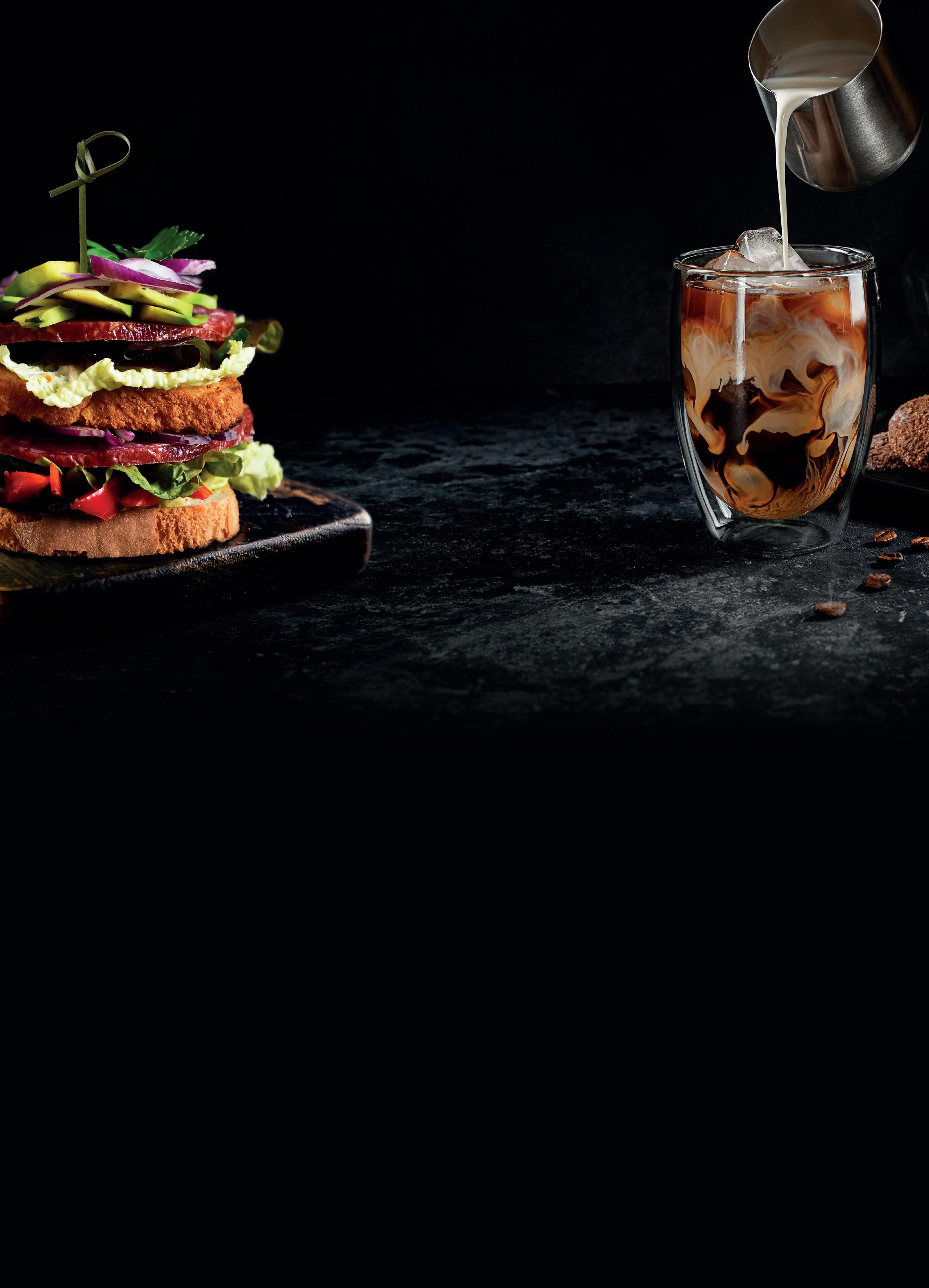

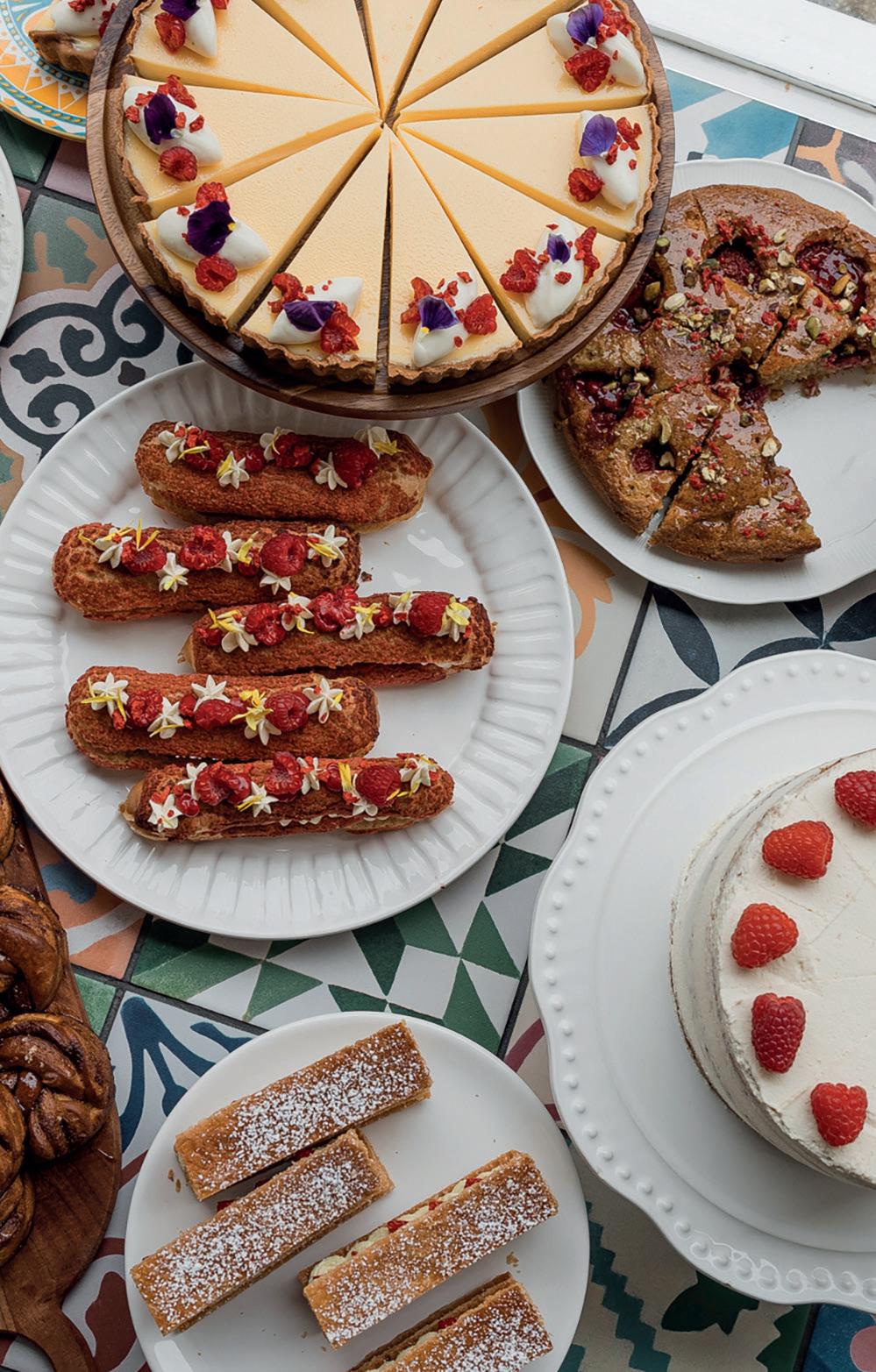
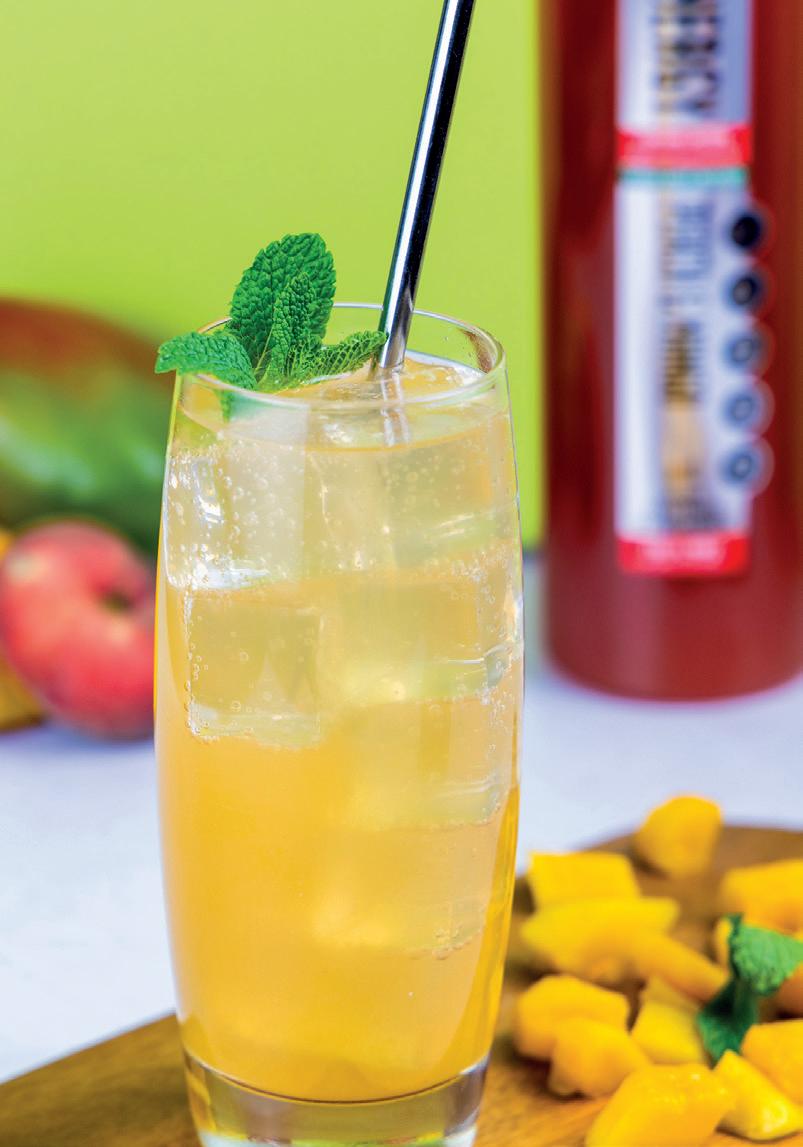





It’s Volume 8 in our continuing How to Start & Run a Coffee Bar series.
We’ve had so many inspiring contributions, delivering invaluable advice on the likes of the best machines, packaging options, branding and marketing, food safety, cold drinks, essential tips and so much more.
The role of the café in local communities continues to evolve – with expectations constantly changing. So, if you’re thinking of getting into the sector, I’m sure this publication has plenty to offer.
Enjoy and see you next year. Cheers!
Alex Bell – Editor
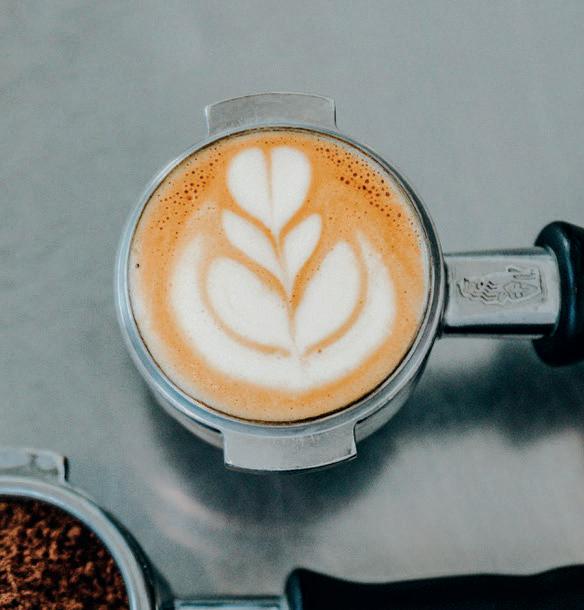


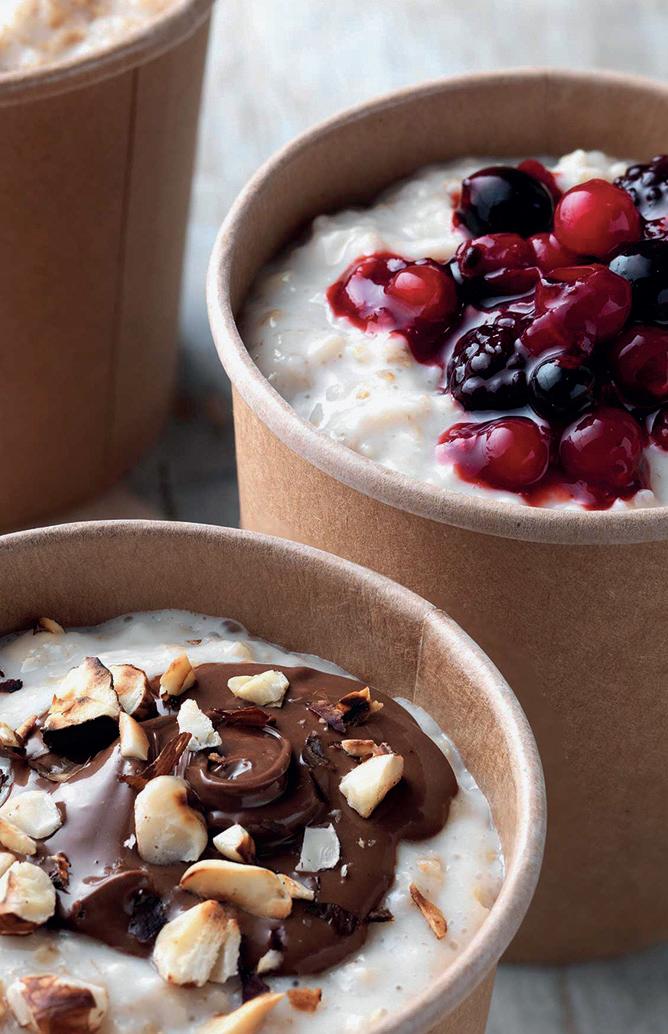


4-6 - Knowledge is power – Fracino
8-10 - Ten tips for success – Evoca
12-13 - Flavour at speed – Merrychef
16-17 - Getting the essentials right! – Beth Winters
18-19 - To have and to hold – Booker
20-21 - All about the vibe – Sabert
22-23 - Green fuel – Good & Proper Tea
24-25 - The beverage balance – SHOTT Beverages
26-27 - Magic of the message! – Ruth Wilson PR
28-29 - Labour of love – Ems & Co.
Editor Alex Bell, Tel: 01291 636349, email: alex@jandmgroup.co.uk
Advertising Paul Steer, Tel: 01291 636342, email: ads@thecafelife.co.uk
Production Gareth Symonds, Tel: 01291 636339, email: gareth@jandmgroup.co.uk
Subscriptions and Customer Service
Tel: 01291 636338, email: subscriptions@thecafelife.co.uk
Editorial Address Café Life, Engine Rooms, Station Road, Chepstow NP16 5PB www.thecafelife.co.uk
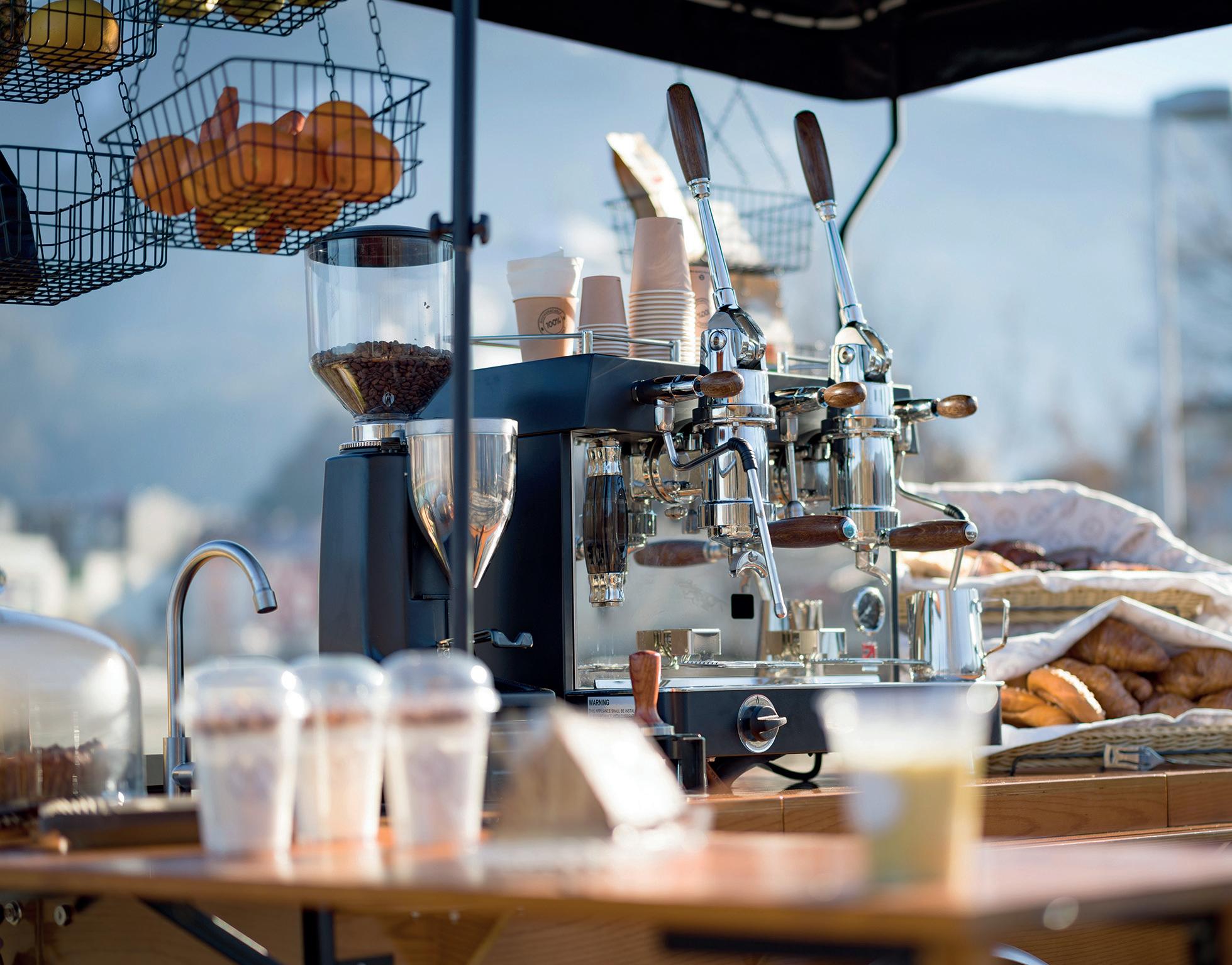
When it comes to expertise, there’s no one more ideally placed than Peter Atmore, head of global sales & marketing at Fracino.
What are the key considerations around that all-important machine?
Cost now, cost later, cost to change. What we mean is that every bit of equipment has not just an investment cost (we often call this capex) but an ongoing service/maintenance cost – and lastly a cost when you need to upgrade or replace. A fancy machine might not seem so bad at £6K or £8k, but if it then costs you £1K per year to look after and dies midway in year four, you’ve no, or very little equity after you’re £8500-£10,500 down. With Fracino, it’s more likely that at the end of year five you’ve spent around £6000 and still have a machine that will keep going for another few years. So, don’t max out beyond what you need to buy versus what you desire! Make sure you
have funds left for affordable service plans and that the tool you choose lasts many years.
Technology is advancing all the time –what’s exciting about machines?
Well, 2025 brings tech with smaller footprints, flexible power sources and greater automation choices. We know counter space is tight and retail rents by square foot, so we’ve made our systems work smarter and harder in smaller footprints – like our water boilers, for example. Also, if you want to operate in mobile or event spaces, several models in our range can be powered by either electricity or LPG bottled gas, so you can move around to where the customers are like never before. Think street food/food halls/
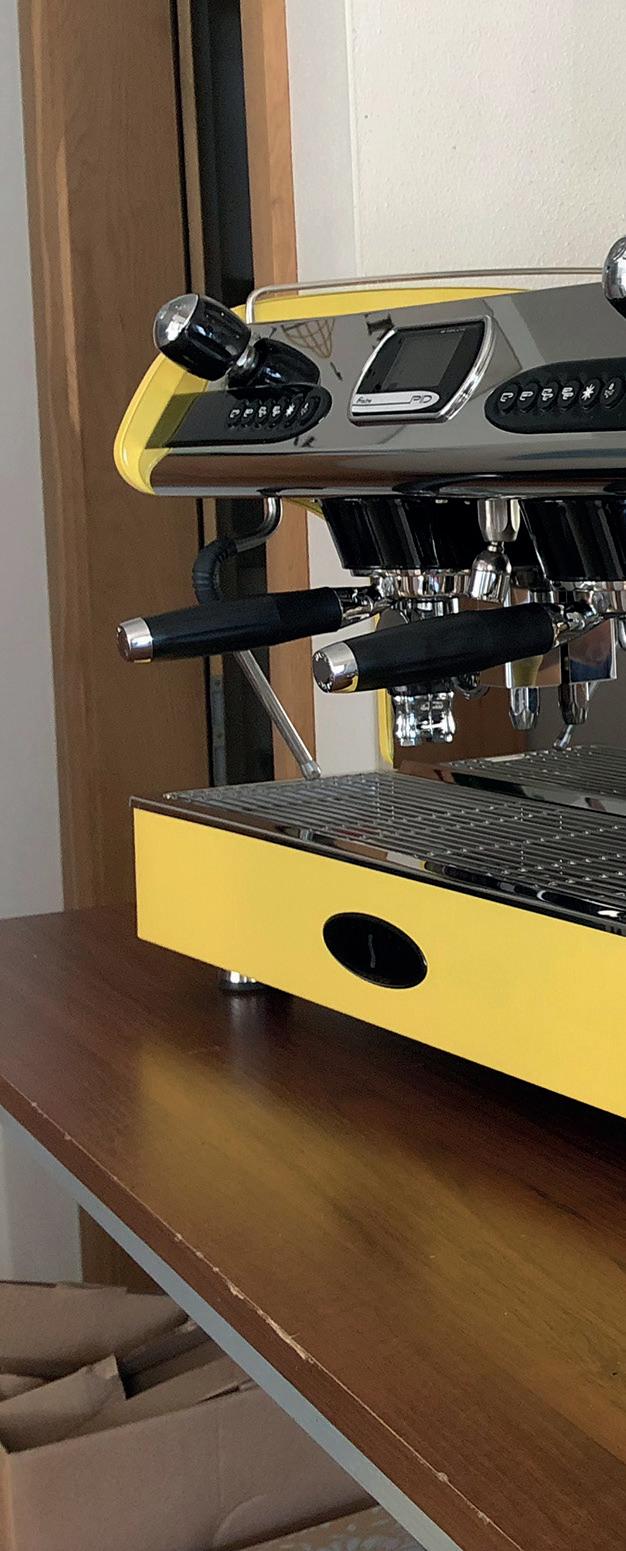
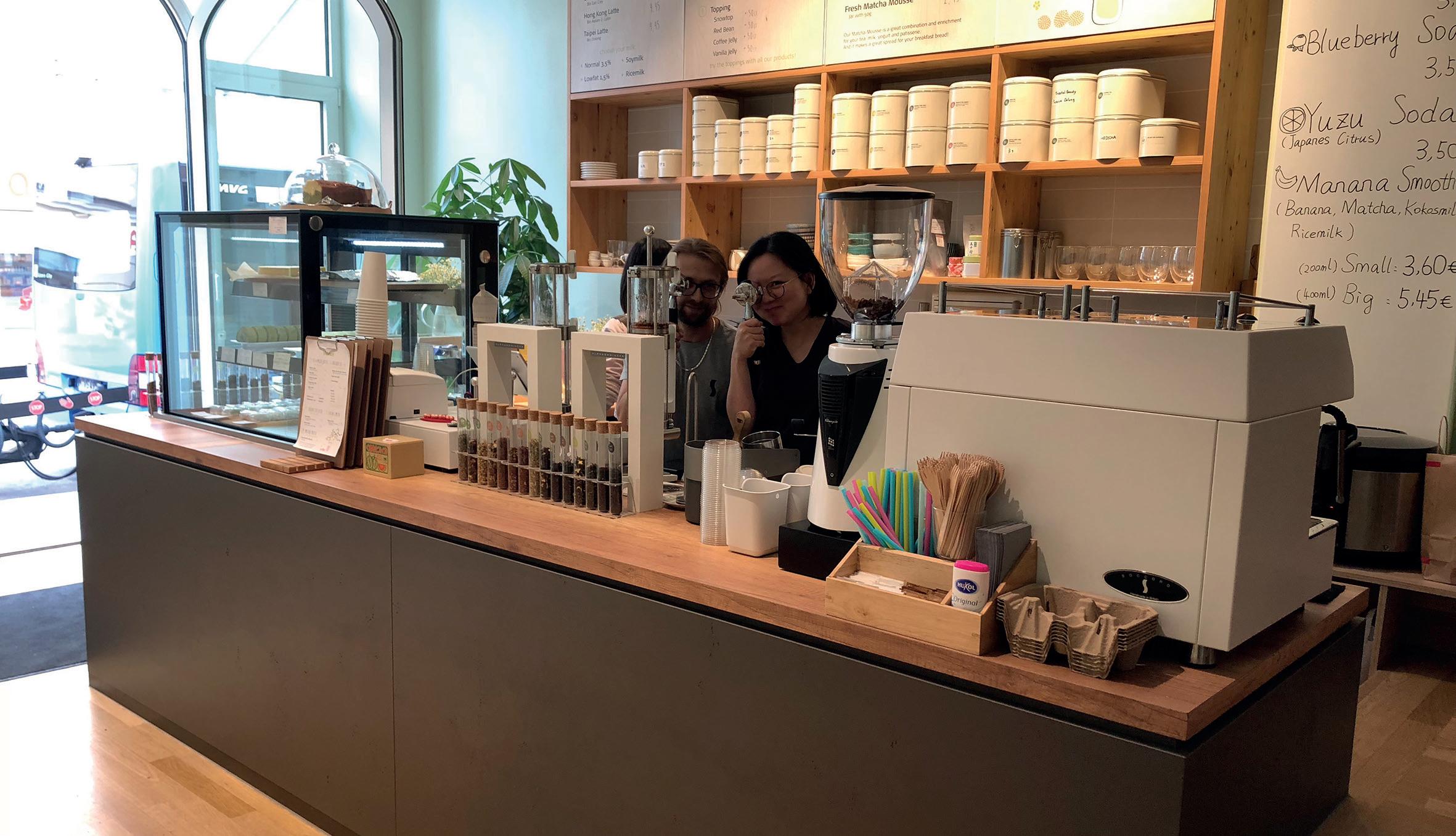
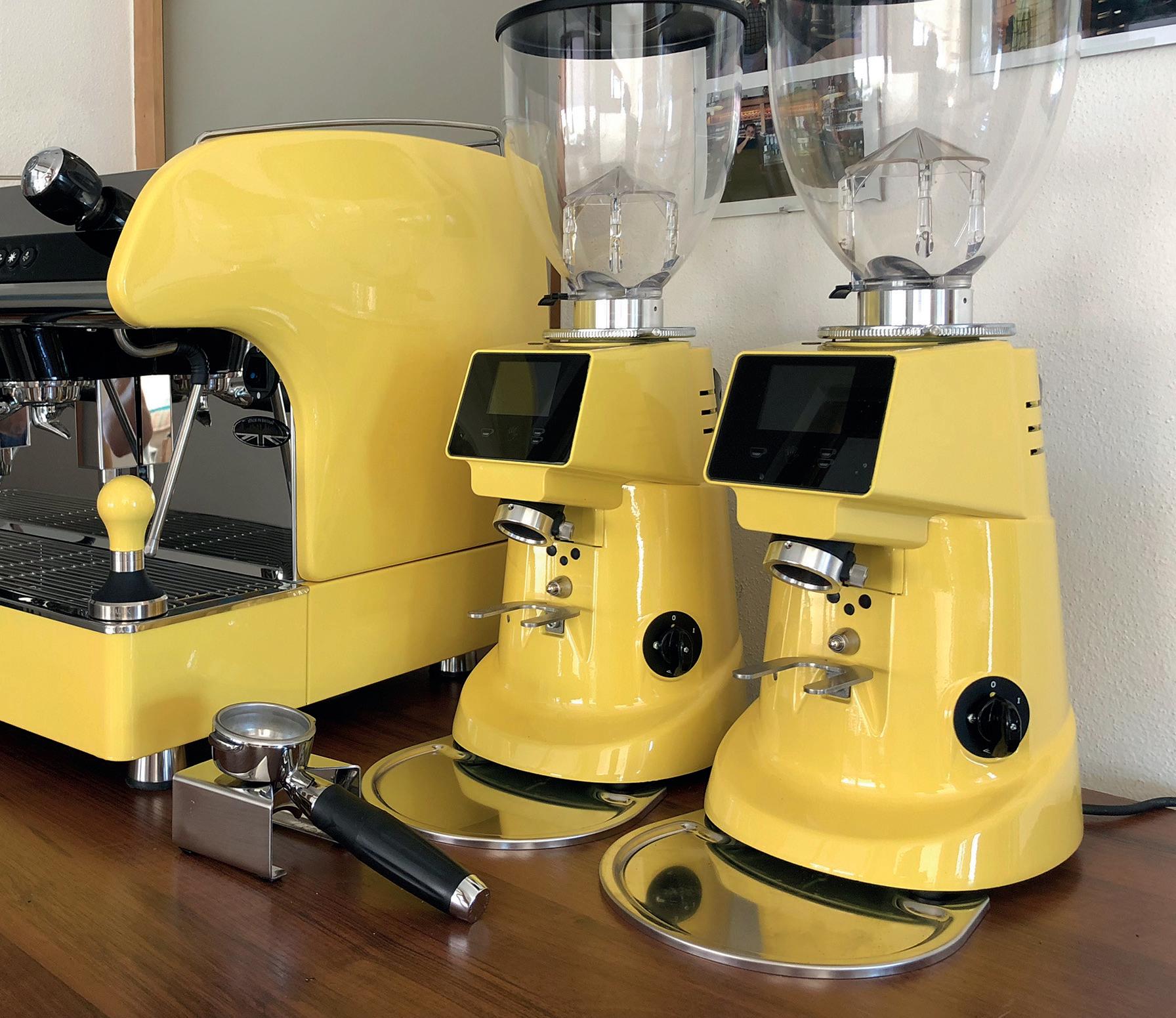
festivals – and this rising market is one we can help you prepare for. Lastly, automation. You want fast, efficient machines than can operate on skill levels between 1/10 and 10/10 – and we’ve invested in a solutions range, with new models to be launched shortly. You don’t need to recruit skilled baristas at top dollar… we can show you how to make all your drinks simply, with minimal training.
What are the Fracino options for smaller and medium-sized cafés?
Our traditional contemporary, angular design with a highly polished stainless steel finish is being enhanced to make a statement. Our Romano-R and Romano-PID models visually engage both customers and baristas, while
using pre-proven technologies to guarantee high-volume capability. Incorporating multiple colour finish options, consistent brew temperatures for perfect flavour extractions and fast/ quiet on-demand grinders, the range is a design statement and a powerful servant. The R’s touchscreen, electronic trace icon drink selectors give them ‘heart and soul’, and machine turned, wooden steam valve handles deliver a premium finish that conveys quality and exclusivity. Yet, this package still comes with the Fracino DNA of reliability, affordability and durability.
How important is the barista – and has the role changed in recent years?
The barista is very important; their engagement with the customer forms
a vital part of the service experience. However, we want them to be able to engage meaningfully, bringing value to that interaction, making the machine operations both simple and smooth. Now, they can talk about the coffee origin and roasting process, or recommend a drink choice for both a confused or adventurous customer. We want to leverage their passion and knowledge to drive average transaction values and increase positive online reviews. Our easy-to-use tech gifts them the time to deliver these growth goals.
How can new businesses approach the sustainability question?
Be focused on the manufacturing process and life cycle of equipment.
Ours is an open book, with recent improvements in our factory demonstrating zero-waste tolerance where all production waste is recycled or repurposed. The way we make the machines, using solar-generated electricity from the factory roof, also facilitates ongoing refurbishment for 10 years or more, meaning they don’t end up in landfill and almost zero plastic means any eventual metal scrap can be smelted at end of life. When they do reach that point, minimal use of plastic or other non-recyclable materials ensures that we can offer an environmentally sound complete dismantling and recycle facility.
If you’re telling a story about sustainable farming or recyclable packaging, it makes perfect sense to explain that you’ve extended your philosophy to the physical resources in your business. Customers who care will appreciate the depth of your commitment and how your low carbon footprint and local sourcing is also supporting the British economy versus always importing goods at great environmental cost.
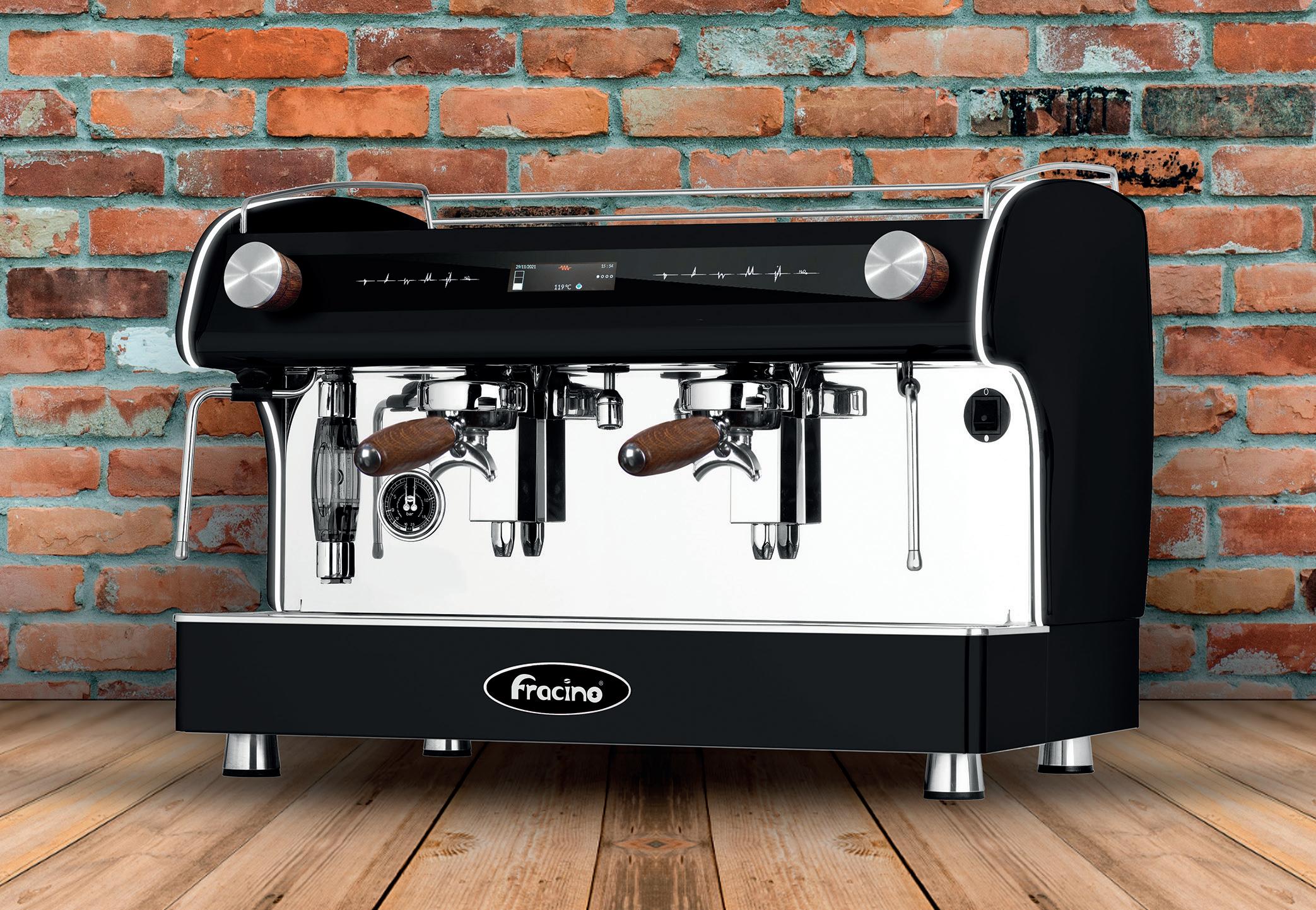
What trends are you seeing?
Iced drinks are screaming up the sales charts. Everywhere should have credible variants – and your menu choice of tea and hot chocolate, plus chai and maybe Matcha, should additionally excite customers and reflect more than what they can rustle up at home. Fortunately, with our ice machine range, we can guide and support this trend, making sure new operators avoid pitfalls. Drink presentation, style and feel are driven by trends that often start on social media – follow leading-edge menus
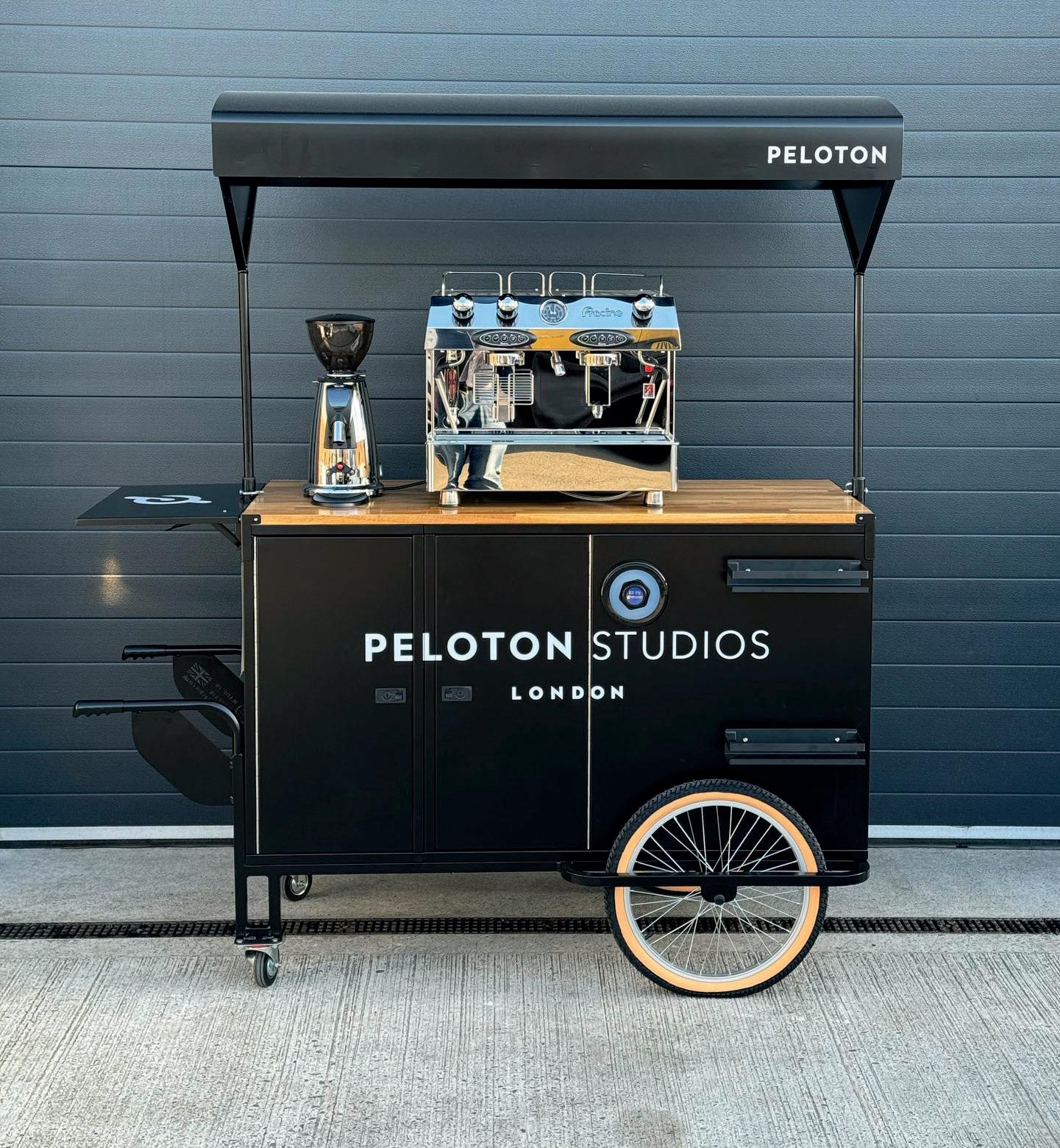
and reflect with your own teams how you might emulate that action!
While big-name coffee houses are everywhere, what’s your advice to the smaller businesses?
Focus on your story, your people and the things you are proud of. All the chains are clones; you are unique, special and select! Celebrate that and learn how to leverage it. Nail a few signature drinks that you know you can do well. Appreciate and reward your customers, get to know them and build messaging and socials around people enjoying your offer – this creates positive energy your operation needs. Continually review and enhance your menu; don’t be afraid to remove slow sellers or try something new. Educate and excite staff so they always know what to recommend and how to ensure their production standards meet yours. Consistency and quality are the buzzwords! Create a strong people culture and your staff will recommend you as an employer, saving you recruitment headaches –plus, they’re likely to stay longer if they feel valued and fulfilled at work.
And find a local coffee roaster with a good reputation, alongside a local engineer that gets good feedback.
Buy equipment that you know is still going strong five years later in places that you can visit. Let profit be your sanity and stay grounded in the money you lay out at the start, knowing there will be challenges ahead. Plan for the long term and make informed sensible decisions with help and input from people you trust – which we’ve earned at Fracino over many years.

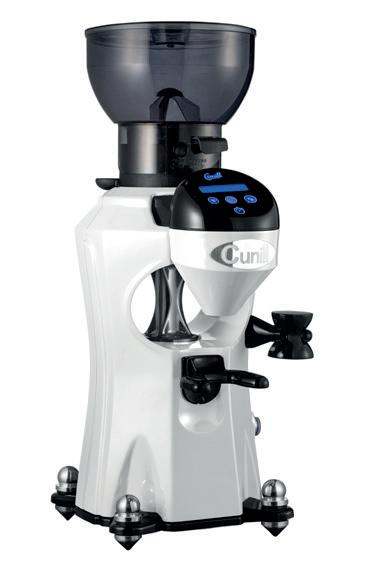
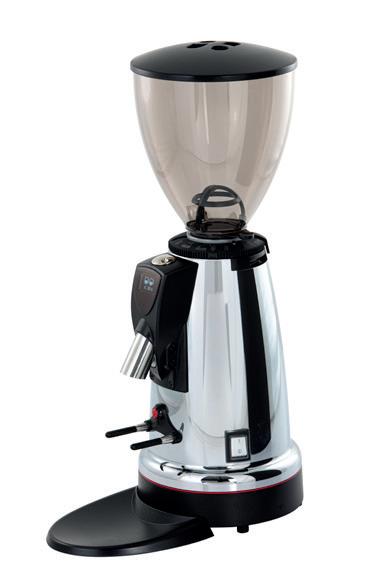
An extensive range of Grinders to suit every venue and user preference..... Stylish Design? Quiet Operation? Easy To Use? Touch Control? On Demand or Dispenser? There's a model for you here!
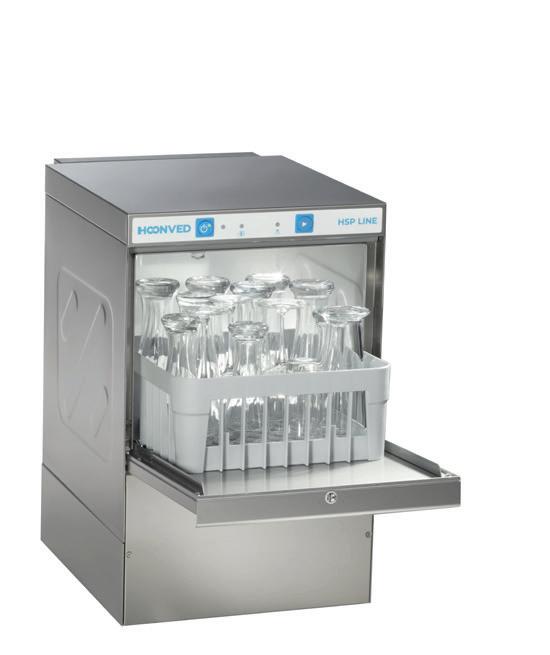
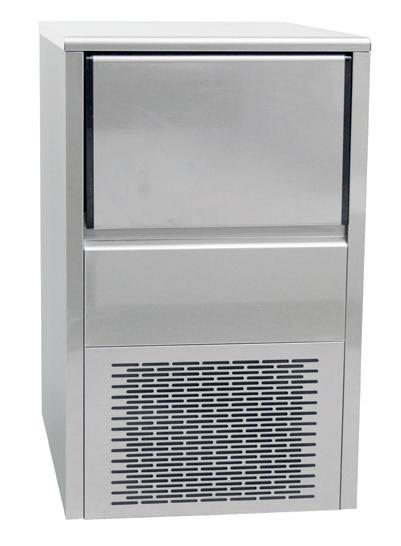
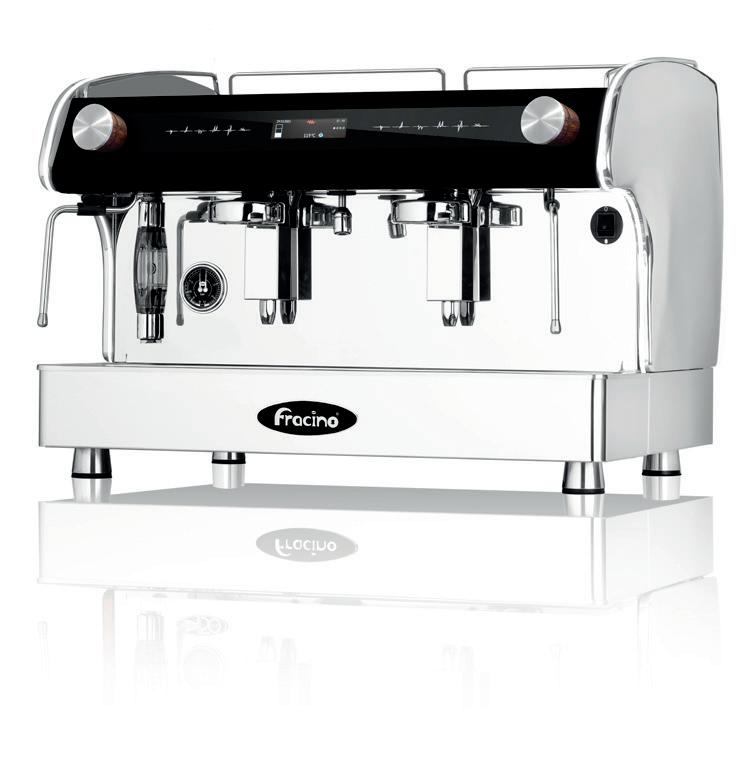
The touch - panel Romano-R model with real wood handles and led edge lighting reflects a modern interpretation of style that makes for a stunning, yet timeless focal point in any coffee bar or restaurant. The highly polished stainless steel finish looks awesome from every angle!
Our range of Glass & Dish Wash Equipment and Under Counter Ice Makers are designed to fulfill the demands of all coffee bars - large and small.
Powerful, reliable and compact, they surpass at performing the menial tasks they're produced for - year in, year out!





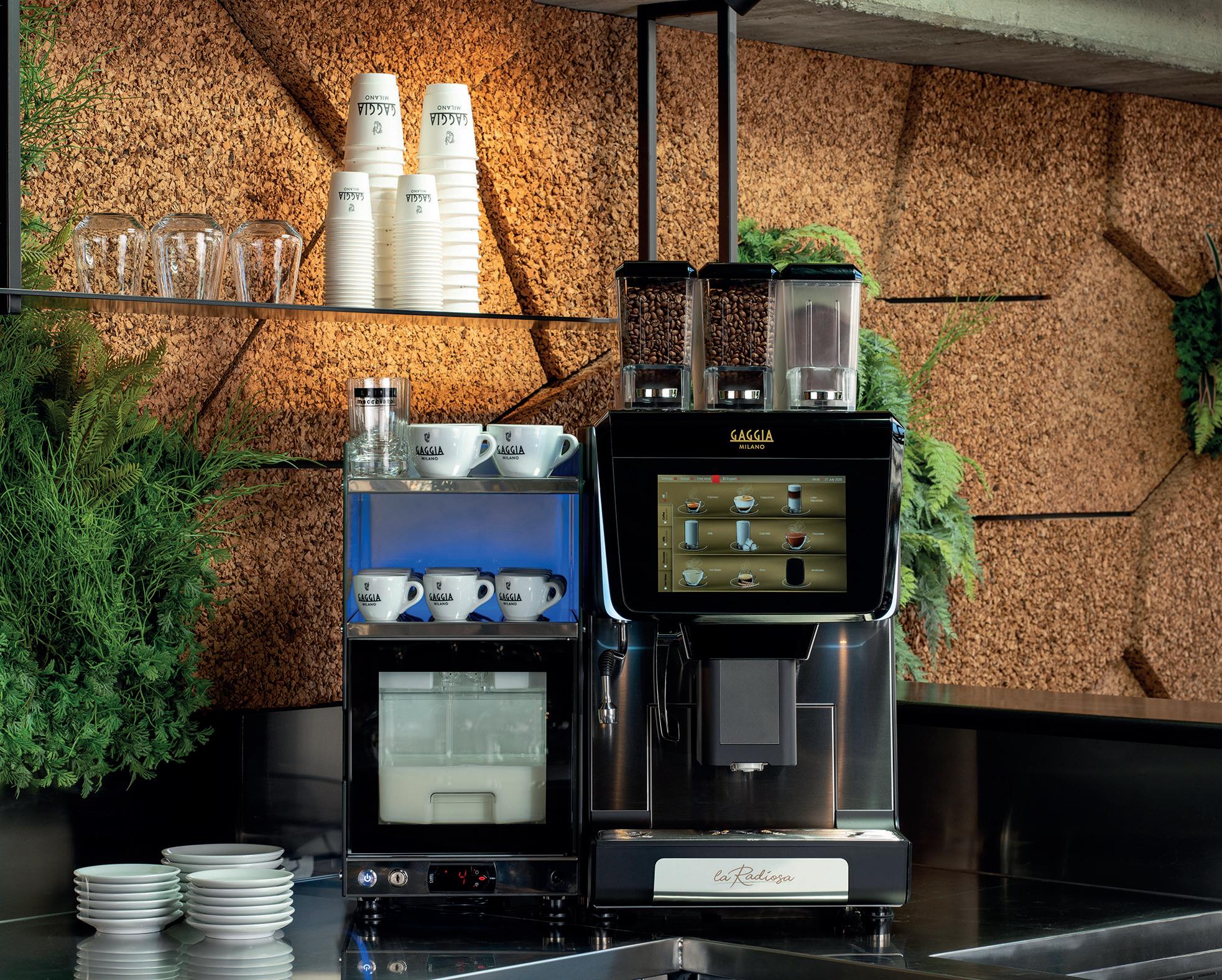
When it’s been a long-held ambition to open your own coffee shop, your choice of coffee machine is one of the most crucial decisions. The style, design and manufacturer will all make a statement to customers about your brand. It’s not easy, as there are many different options on the market. So, sales director for the Gaggia Professional brand in the UK, Andrew Barrow, has put together an invaluable checklist to steer you through.
1 Machine technology
Firstly, you need to decide the degree to which you want your machine to automate the process.
At the top end of the scale, premium traditional espresso machines, such as Gaggia’s La Reale with Dynamic Flow Control, enable baristas to fine tune every element of the extraction – totally relying on the barista’s craft to deliver the flavour profile. For the expert barista, this offers the best option to showcase your craft.
Alternatively, mid-range espresso machines – such as the La Vetro, to be launched in late 2025 – offer a more cost-effective option. As with all espresso machines, it can be programmed in such a way that allows the barista to focus on serving. There is also the fully automated option. These are ideal in self-service or quick-service locations but shouldn’t be discounted in any situation – fully automatics hold many advantages, including delivery at the press of a
button. And not only coffee but also hot chocolate and sometimes iced drinks. In a nutshell, they are basically baristas within a box. Providing it is installed well and calibrated to dispense a beautiful espresso, it will do this time and time again.
The mid-way solution would be a La Radiosa Power Steam. Arriving in the UK in late 2025, this crafts the espresso automatically but allows baristas to foam the milk manually using the integrated steam wand. There are three
milk settings – giving baristas the ideal temperature and consistency for flat whites, lattes and cappuccinos.
How many coffees do you think you will serve? A small one-group machine may be sufficient. However, if you have more than one barista, or anticipate a need to make more than two drinks simultaneously, a two- or even threegroup machine is a better investment. At start-up, you may be tempted to go small but if you outgrow it quickly, it may cost you more in the long run. Ensure that you choose a machine capable of serving the expected volume of coffee required during busy periods. One that’s too small or slow will lead to longer wait times and frustrated customers.
Your counter space is all-important. It needs to accommodate lots of items – from cakes to the cash register, and all manner of ancillary items. Once these are taken into account, you can determine what size of coffee machine will fit – and don’t forget the grinder, if you go traditional. It’s important to factor in all variables from the outset.
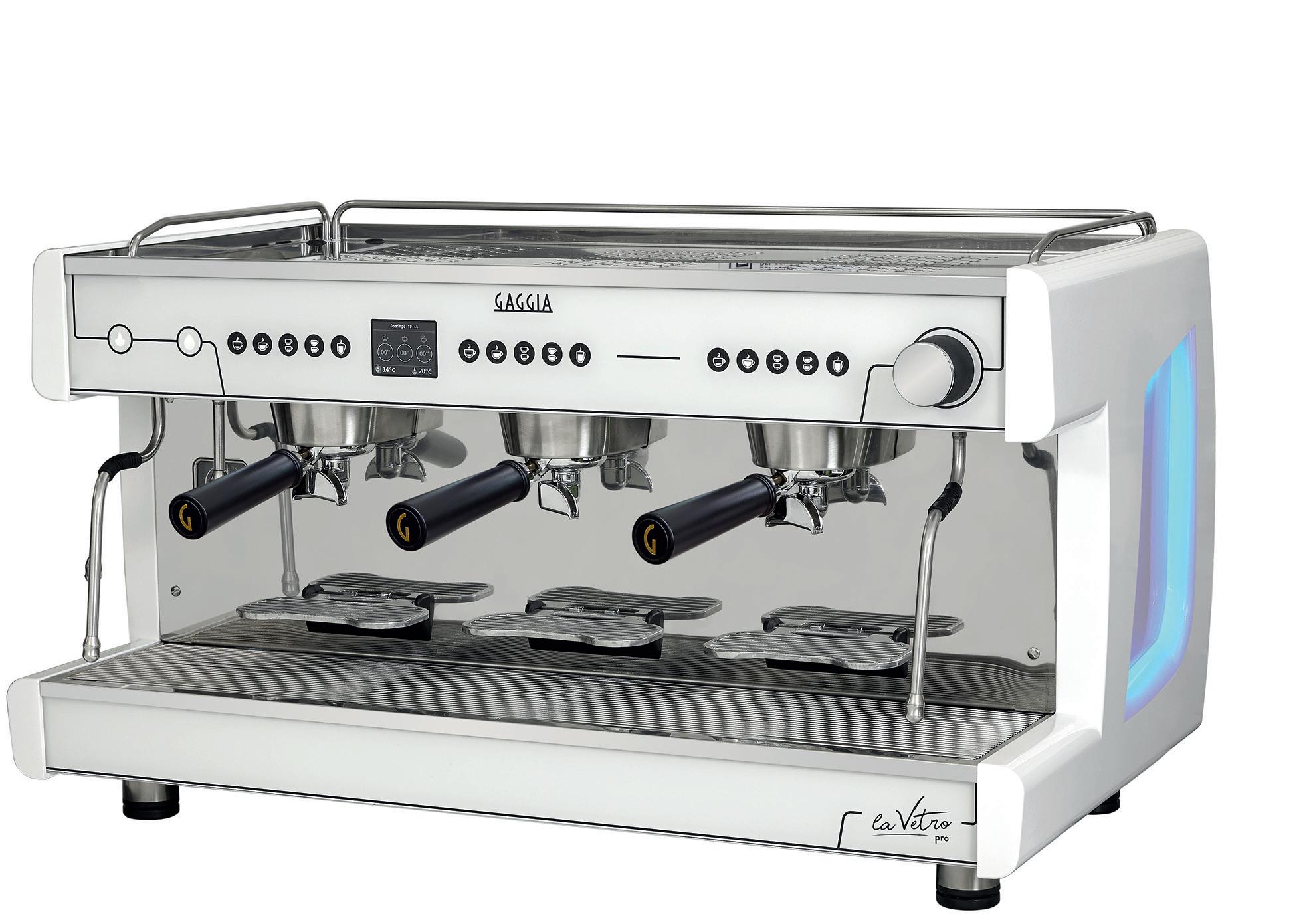
Gaggia’s range of fully automatics foam or steam the milk, giving you texture that closely resembles hand-crafted drinks – just without the latte art. At the other end of the spectrum, traditional machines enable baristas to texture the milk and use creative flair to add latte art. However, even certain traditional machines offer a degree of automation on the steam wands – guaranteeing temperature and consistency. There is no doubt that alternative milks are here to stay. Either as a lifestyle choice or result of lactose
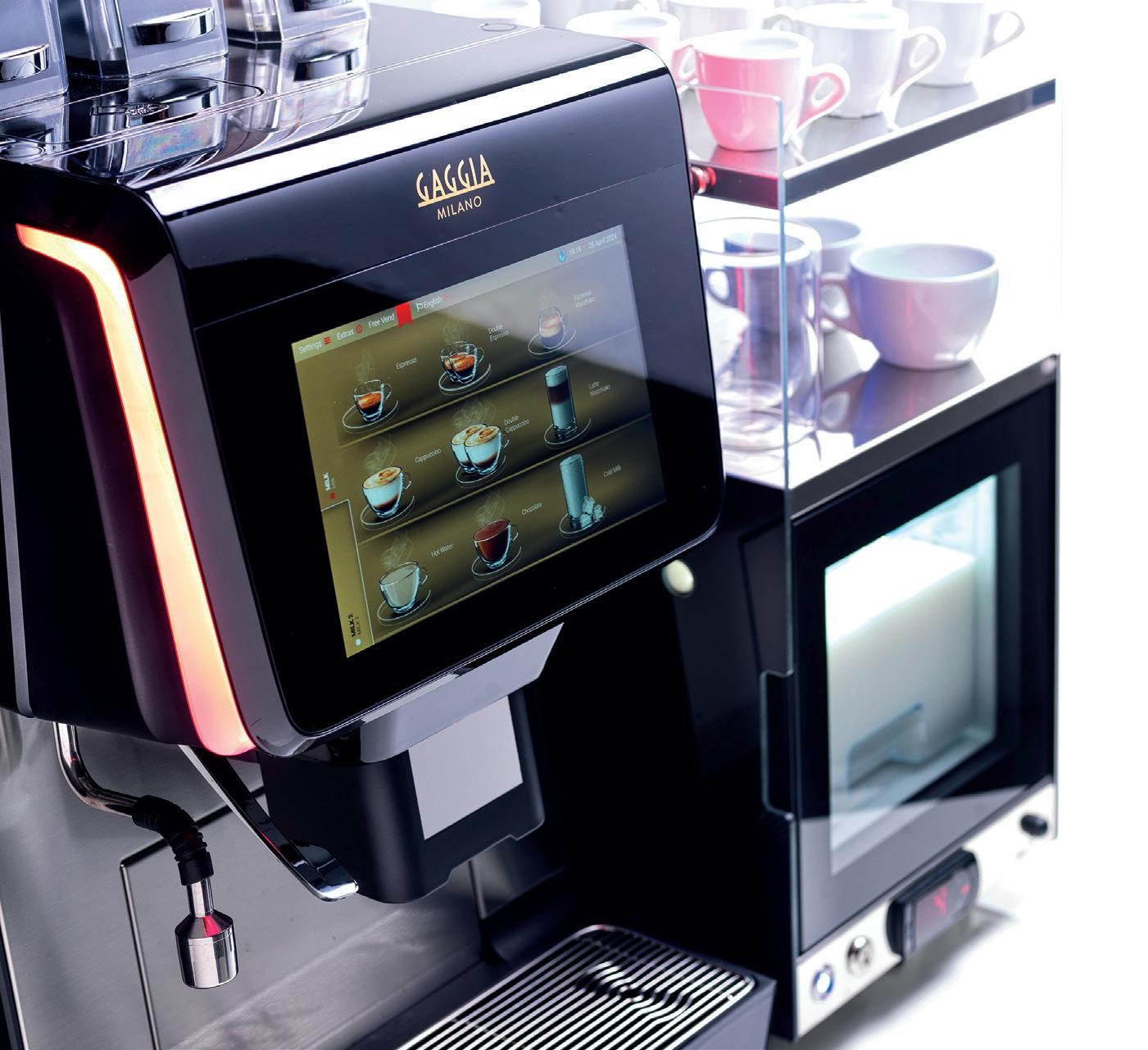
intolerance, sales of plant-based milks are increasing rapidly, as are the number of coffees made with nondairy milk. Options include almond, coconut and soya, among others, but the most popular remains oat – both for its flavour and foaming properties. Different machine types enable you to handle multiple options in different ways. For example, steam wands on traditional machines should be cleaned and purged between each use, enabling you to handle a variety of milk types. Gaggia’s La Solare is also fitted with a steam wand – for manual steaming. This system is completely independent of the milk that comes from the machine fridge, and is one way to offer two different milk types. Gaggia’s La Radiosa Dual Milk caters to a lifestyle choice that incorporates plant-based milk – a split canister container in the machine fridge can hold both types and an unlimited menu option, ensuring a seamless drink selection process by the barista.
As we’ve alluded to already, fully automatic machines take away the necessity for barista training. This can be a significant advantage if staff turnover is high.
On the other hand, traditional machines consist of fewer moving parts, so are less complex pieces of equipment than automatics but require a greater level of training. A good understanding of calibrating a grinder and measuring an espresso dose are
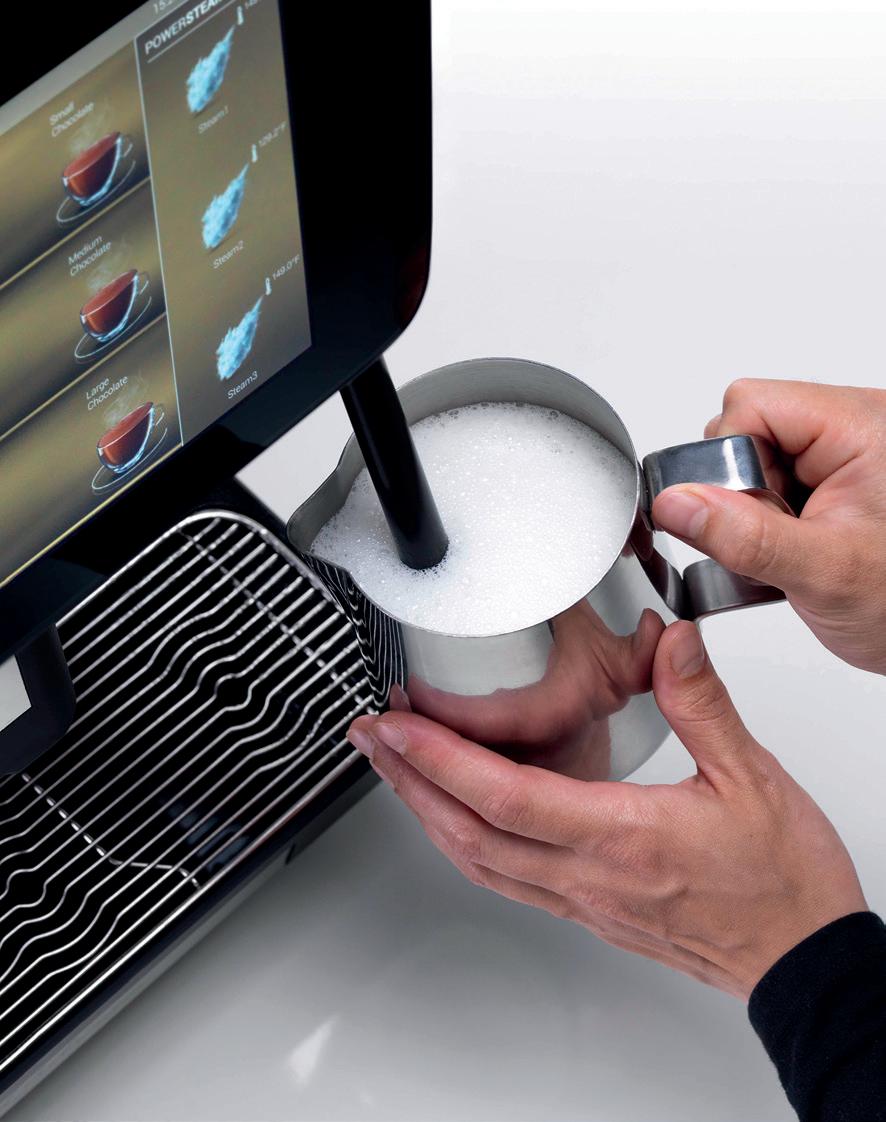
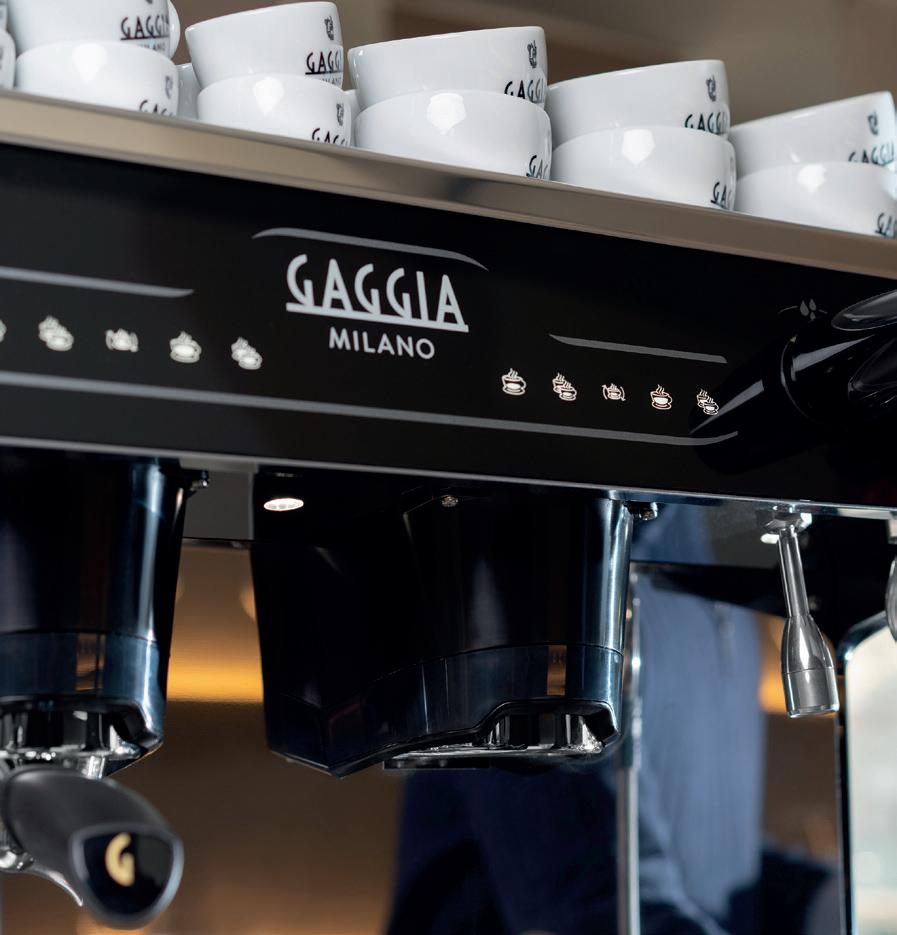
The Gaggia Professional brand is manufactured by the Evoca Group –a global leader in professional coffee machines, with branches around the world. This gives us extensive experience in manufacturing and gives café owners the option of any type or size of machine from a single brand. Combine this with the history and legacy associated with the Gaggia name, and café owners are assured that they are working with a brand that fully understands what baristas need from their most vital piece of equipment.
also fundamental to taste. With a traditional machine, baristas need to understand how to set up the grind, extraction, and how to steam milk to the correct texture. However, where coffee is the essential component in your business, the theatre associated with hand-crafted drinks is likely to be what your customers expect, so it’s worth the investment in training.
All machines require this regularly, including daily cleaning. A failure to maintain can lead to costly downtime and repairs. Invest in a machine that has easy access to parts and choose a reputable service provider with manufacturer-trained engineers that can assist in the event of a breakdown. A daily clean is crucial for hygiene and performance, but back flushing the group heads with a cleaning tablet should not take any longer than consuming your coffee, while automatic machines offer automated cleaning processes and daily reminders as part of the software program.
If your business is about serving coffee, your number one priority is delivering the best you can. The vehicle for achieving that is the machine, so it’s the most important piece of equipment. That said, budget constraints are clearly a concern. Leasing options can help spread the financial burden – many stockists offer this. The
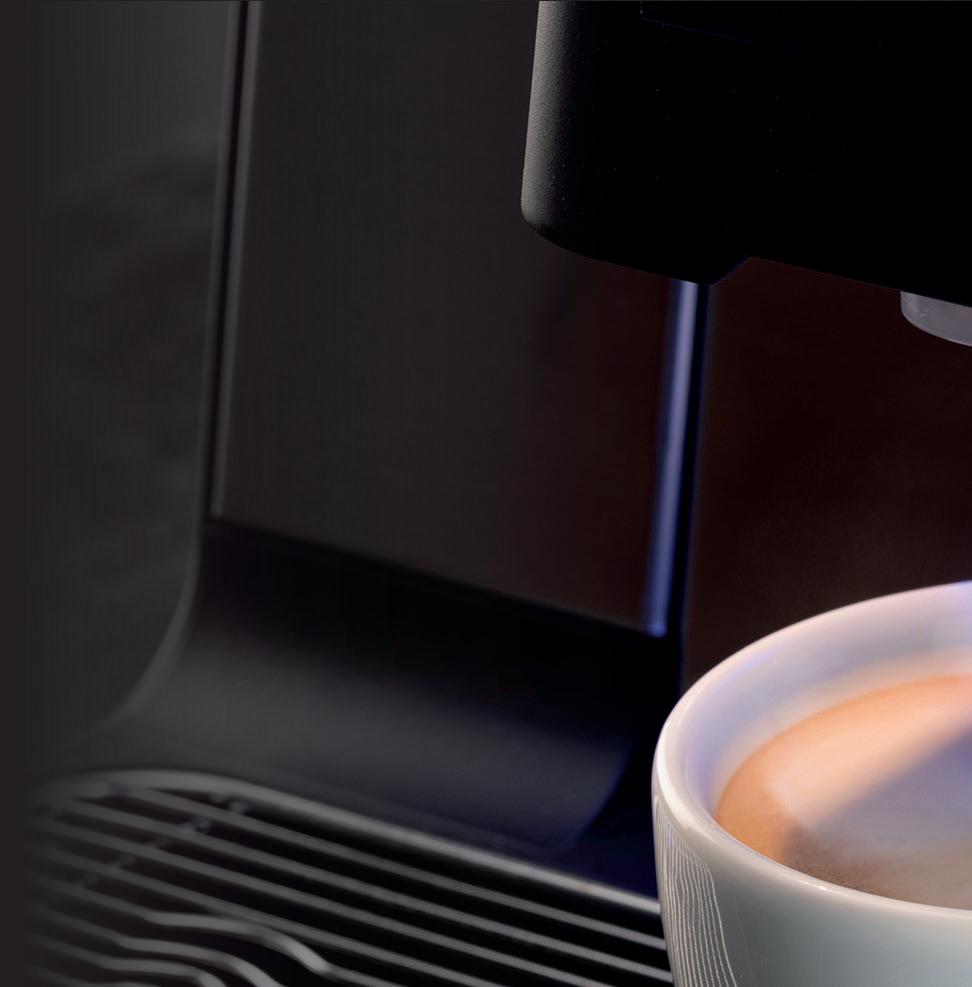
advantage with a Gaggia machine is that while they offer the full range of functions that you would expect, they do so at a more advantageous price point than many other brands.
Don’t select a machine based solely on looks. While appearance matters, especially if visible to customers, it should not come at the expense of functionality. But the design does need to suit the overall ambience – and the Gaggia range is imbued with Italian style, alongside a range of features.
Choose the best ingredients you can afford, and the most crucial is coffee beans. They are a consumable product and have a life span once removed from packaging. The rule of thumb is never overfill the grinder or bean canisters, as while the beans are exposed to oxygen they degrade in quality. Store in a cool, dark place and away from natural sunlight. Do not put beans in the fridge, as they absorb the natural smells and tastes of other items.
Don’t forget to factor in power requirements. If it requires 3 phase power, for example, it will be much more cost-effective to have it installed during your refit than at a later stage. The worst time to realise that you don’t have enough power is as you are scheduling the machine installation.
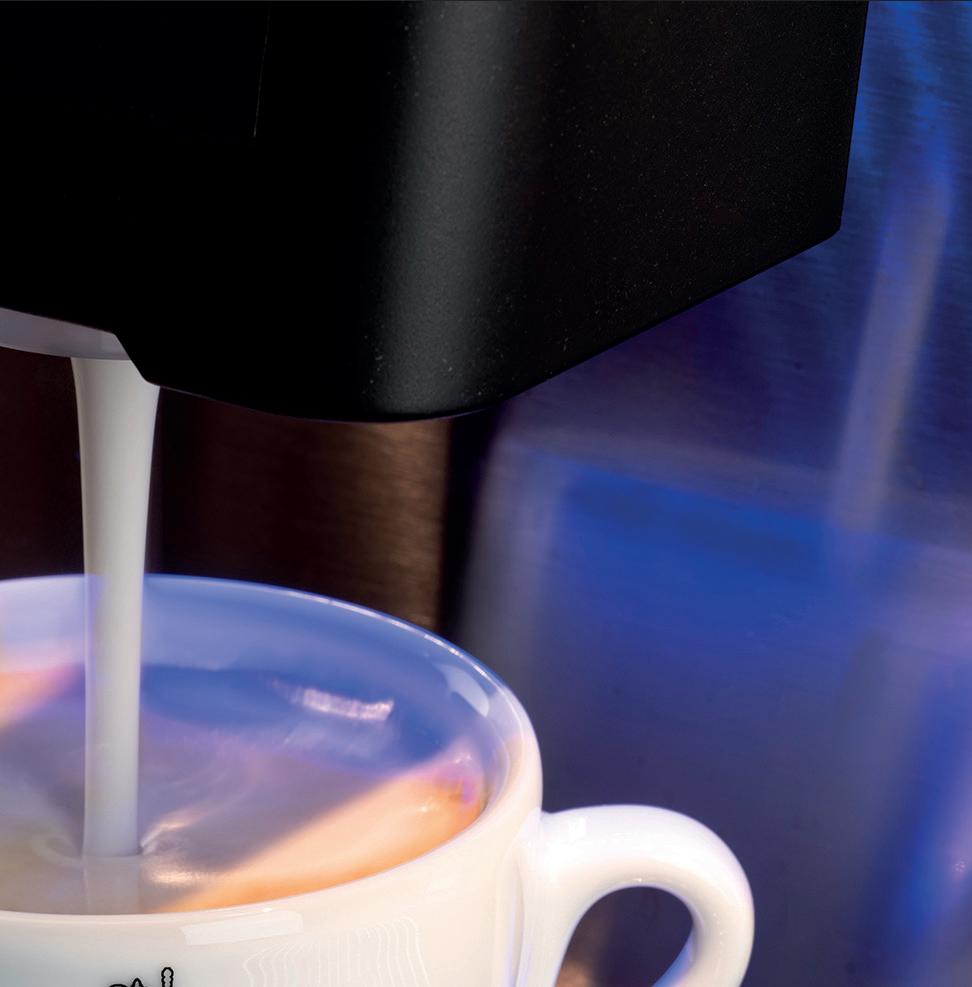
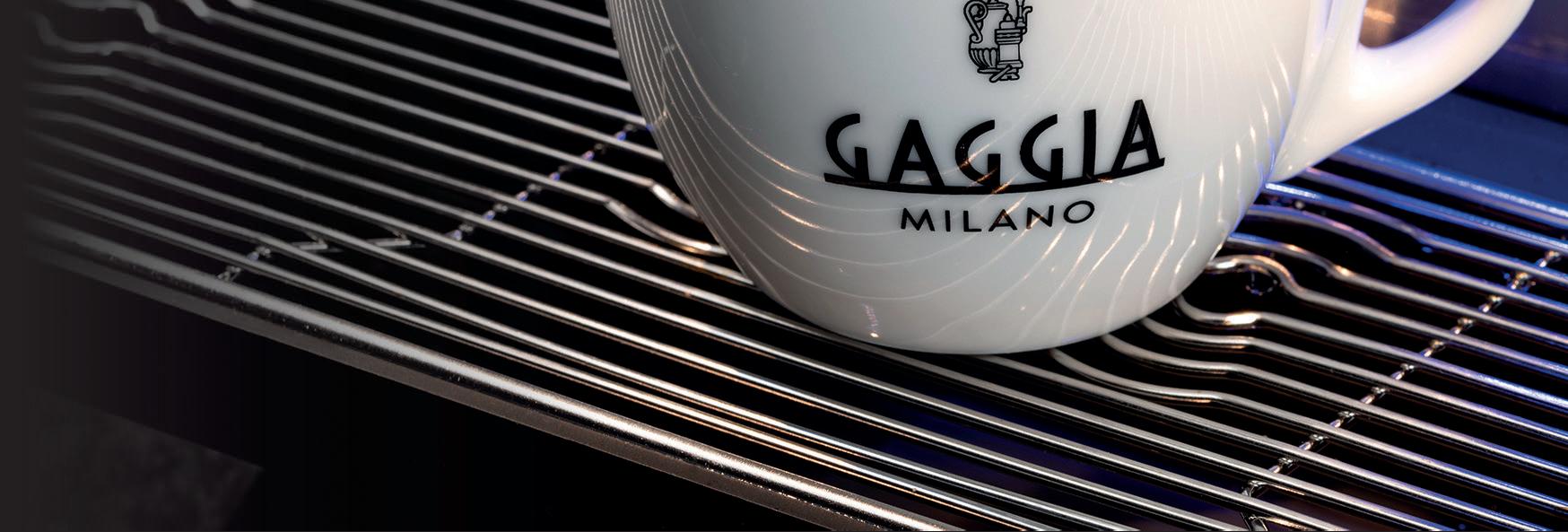


GAGGIA MILANO
Est’d 1938
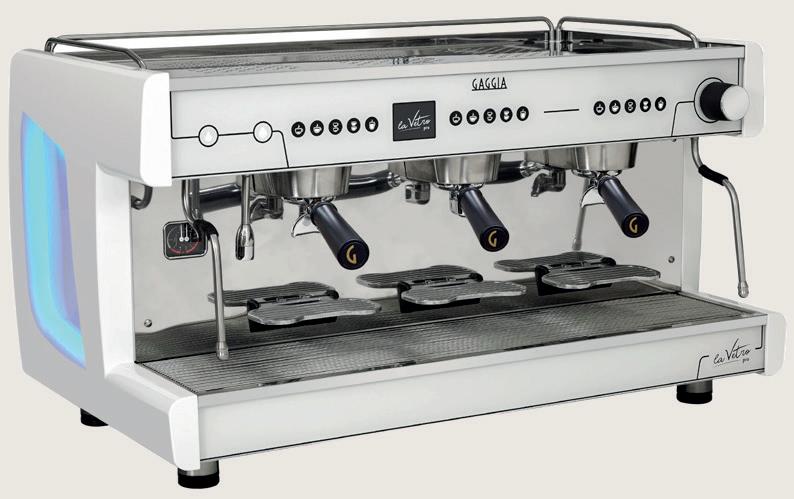
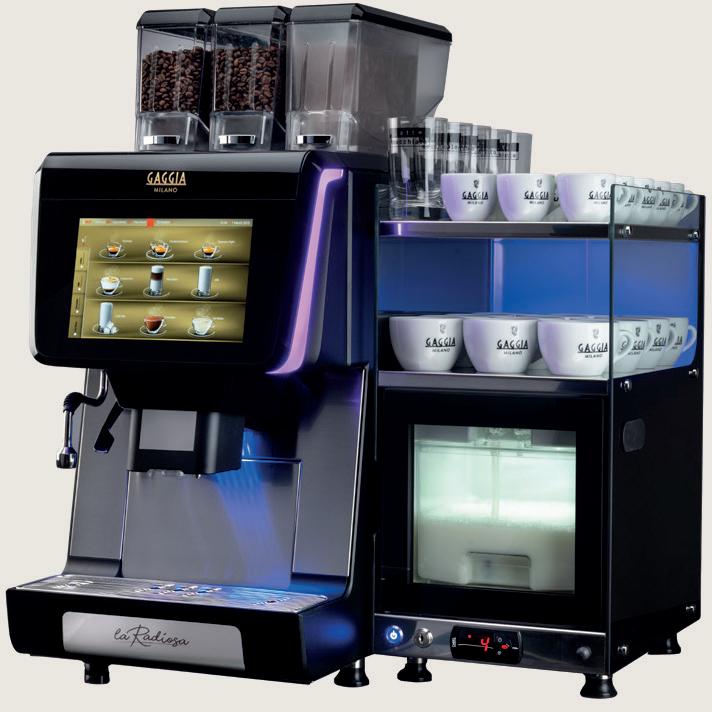
Gaggia’s heritage dates back to 1938, when Achille Gaggia’s ingenuity — and his pursuit of the perfect crema — transformed espresso in Milan.
Now, we help people around the world make the finest coffee.
Gaggia’s traditional espresso machines build on the heritage of our founder with designs that catch the eye and cutting edge technology.
Meanwhile, Gaggia’s automatic coffee machine, La Radiosa creates a foam that any barista would be proud of, and will produce a huge range of barista-quality drinks - ideal for served and self-service environments.
Let curiosity lead you to something extraordinary... Get in touch today.
BARISTA STANDARD DRINKS CONSISTENTLY GREAT COFFEE COMPLETE PEACE OF MIND
THE ART OF PERFECTION
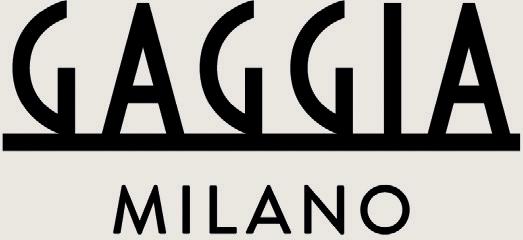
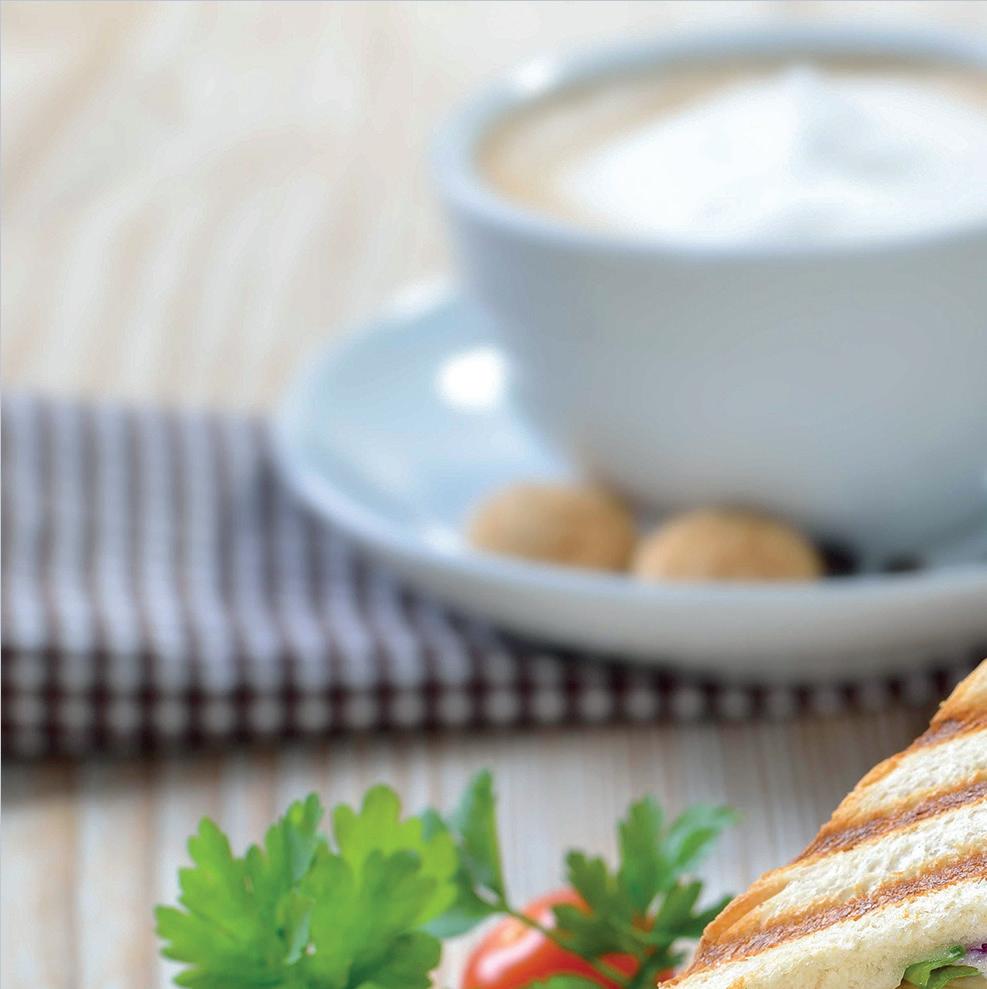
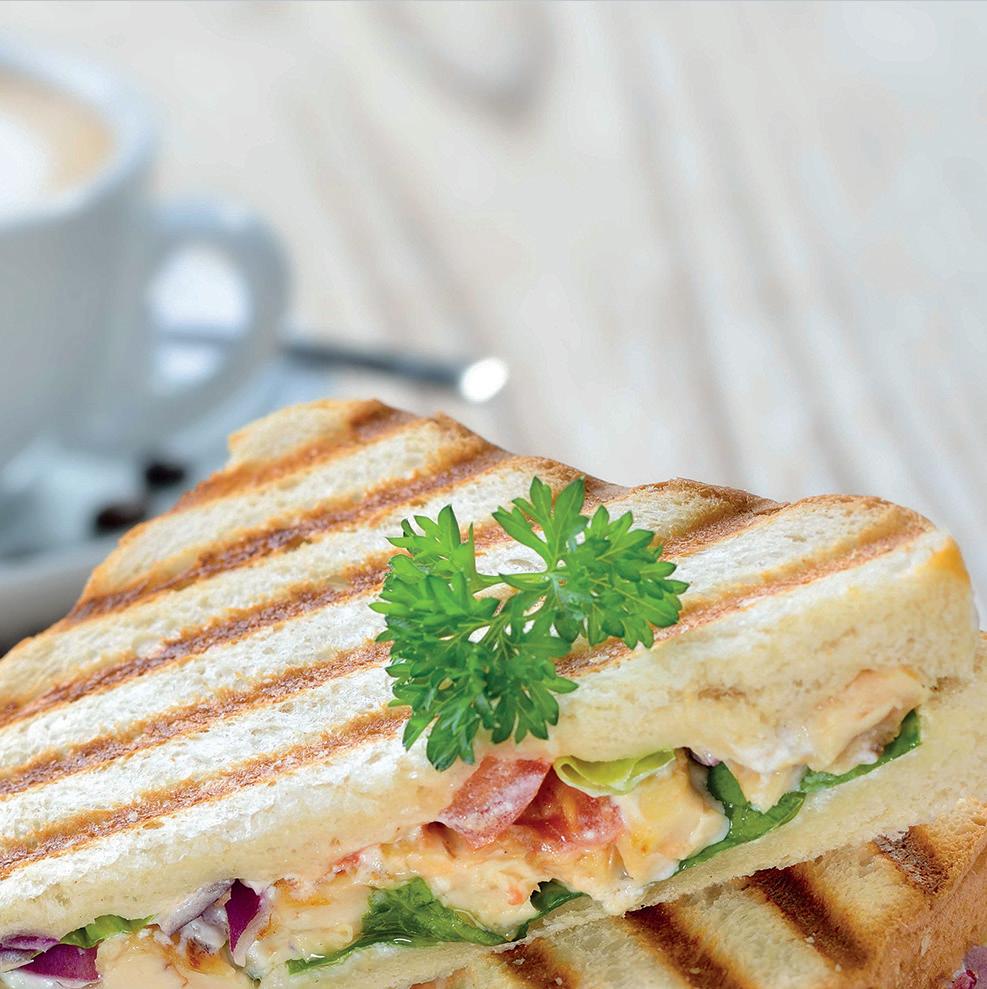

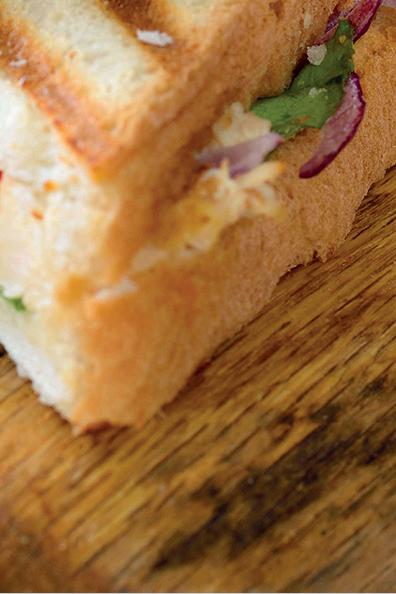

If you’re seeking versatility and space-saving equipment, the Merrychef conneX® oven range could be the ideal choice.
The decision around hot food is crucial. While you need to consider trends and what’s going to increase footfall and loyalty, the practical elements are just as important. What equipment do you need, how much space will it take up and how easy is it to operate?
Well, whether starting out with snacks or cooking traditional British fare, Merrychef conneX® high speed ovens have an impeccable reputation.
With staff recruitment a big issue, it’s a priority to have equipment that can be used by any team member. The 7” HD image-based touchscreen is as straightforward as a mobile phone, and
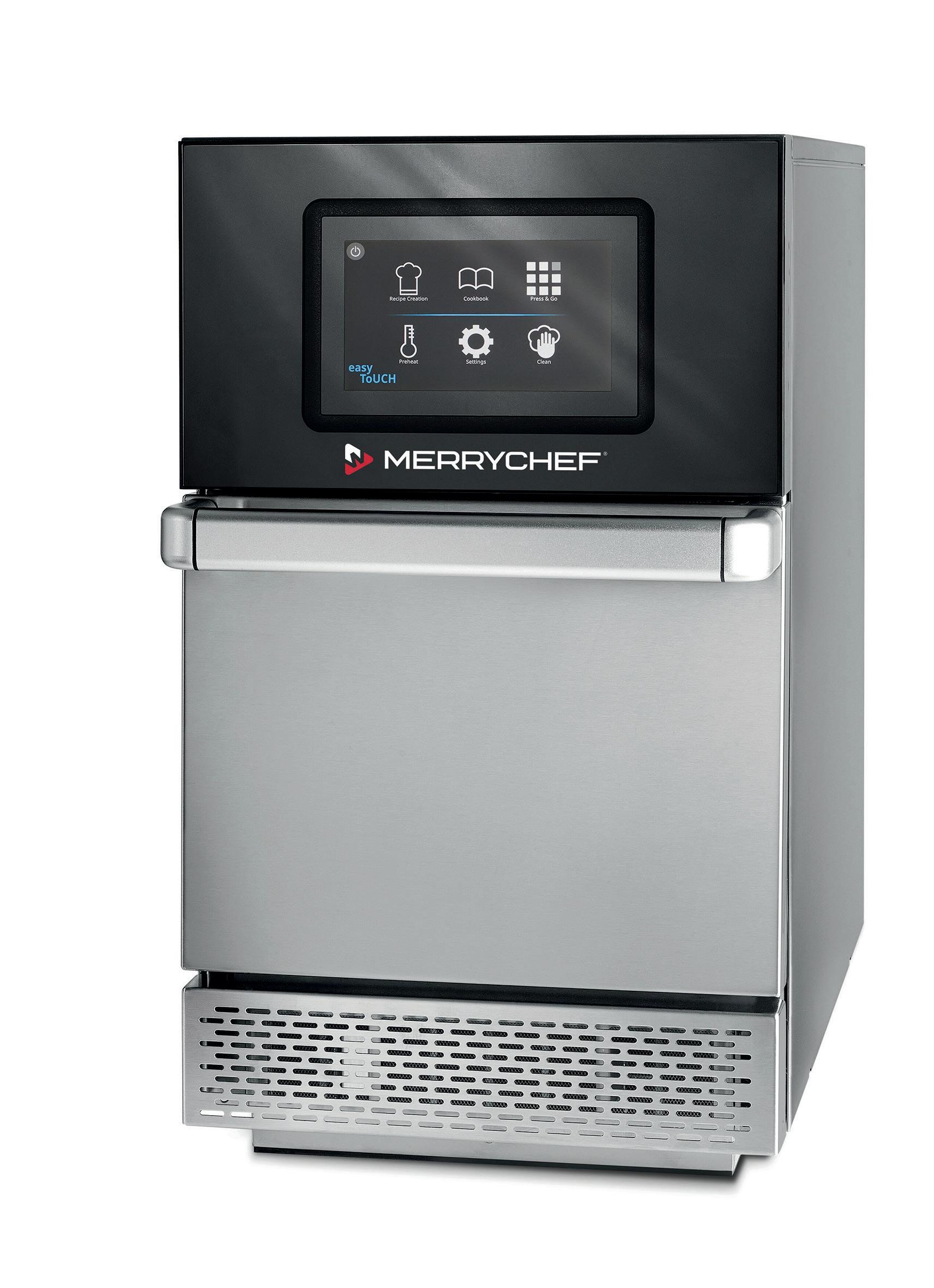
along with over 100 pre-programmed recipes, you can quickly deliver consistent results with every order.
Perfect for the smallest of kitchens or front of house, the Merrychef conneX® high speed ovens are quiet, compact and fast: they speed up service and ensure that every item is cooked to perfection every time.
This premium equipment also frees up kitchen space by replacing a microwave, toaster, sandwich press and oven. Thick-cut chips ready in three minutes, mac & cheese reheated
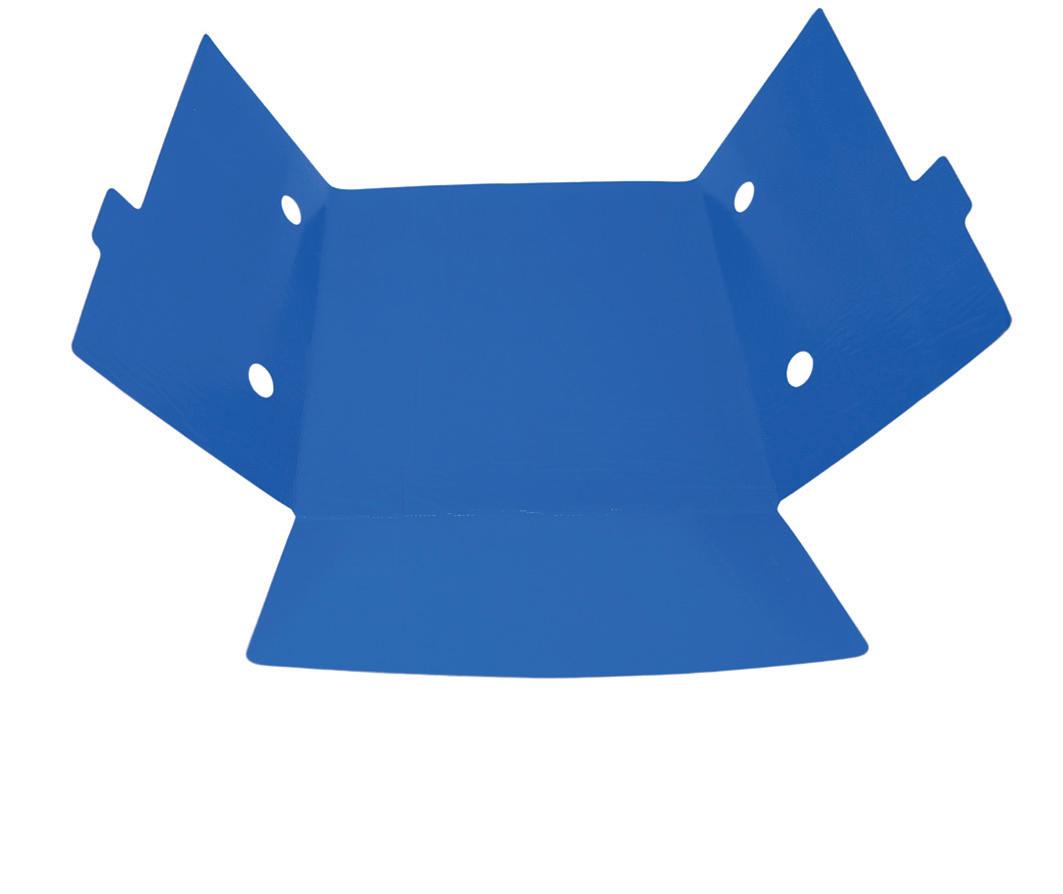
in 1 min 45 sec, and a ham & cheese panini in only 50 sec.
Using the range of accessories available, the conneX® becomes even more flexible. Different coloured trays allow you to cook meat, vegetarian or fish dishes, avoiding crosscontamination, so no need to clean the oven in-between, and service continues without disruption. Half and quarter sized trays allow multiple items to be cooked at the same time and the range of coloured deeper trays ensure foods with sauces are contained.
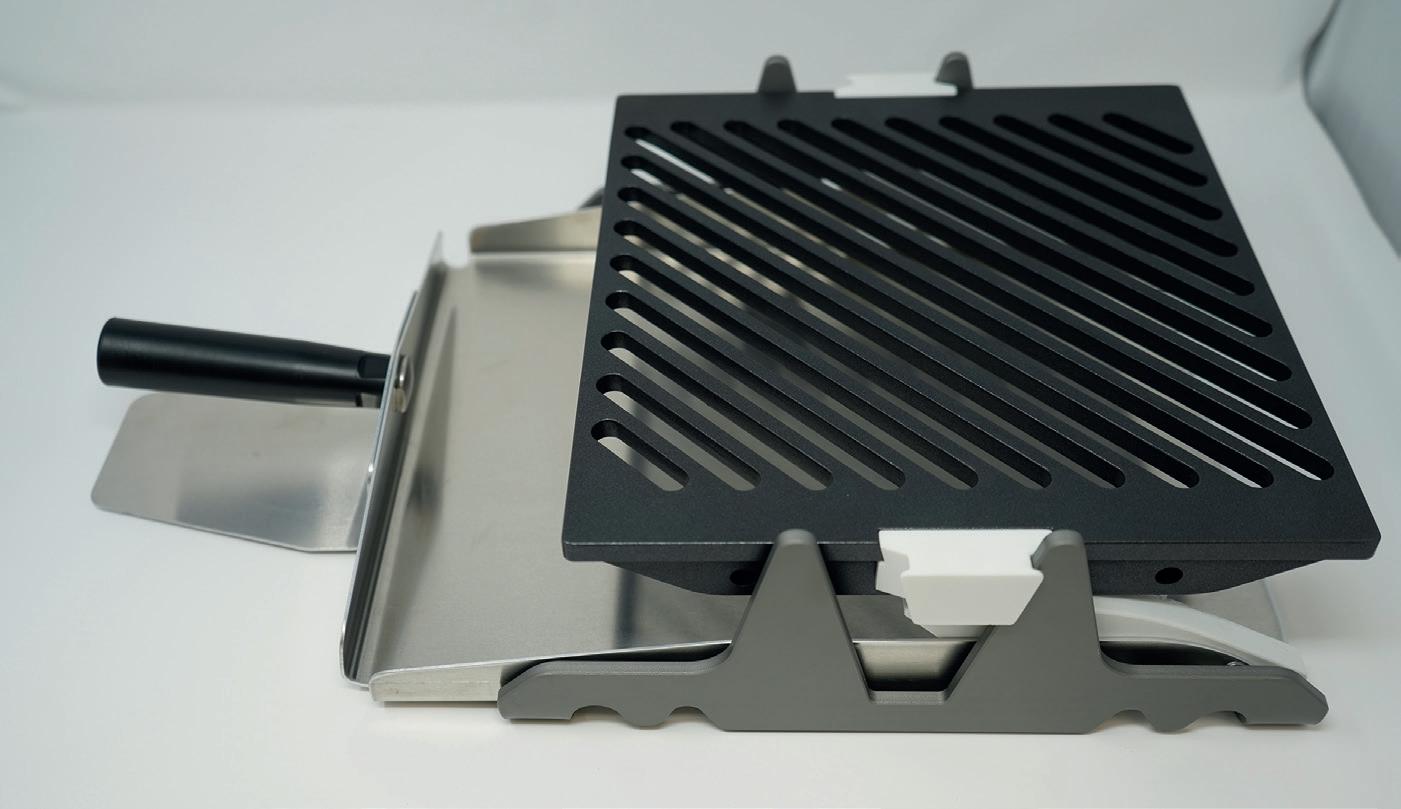
Steve Bell from the awardwinning Yellow Bicycle Café turns up the heat on Merrychef’s conneX® 12 oven and panini press.
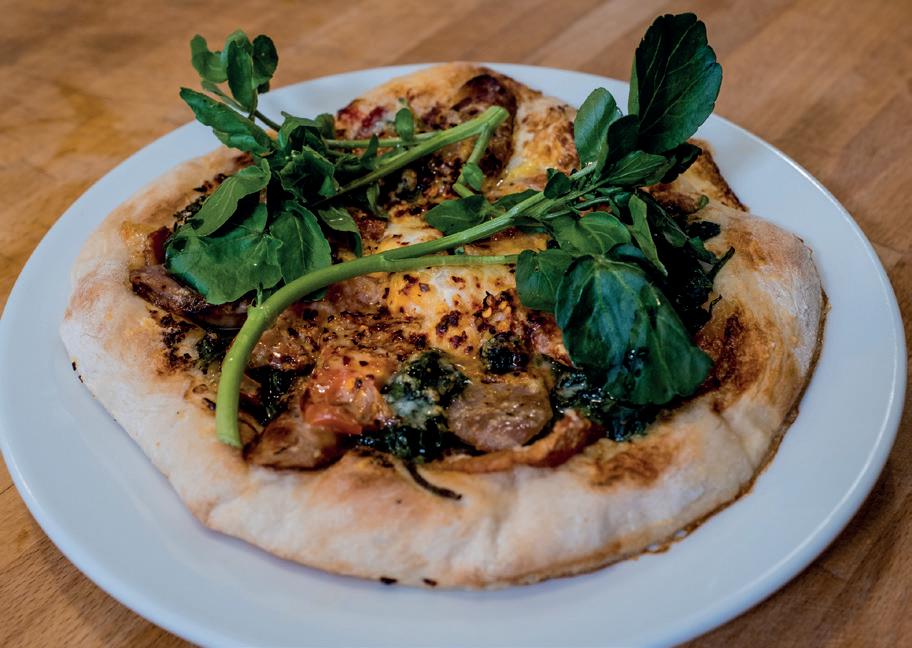
Steve Bell from the Yellow Bicycle Café in Blandford Forum in Dorset knows a thing or two about serving good food, quickly. He regularly changes up his menu with specials that he cooks up from scratch at his café’s counter, so he was keen to put the high speed oven to the test.
“Being asparagus season, we created an asparagus, Cheddar and sweet chilli toastie for the specials board – it went down a storm, working really well visually too. I also made a breakfast pizza. I used sweet chilli
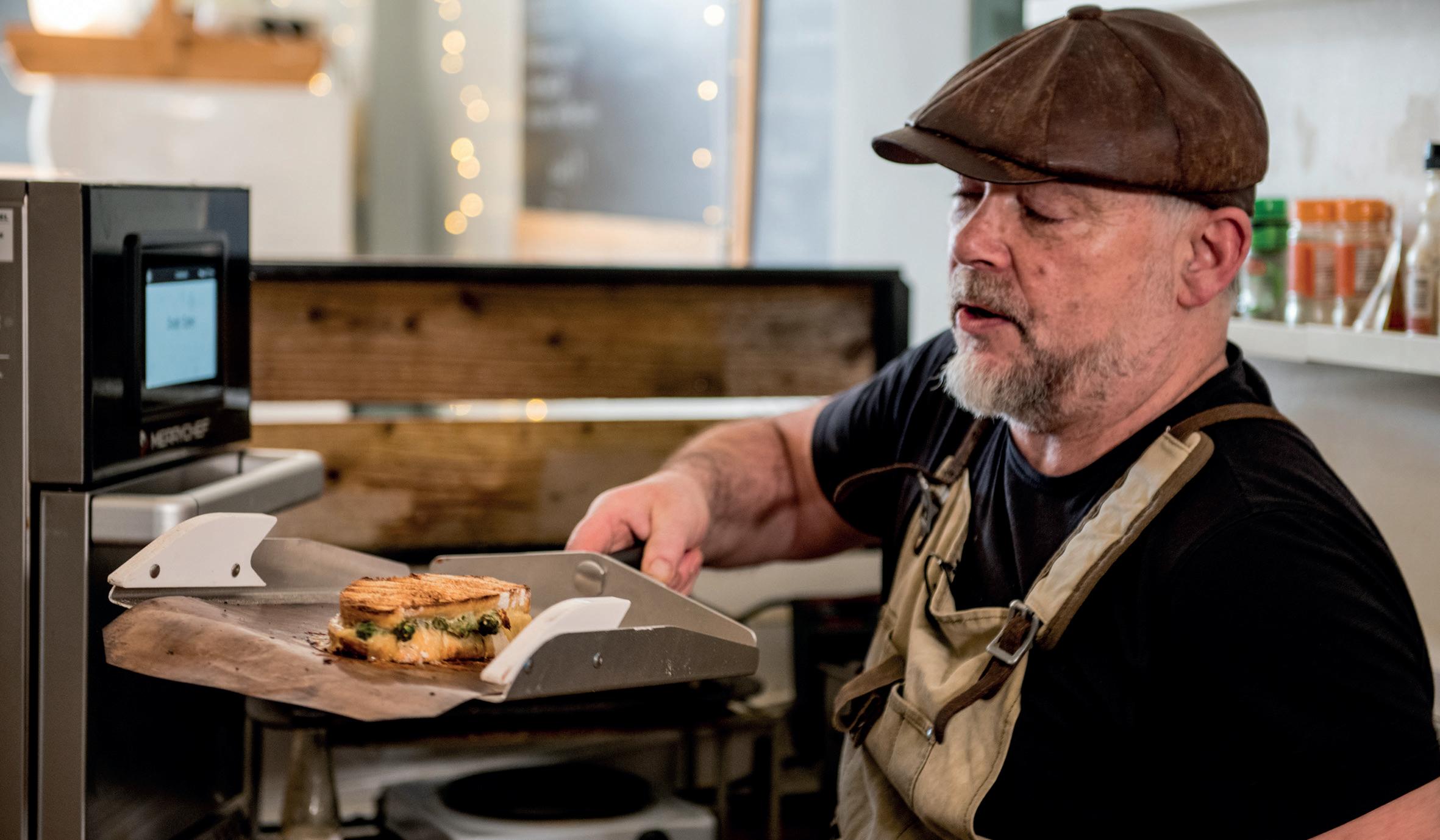
again, the local sausages and bacon, spinach, mushrooms, tomatoes and an egg. That was great, because if you use the programme with the combination of the oven and fan, you can cook a perfect egg where the white is cooked and you still have a runny yolk. You just have to remember to spike it because it’s a microwave as well.
“It was straightforward, even doing my normal menu. There are certain things the oven is superb for, such as bacon, which comes out crisp on the edges. In terms of reheating, the one thing for the breakfasts that I preprep is the sausages, which I slow-cook in the oven until they’re cooked but not coloured.
“If you use the Merrychef for something like that you get a lovely colour on the top of the sausage, and it puts stripes on them. It also produced the best-looking toastie we have ever done, and that’s the one thing I’ve been missing – with the panini
press, you get lovely lines across the top. I was doing my normal toast in there too, with a chargrilled effect.
“In terms of reheating pre-prepped stuff, it’s really fast. Plus, you’ve got control of that combination of making sure that the inside is heated back up properly and putting controllable colour on the outside.
“With my normal equipment, I can’t produce a panini in 60 seconds. For takeaway offerings, which picks up in summer, if someone wants a couple of toasties it would be difficult, as in the past they were competing for space. With this, it’s fantastic: ‘Yeah, sure, I can do two toasties’.
“For somewhere like a Costa, where they are already made up, they’ll be in and out in no time. Also, they’re perfect and I don’t have to worry, because the machine is on a timer and it tells you when it’s done. I can put it in and be reminded when it starts beeping. It’s fool-proof. As long as you press the right button, you can’t go wrong.”
Merrychef® Ready Recipes is a go-to resource designed to help operators serve up variety in their menu, without adding complexity. From toasted breakfast wraps to restaurant-quality desserts, the platform is packed with over 300 high speed, oven-ready dishes, available across all Merrychef ovens – each created to perform under pressure in busy kitchens.
With open access to recipes tailored to every kitchen type and service style, users can explore a growing collection of dishes ideal for cooking fresh from
scratch, part-cooked or reheating.
Filters make it easy to browse by oven model, cuisine or meal type, allowing for simple recipe searches. Each one includes downloadable cards and imagery resized specifically to suit oven screens. Additional content, such as how-to guides and step-by-step culinary videos, helps teams onboard quickly and serve consistently.
In addition to favourites, new recipes and seasonal inspiration will be added regularly, to inspire, spark creativity and expand opportunities.
Merrychef managing director, Colin Lacey, said: “Our goal is to help operators unlock the full potential of their Merrychef ovens by simplifying everyday challenges – whether it’s refreshing menus, training staff or improving speed of service. Ready Recipes is built to be an all-in-one, easy-to-access platform, allowing operators to expand their menu and maximise profits.”
Explore the full recipe collection at merrychef.com/readyrecipes.





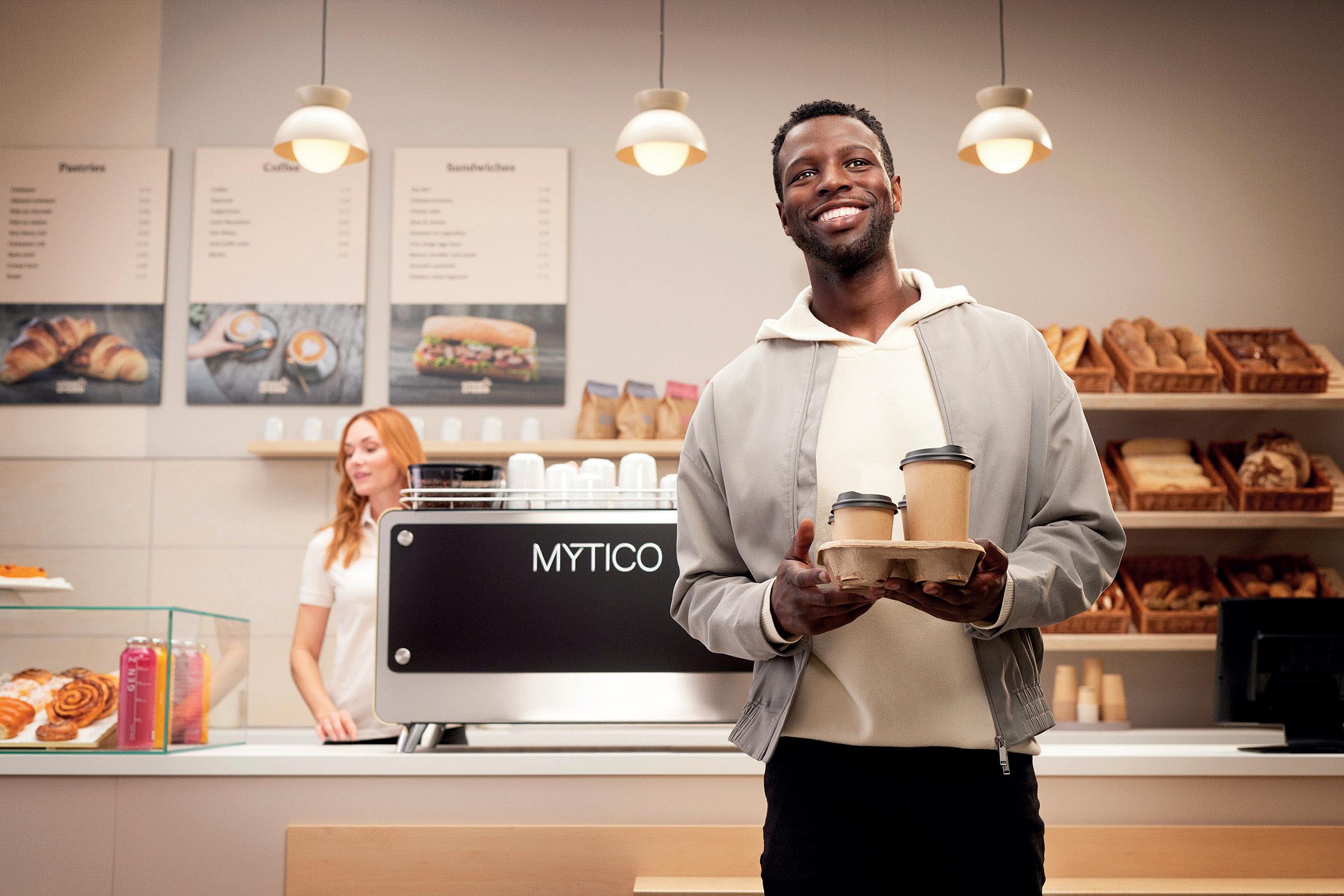

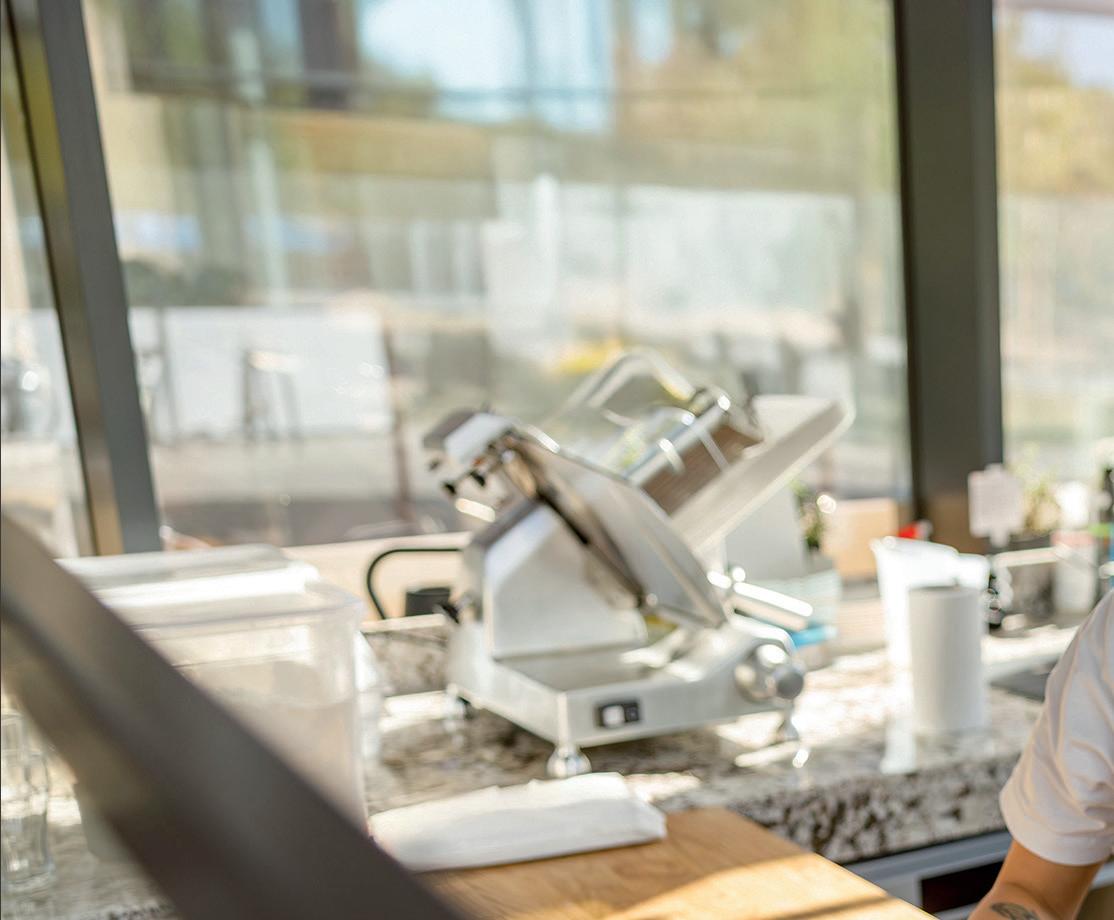
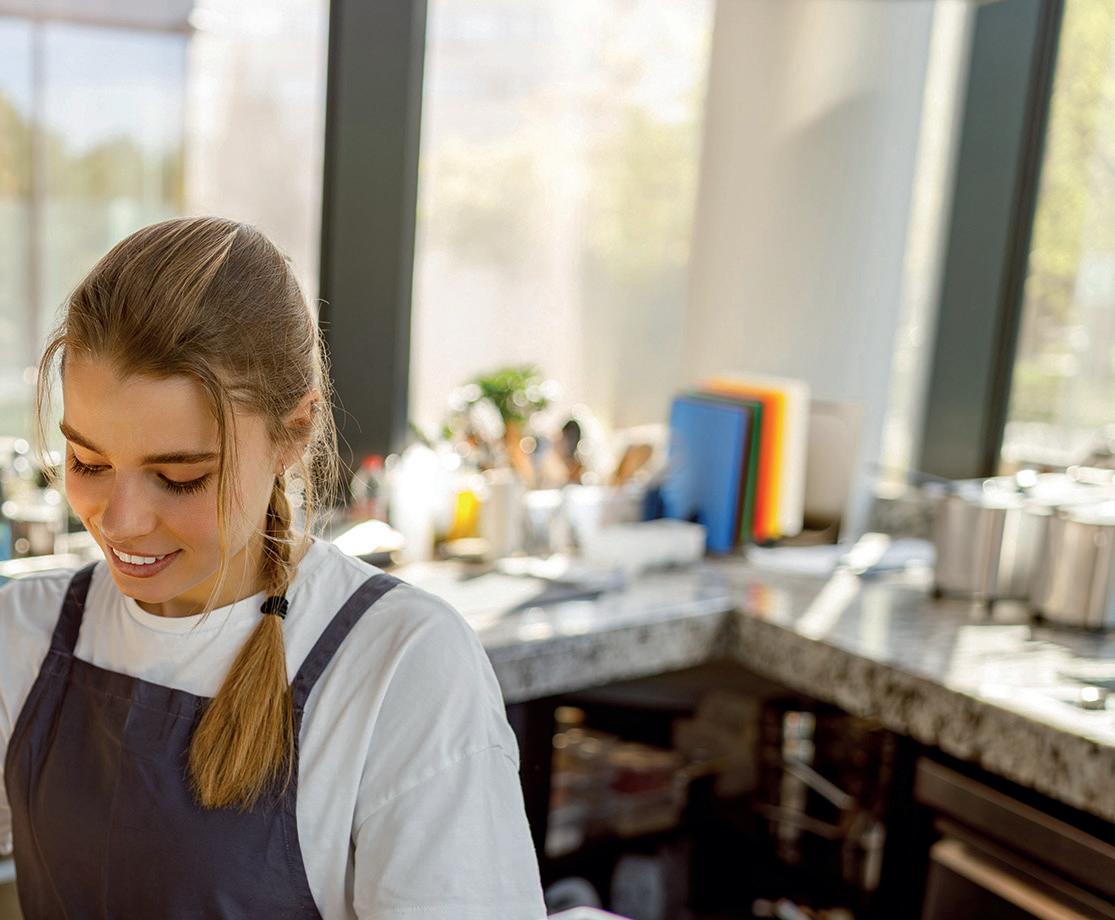
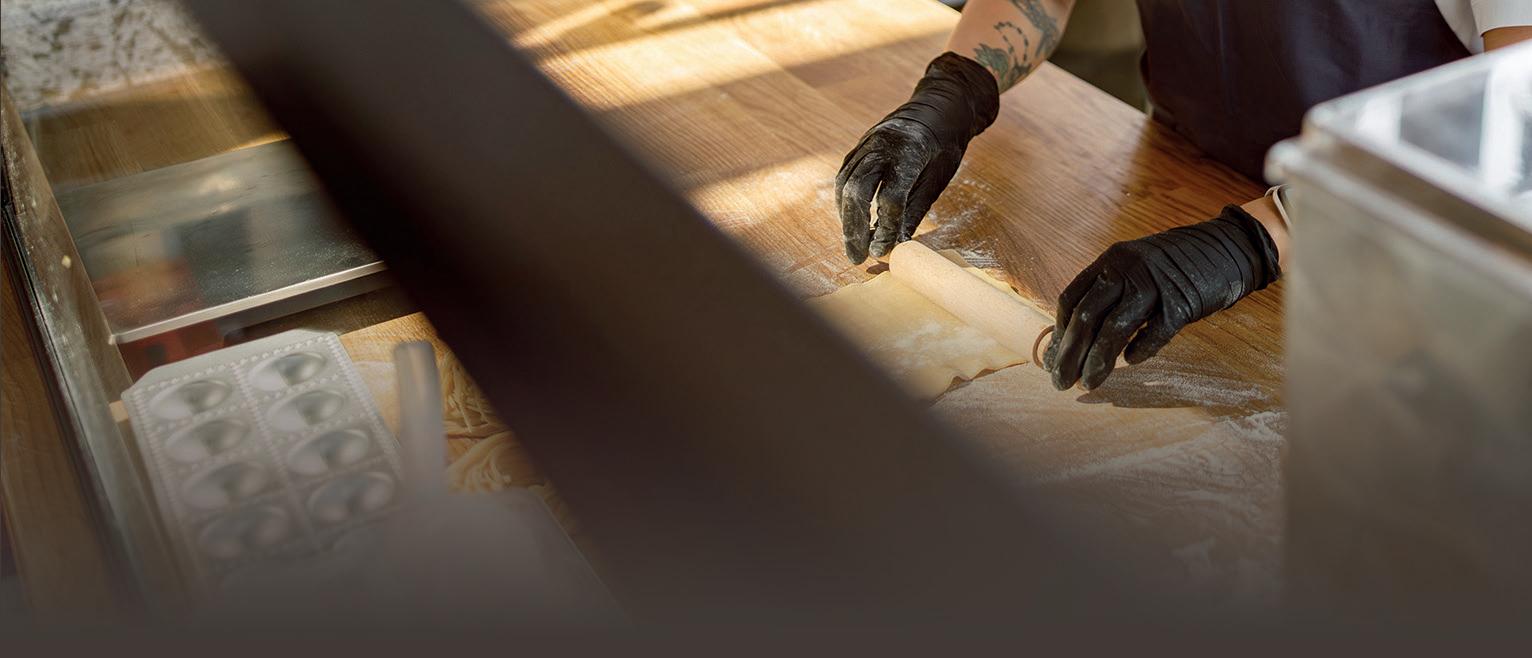
1. Register with the local authority
Tip: Register your food business with the local Environmental Health department at least 28 days before opening.
Why: It’s a legal requirement under food safety law in the UK.
2. Understand food safety law and due diligence
Tip: Familiarise yourself with the key UK food safety laws (e.g. Food Safety Act 1990, Food Hygiene Regulations). Why: Demonstrating due diligence through systems, training and records helps protect your business.
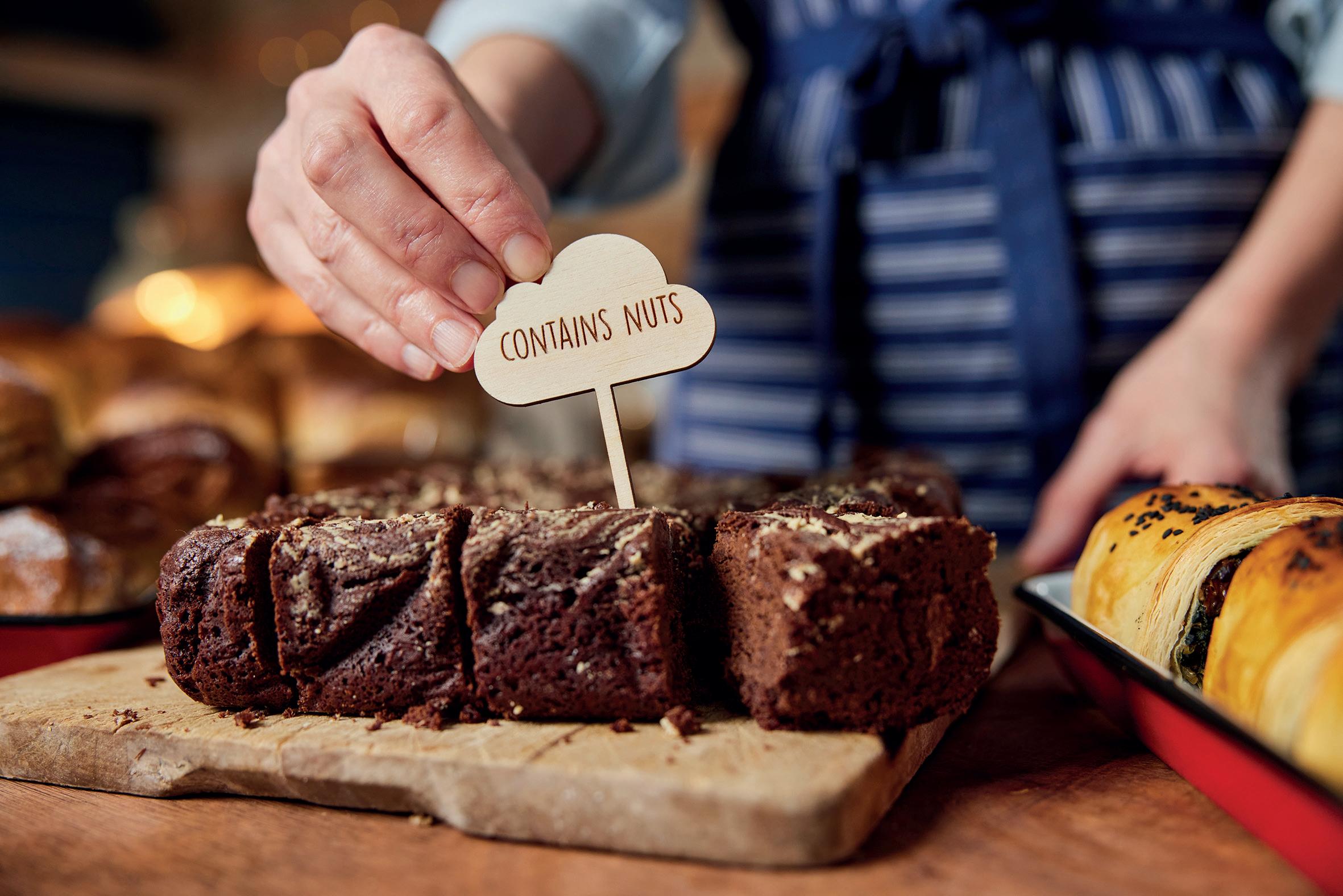
There are so many things to consider when launching a café business, which is why we got top tips from The Food Works SW technical manager, Beth Winters, to cover all bases.

3. Implement a Food Safety Management System (FSMS)
Tip: Use a system like Safer Food, Better Business (SFBB) or a tailored HACCP-based approach. Why: An FSMS helps you identify and control food safety risks consistently.
4. Ensure staff are trained and competent
Tip: All food handlers should have at least Level 2 Food Hygiene Training and be supervised appropriately. Why: Prevent contamination and ensure staff know hygiene practices.
5. Maintain high standards of personal and premises hygiene
Tip: Have cleaning schedules, hand-washing facilities, pest control measures and waste disposal routines. Why: Clean environments and personal hygiene are critical to preventing foodborne illnesses.
6. Proper temperature control
Tip: Refrigerated foods must be stored below 8°C, and hot food kept above 63°C. Record temperatures regularly.
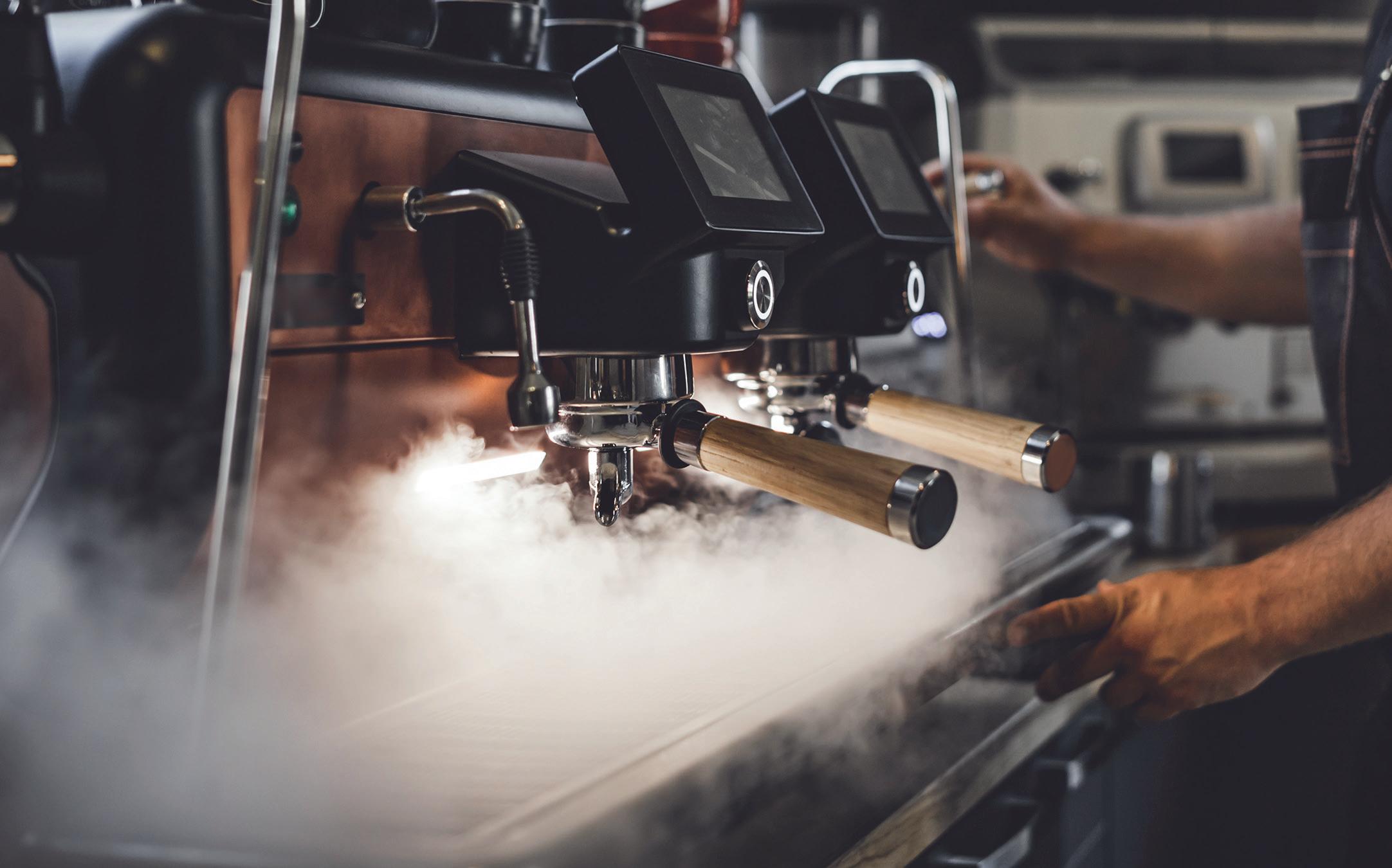
Why: Temperature abuse is a leading cause of food safety incidents.
7. Allergen management
Tip: Know the 14 allergens, label prepacked food correctly and train staff to handle allergen queries safely. Why: Allergen errors can cause severe reactions and legal consequences.
8. Vet suppliers, manage deliveries
Tip: Use reputable suppliers, check deliveries for damage, temperature and hygiene on arrival.
Why: You’re only as good as your ingredients – supplier risk is a concern.

9. Understand labelling and food information requirements
Tip: For food made on-site and sold directly (including takeaway), follow Natasha’s Law and labelling rules where applicable.
Why: Consumers need accurate food information to make safe choices.
10. Keep good records
Tip: Document cleaning, pest control, temp checks, training and incidents. Why: Records show compliance and help with inspections and troubleshooting.
11. Prepare for inspections
Tip: Aim for a high Food Hygiene Rating (FHRS) and be ready to demonstrate your procedures and records.
Why: A good rating builds customer trust and supports your reputation.
12. Consider risks specific to cafés
● Cross-contamination between allergen and non-allergen items (e.g. nut milks, gluten-free cakes).
● Safe use and cleaning of espresso machines and grinders.
● Storage and rotation of risk items: dairy, meats, chilled sandwiches.
● Hygiene practices around reusable cups and takeaway packaging.

Beth Winters has stirred the pots at big names like Samworth Brothers, Oscar Mayer, Refresco and Greencore, building a career packed with flavour and food know-how. Now at The Food Works SW, she’s the go-to guru for small food and drink businesses chasing their next big idea. Winters specialises in food safety and compliance, helping cafés, bakers and brewers meet the highest standards – without losing the heart in their craft. Whether it’s allergen management or audit prep, she makes the complex stuff simple.
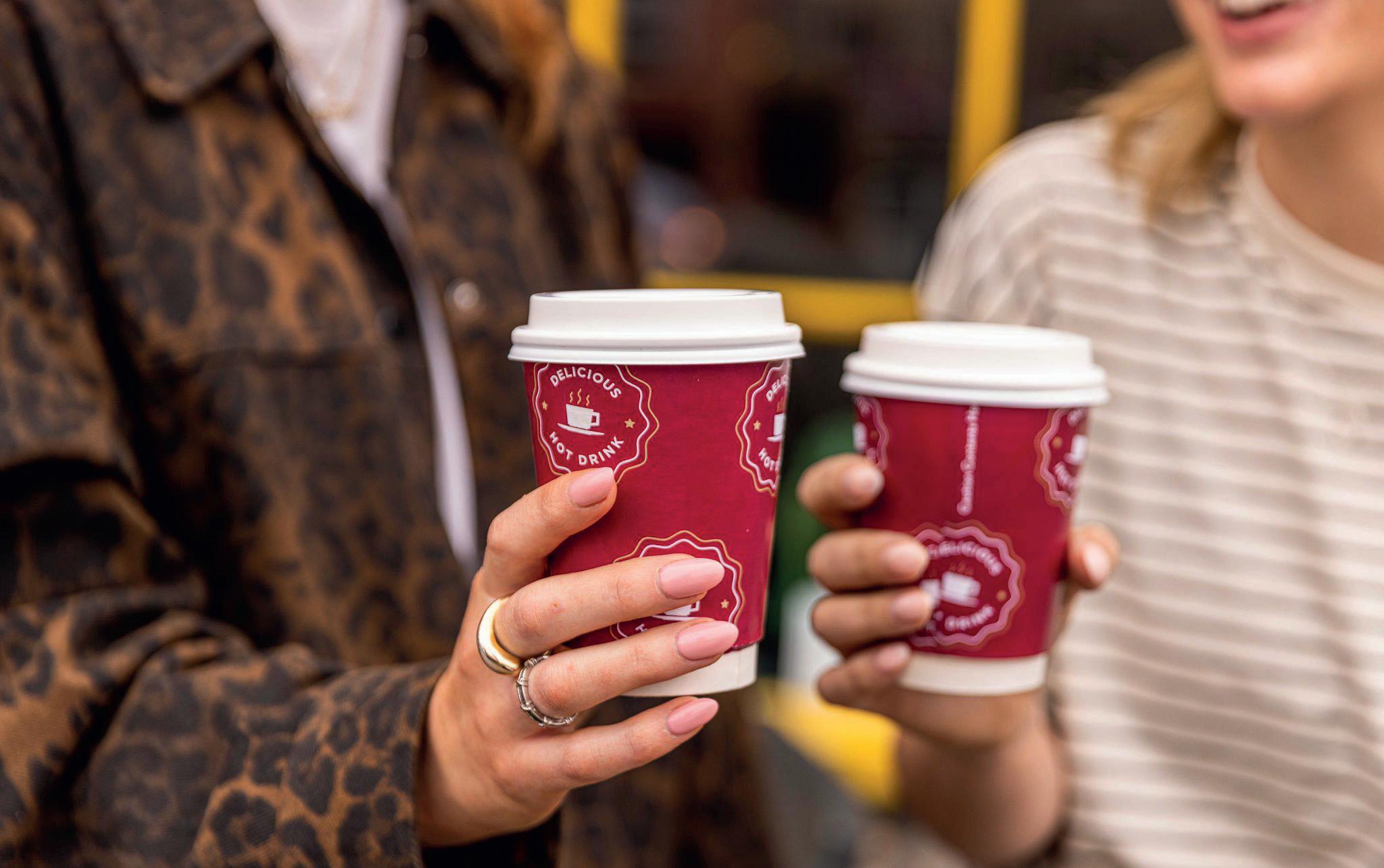
Mark Dineen, director of trading – non-food at Booker, simplifies that essential question: how do you pick the perfect packaging?
Why is takeaway packaging such a priority for new café operators?
It’s not just a functional detail – it plays an integral role in brand perception, customer experience and can help drive repeat custom.
The food to go market is forecast to grow by +4.1% in 2025, reaching £24.2 billion – this clearly offers an opportunity for businesses to extend their income stream beyond a bricks-
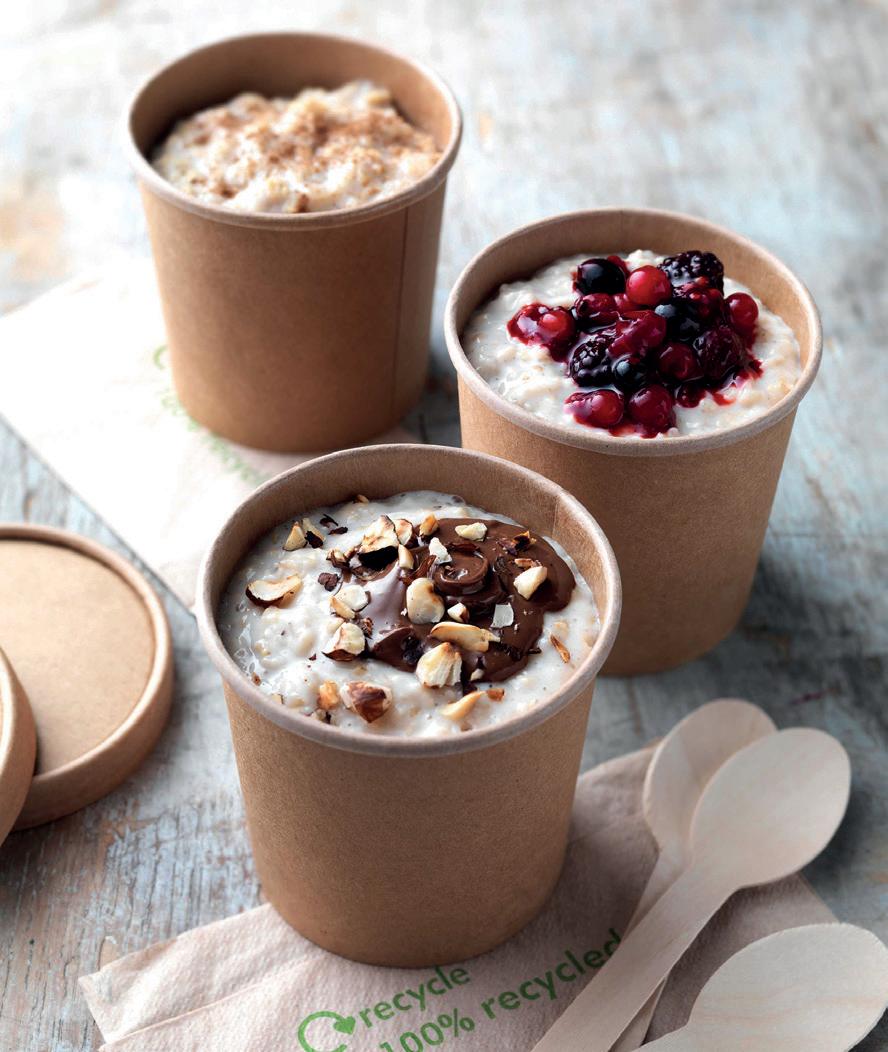
and-mortar setting. In today’s market, takeaway and delivery can represent a significant portion of coffee shop trade over multiple dayparts, particularly during busy weekday lunch periods, early morning commutes and lateafternoon pick-me-ups.
Packaging can shape how a product is perceived, keeps food at the right temperature, preserves visual appeal and ensures the customer receives a consistent eating experience, on site or on the move. It’s also important to display clear disposal information, allowing the diner to make an informed decision following consumption.
Consumers expect restaurantquality food on the go and packaging is integral to the brand experience. In reality, it could make or break repeat custom, especially in a highly competitive market where speed, quality and reliability are everything.
What current consumer trends and data are you seeing?
According to the Lumina Intelligence UK Food to Go Market Report 2025, the FTG sector continues to outperform the wider eating-out market – with volume
and frequency of purchase increasing, and an appetite for quick, high-quality food options throughout the day. The data highlighted demand for everyday, functional FTG missions –such as breakfast, workday lunches and solo snack breaks. For new businesses, this creates an opportunity to capture frequent, repeat custom. Hot drinks, sandwiches, pastries and sweet bakery items remain core purchase drivers but there’s a growing expectation for higher-quality, premium-style options – even for simple menu items.
There is a willingness to trade up for quality. Many prioritise freshness, visual appeal and branded experiences –even for everyday purchases like lunch. This places a greater focus on choosing the right packaging to ensure the customer experience is enhanced. It’s no longer just about practicality; it’s about visual appeal, ease of use and how the brand is perceived overall.
Digital behaviour is key. While most FTG purchases are still made in person, the report highlights a steady rise in
pre-ordering, click-and-collect and delivery, particularly among younger consumers. These habits are wellestablished and shape expectations around speed, presentation and reliability. Items must perform well in transit, not just at POS. Operators need to consider how their food will travel, how it presents when unboxed and whether it maintains quality after 15-30 minutes on the move.
Flavour, texture and crunch are the buzzwords this summer, so cafés can take customers on a taste tour by adding global flavours. Menus have moved on from pre-packed sandwiches and soggy salads. Today, options include everything from hot toasted wraps and rice bowls to protein pots, poke bowls, ramen and more. Deli bowls are a visually appealing, healthy and convenient option, and presentation in the right packaging provides the desired aesthetics and builds on the overall experience.
Packaging is more versatile than people realise – is that fair?
A well-designed range has versatility at its core, which means that multiple formats are now suitable for hot and cold items, wet or dry dishes, and both takeaway and delivery. Operators can simplify packaging choices, while still meeting the specific needs of a varied menu. For example, the same bowl might be used for a cold poke salad and a hot noodle dish, helping streamline SKUs without compromising on quality or performance.
This versatility can also help with branding and consistency, especially for operators working across different settings or platforms – from dine-in to takeaway to third-party delivery.
At Booker, we work closely with customers to recommend packaging solutions that are versatile and right for each individual’s needs.
What is the best way to approach the packaging question?
The first step is understanding both your menu and customer behaviour. Packaging needs to work for the product and the context in which it’s being consumed.
It goes without saying that your menu plays a major role in determining what you need. Hot wraps, toasted sandwiches and soups require insulation and leak resistance, while salads, patisserie and fruit pots may benefit from breathable or clear-lidded packaging to protect texture and enhance visibility. Portion size, sauce content, toppings and temperature all influence what works best practically.
Presentation is a key consideration. – customers eat with their eyes first. Choosing packaging that’s too large for the dish can make it look sparse or messy, while a smaller option leaves it looking crammed, compromising not only aesthetics, but leading to squashed items, spillage or a disappointing unboxing experience. The right fit helps maintain the shape, texture and impact of the food, making it more appetising and reflective of your brand quality.
Eating behaviours are equally important. Are they commuting, at their desks, ordering for delivery or picking up lunch for the park? These scenarios influence performance – from heat retention to leak resistance and ease of transport.
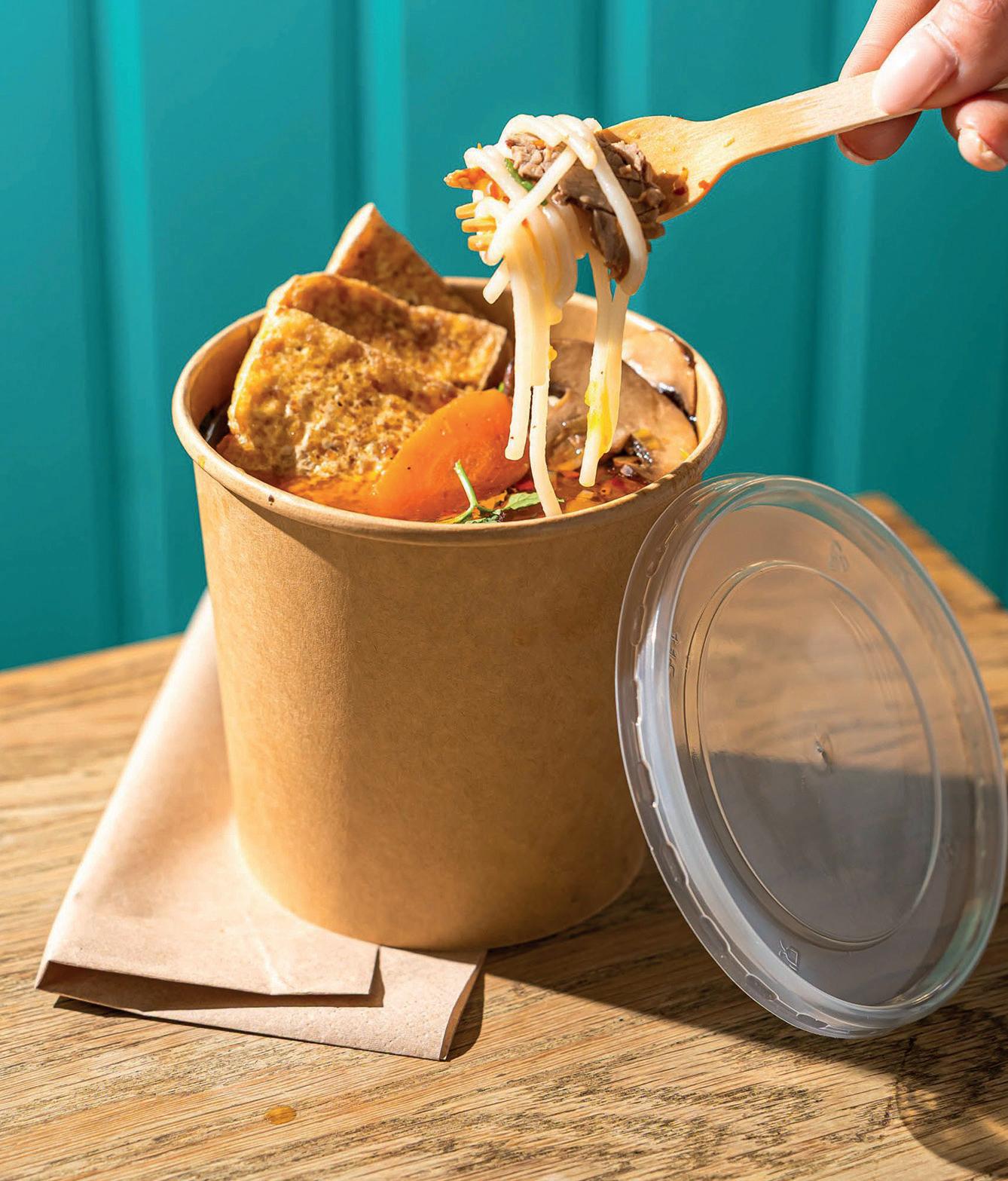
includes 255 professional-quality disposables, covering everything from self-folding boxes and poke bowls to ice cream and porridge tubs, sandwich and baguette boxes, and cups for hot & cold drinks. It also includes compostable options and Bagasse hinged lid boxes, trays and bowls, as well as square and round boxes in multiple sizes with compartments, wooden cutlery and stirrers, plus paper smoothie straws.
The range is built around three flexible pricing tiers – Essentials, Core and Premium – helping operators balance quality, cost and scalability as their business grows.
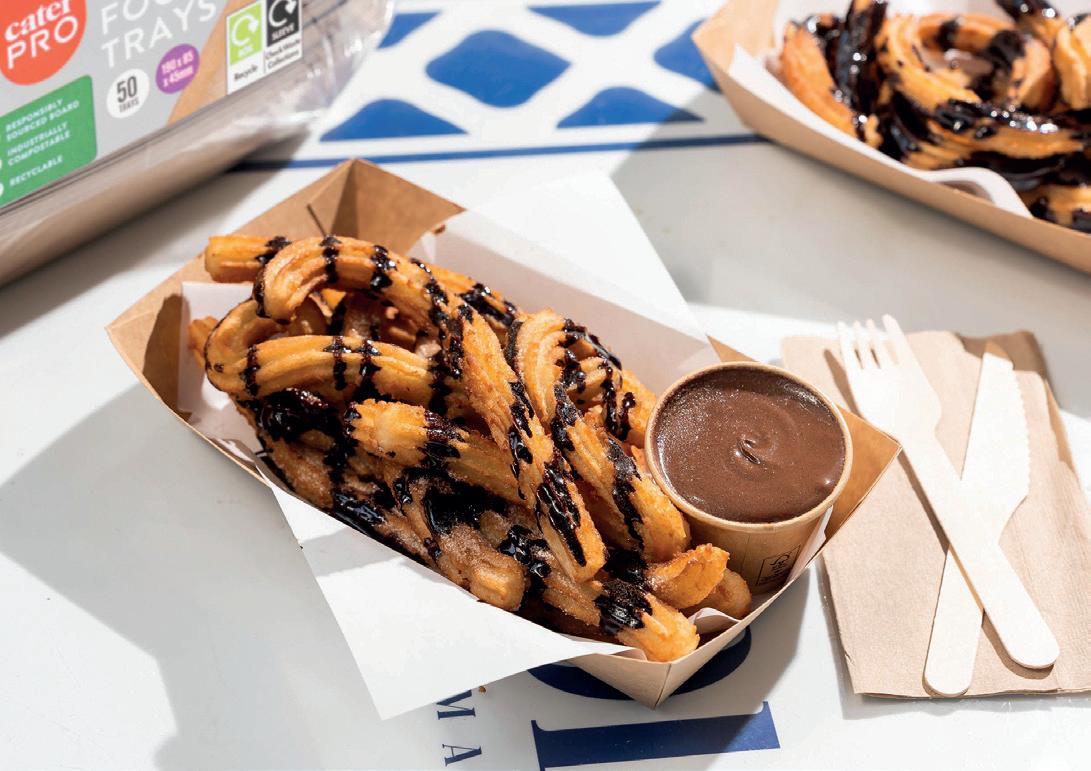
The next step is choosing a supplier.
The CaterPro range from Booker has been designed with café operators in mind. It
All products are food grade and sourced exclusively from Bookerapproved suppliers, ensuring quality and safety. CaterPro packaging also features clear information about materials and disposal instructions, with a tick-list system to help with informed choices – a key consideration in an increasingly complex area.
For more on CaterPro , check out your local Booker branch or visit booker.co.uk.
Booker customers can see and sample the CaterPro range at the Booker Catering Trade Show at the NEC Birmingham on 24 September. Register for a free ticket at tinyurl.com/57jvjztz.
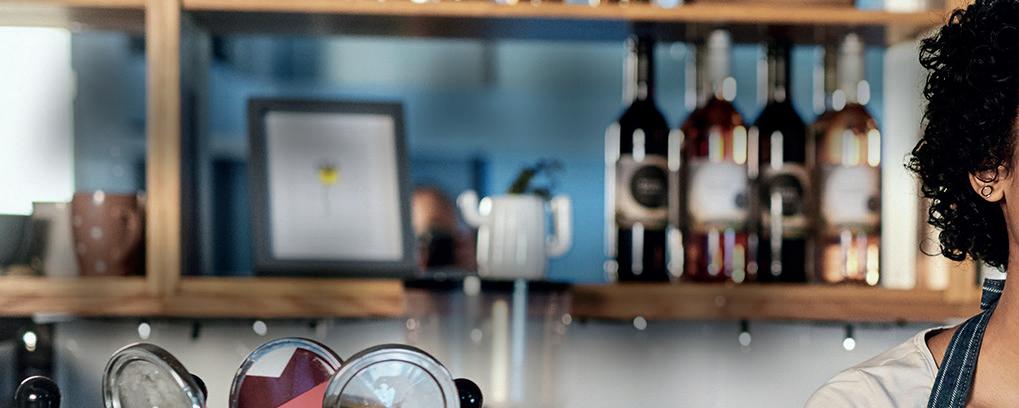
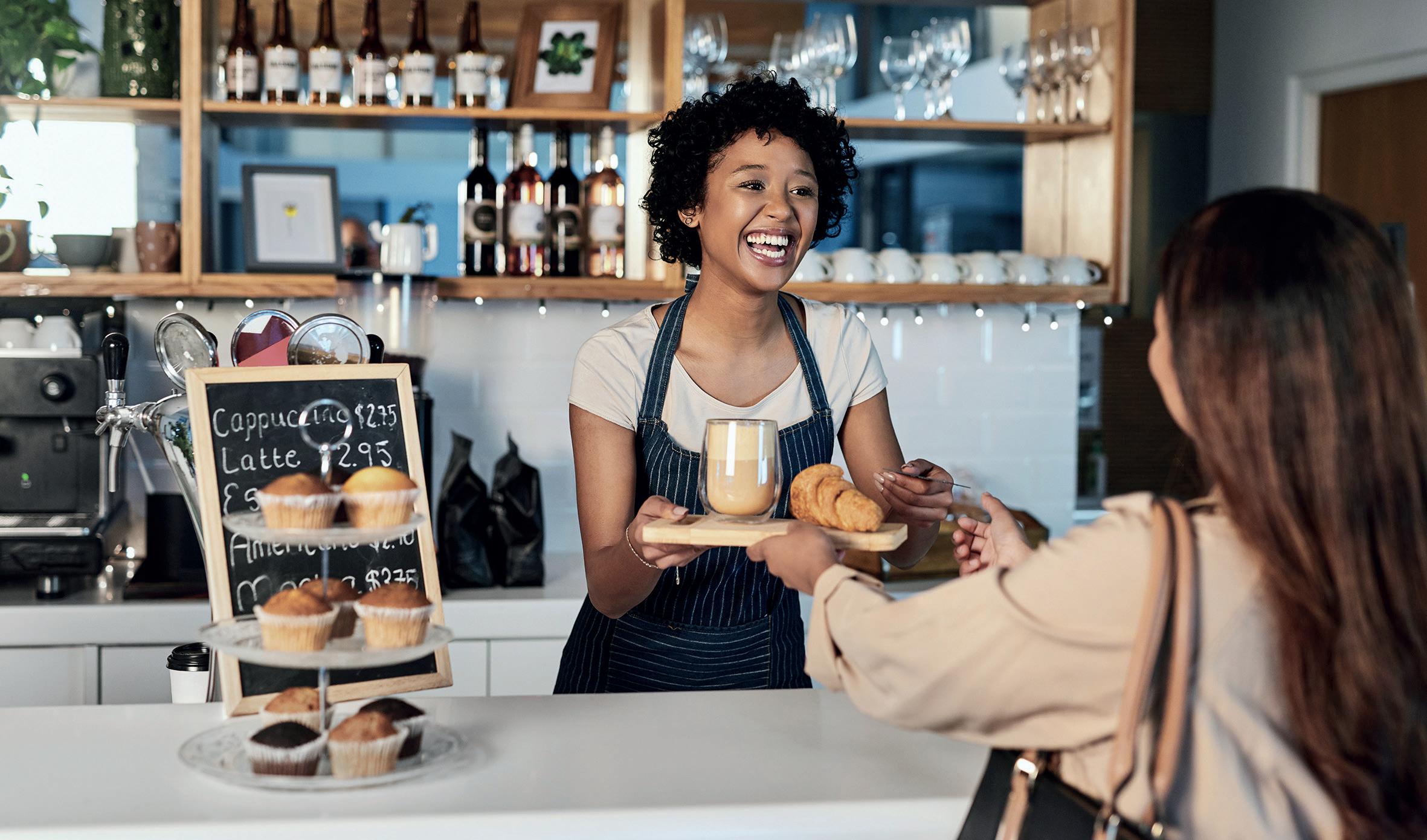

With a wealth of café sector experience, Alex Noake, senior vice president & MD for Sabert Europe, is perfectly placed to advise on how to cultivate loyalty and add value to your brand.
I’d like to start by saying that I am a co ee guy but not in a snobbish, calibrating my press to match the barometric pressure sort of way. I know a good Americano or café con leche when I taste one and, from bean to business, I know the factors which enhance the experience.
Running a co ee bar in 2025 is about more than at whites and free Wi-Fi. It’s about understanding the rhythm of the local community, managing operations smartly and staying relevant in a ercely competitive market.
The best operators are evolving fast. They’re not just reacting to trends; they’re building resilience, loyalty and memorable experiences.
In working closely with food-togo brands and independents from Iceland to the Middle East, I’ve seen the landscape shift dramatically. However, regardless of the geography, there have been three key mindset shifts in the operators that thrive.
Customers no longer just want a ca eine x, they want a moment. Strong brands design experiences that start from the second you walk in and continue long after the last sip.
However, operators have fallen into the same trap. Automation is creeping in everywhere and some of it is helpful (pre-order apps, contactless loyalty, etc) but when it strips out human interaction, it can become a problem.
There are major chains that have su ered recently with stagnating
sales, store energy dropping and the customer experience starting to become at. Of course, times and technologies change but some have drifted too far from their original brand values of community, warmth and consistency. Fortunately, they’re starting to re- nd their feet again, but it’s a clear reminder that tech can support service but not replace soul.
One UK-based brand doing things di erently from day one has seen their shops continue to pop up across the UK and now abroad. While the co ee isn’t cheap, they’ve created a sense of novelty and aspiration. Whether it’s a blend claiming to increase skin radiance or enhance gut health, they’ve tapped into wellness, lifestyle and trend-driven consumers.
Yes, margins are tight, but shaving pennies from every component often leads to hidden costs elsewhere. The best performers aren’t just cost-cutting, they’re value-building
That manifests itself in several ways:
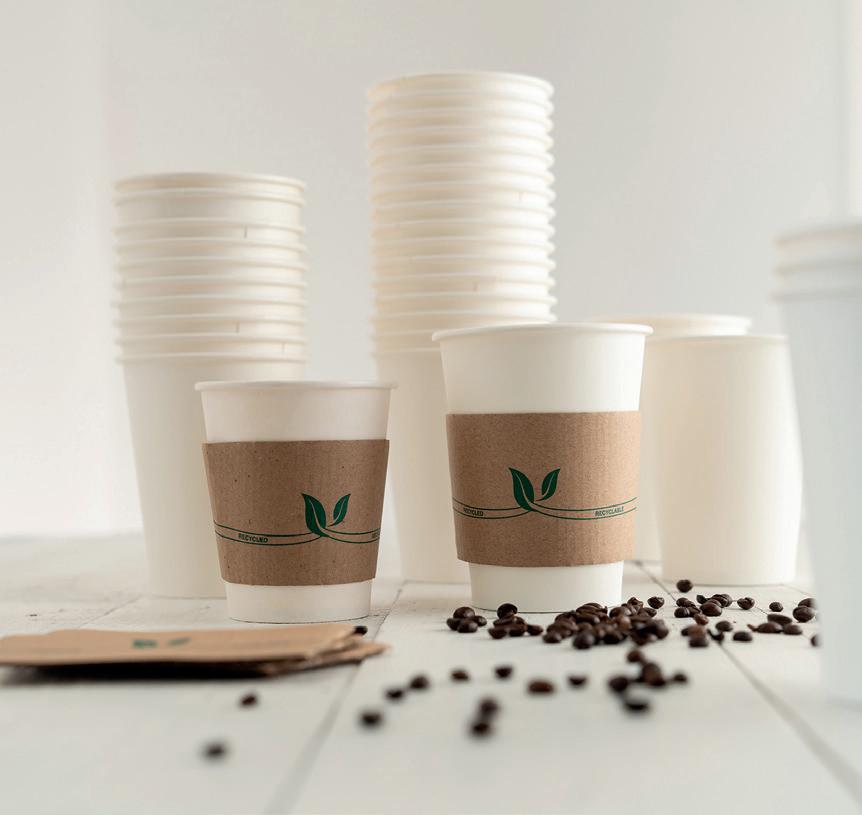
● Investing in sta training so service feels familiar, natural and consistent.
● Creating menu moments such as dairy substitutions, seasonal drinks, matcha options or loaded breakfast pots complemented by great packaging. The odd value deal to drive tra c is always a good idea.
● Branded packaging that re ects identity, feels good, travels well and works practically at the till. Thoughtful packaging reinforces brand values. That’s why growing operators are working with suppliers who can o er high social provenance and endof-life sustainable consideration. The generic sea of brown and beige on the shelf does little to create enthusiasm and drive sales, but done well, packaging builds trust, creates free PR and drives repeat business.
Shift 3: ‘Local’ to ‘locally embedded’
Many claim to be local but fewer behave that way. The new generation of co ee business and wider QSR operator is going deeper, from hyper-local sourcing to community
partnerships with charities, schools and clubs.
With its roots in the North West, there is a chain that has become one of the UK’s fastest-growing co ee shops. It’s hard to pin down one thing, but from their single site and speciality roaster inception, they’ve managed to grow while maintaining a grassroots, indie vibe, conveying premium at the same time. The in-store presence is warm, branding is consistent and they’ve built a connection with students and young professionals.
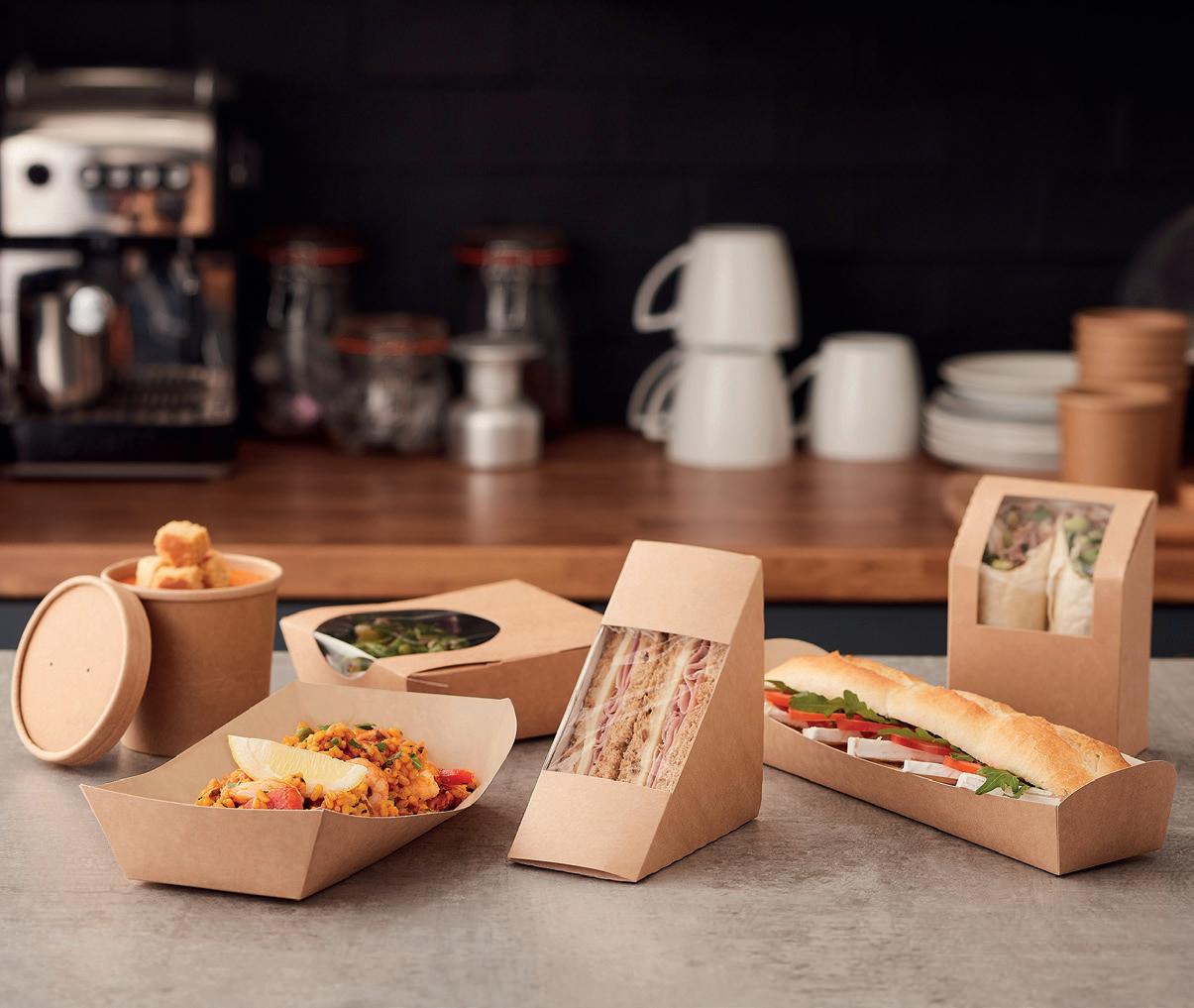
changed: great drinks, great people and a space that feels right. However, your menu innovation, complementary packaging and community approach will need to work harder than ever.
To sum up, people don’t just want a co ee; they want to feel good about where they got it. This can relate to sustainability, ethics, diversity or just seeing a friendly face each morning.
If you’re setting up a co ee bar today, the essential ingredients haven’t






It’s a basic instinct of most human beings to want to belong, so give them a reason to keep coming back. Whether it’s the rst sip of a gut-friendly latte or comfort of seeing a familiar barista behind the counter, details matter.
Check out sabert.eu.



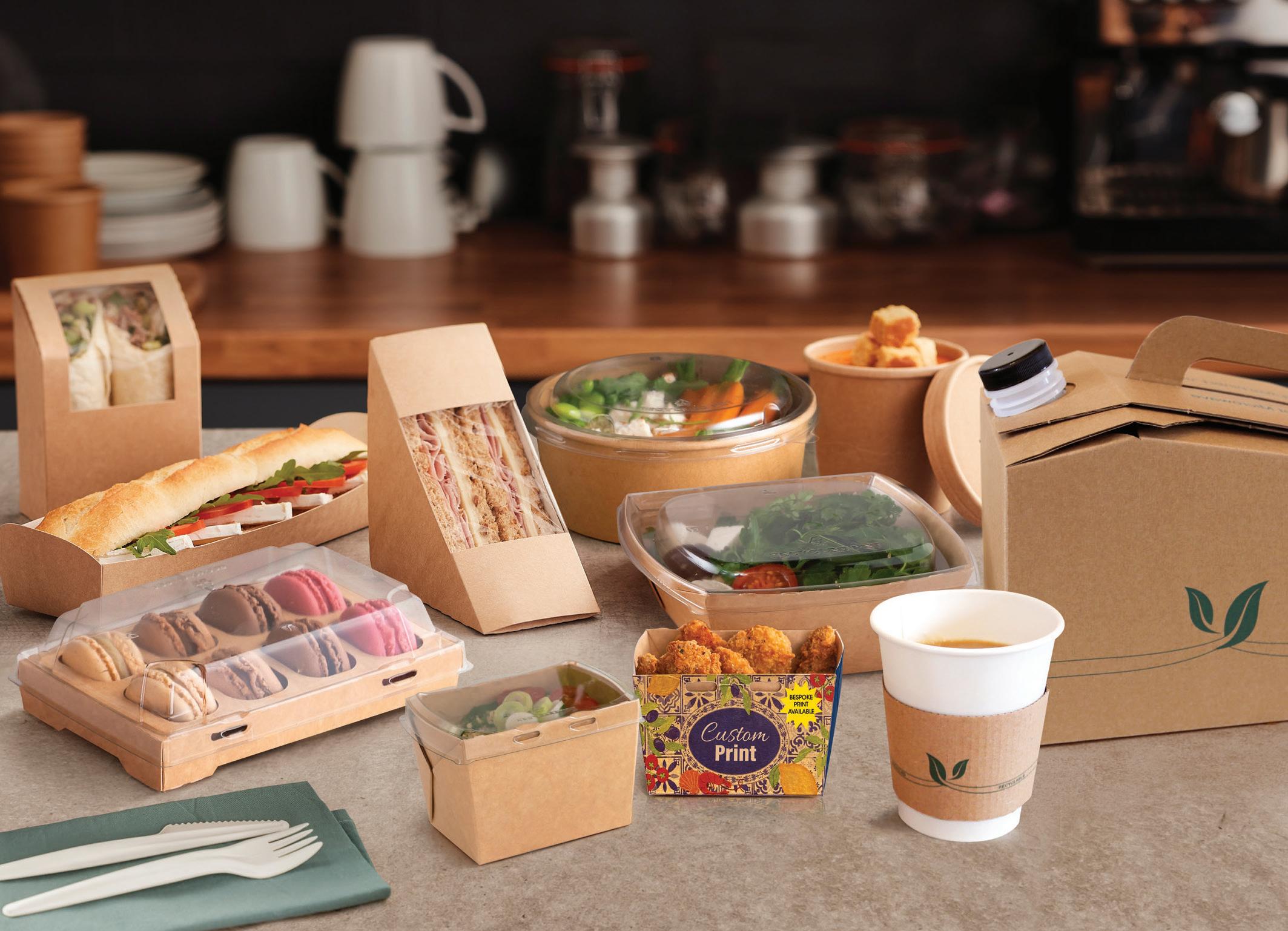

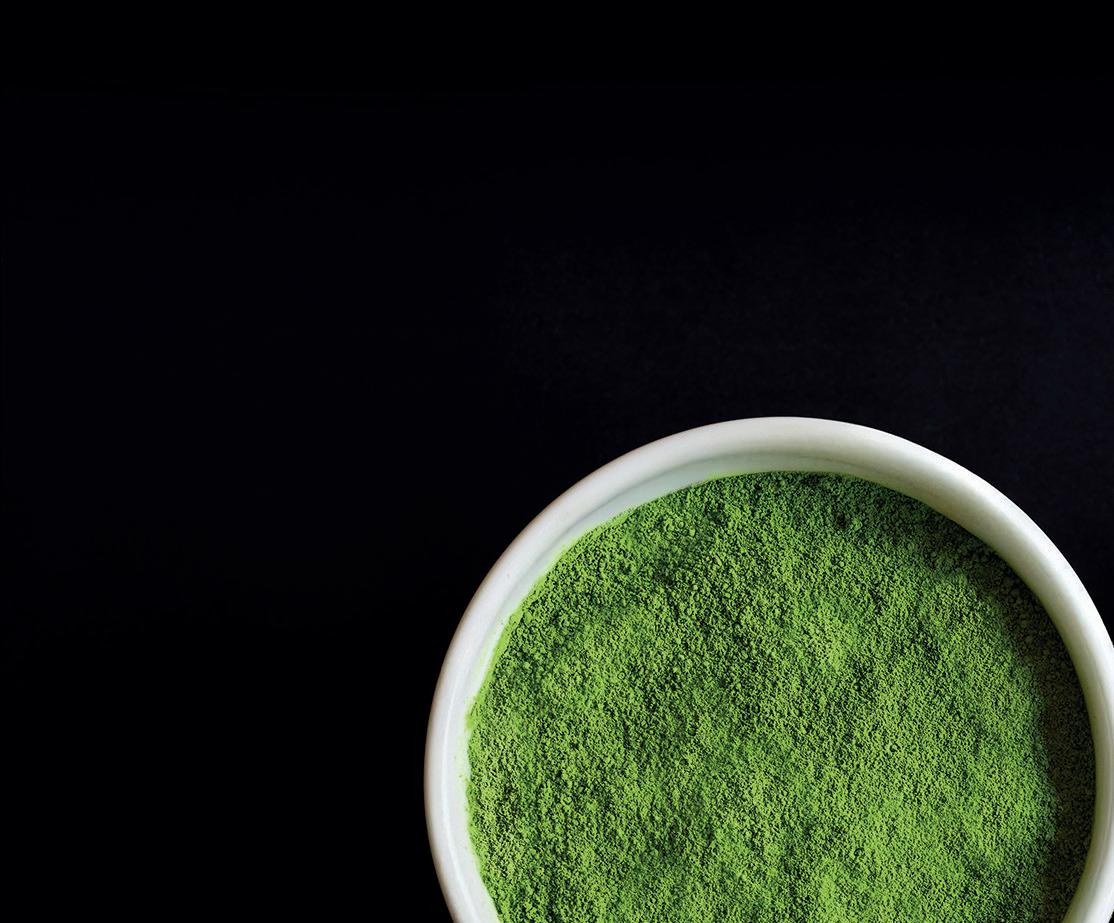
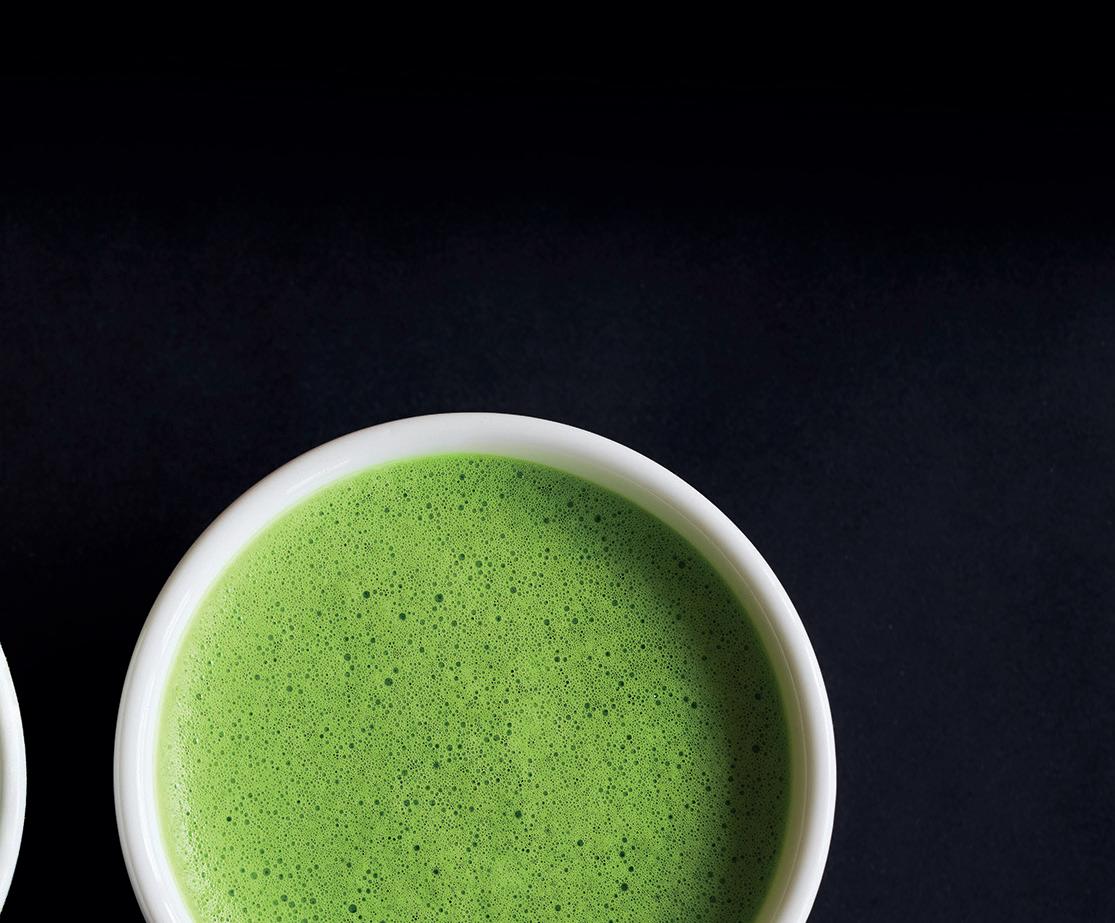
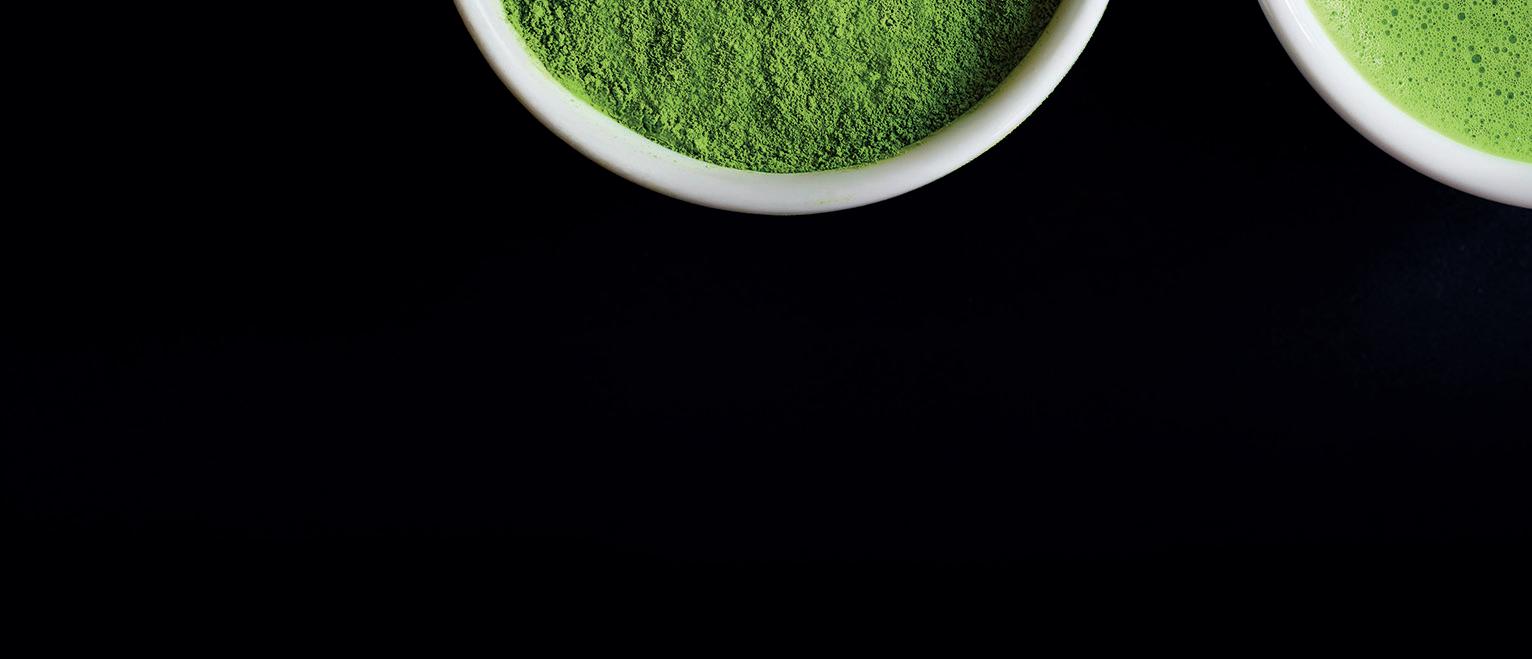
Ten questions every new café operator should ask about the latest drinks craze, courtesy of Emilie Holmes, founder of Good & Proper Tea.
1. Why is matcha creating such a buzz?
A mix of health appeal, vibrant visuals and smart positioning by brands and in uencers. The way it is produced makes it nutritionally powerful: leaves are shaded for 21-28 days before harvest, limiting sunlight and boosting chlorophyll, antioxidants and amino acids like L-Theanine. Once plucked, the leaves are steamed, dried, de-veined, de-stemmed and ground into an ultra- ne powder. Unlike traditional tea, when you drink matcha, you’re consuming the whole leaf.
Matcha’s striking green colour makes it visually appealing, especially on social media where ‘matcha in uencers’ are now an actual thing. Gen Z is key to driving the boom,
dubbed as this generation’s ‘avocado on toast moment’, in search of healthier alternatives to co ee.
2. Is matcha emerging as a potential competitor to coffee?
It’s certainly a strong contender and forecast to grow at a much quicker rate than co ee, albeit o a smaller base. Matcha is now seen as a ‘healthier’ source of ca eine, delivering a much smoother, more sustained energy boost – what many describe as a state of ‘calm focus’, without the jittery spike and crash experienced with co ee.
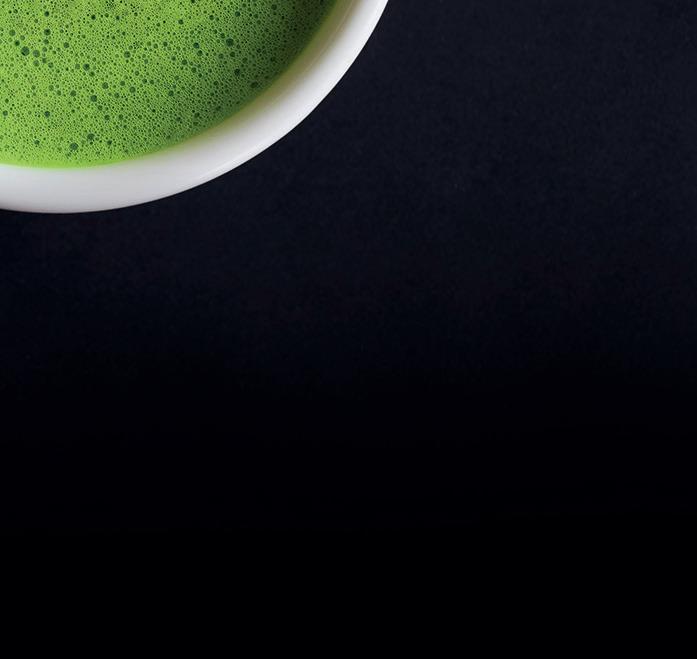
of matcha, introducing it from 2016, where customers queued for lattes whisked to order. A decade later, matcha has shifted from niche to necessity. We see cafés putting it front and centre, and the high street chains following suit. For the hospitality sector, matcha is a welcome growth area as it’s trickier to replicate at home, with a good margin opportunity too (a £4.50 matcha latte can be a real win).

It’s also versatile, pairing well with fruits, chocolate, milk alternatives and a range of iced drinks, blends and baked food. This opens the door to a wider range of consumers, including those who don’t drink co ee at all. Good & Proper was an early champion


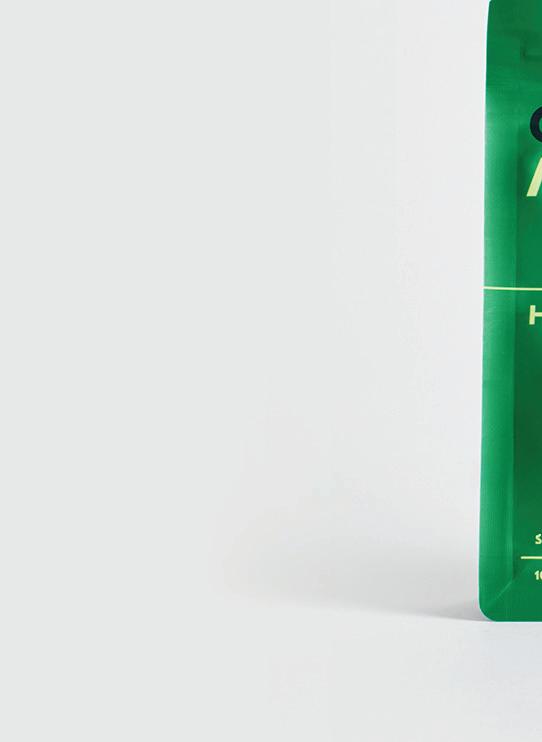
3. How does the caffeine in a cup of matcha compare to a standard coffee? Of course it depends on the dosage, but a standard matcha latte contains roughly 60-70mg of ca eine, around 5mg less than a single espresso shot. While it’s slightly less in volume, the type of ca eine experience is quite di erent. As mentioned, matcha contains L-Theanine, an amino

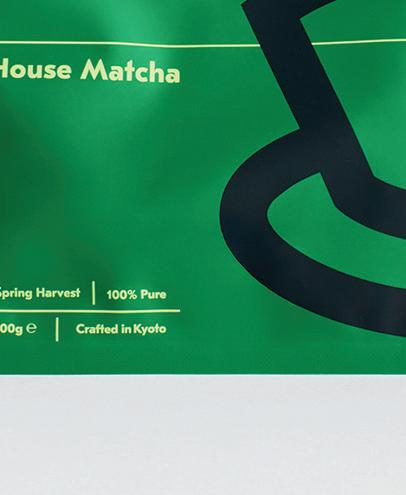
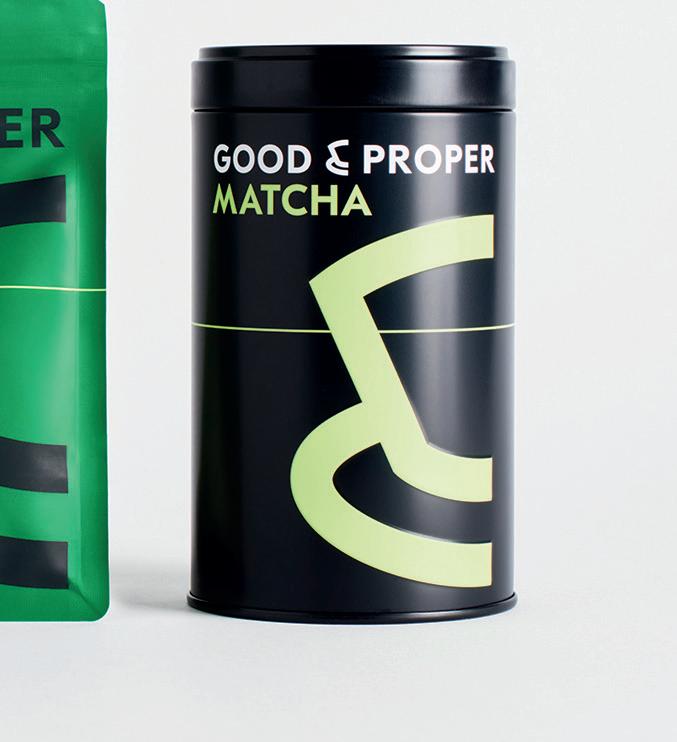
acid that slows ca eine absorption, promoting a calmer, more sustained energy release.
4. What are the different ways matcha can be drunk and served?
It’s a multi-format ingredient. In Japan, it’s used in everything – from baked goods, ice cream, traditional tea, lattes, even beer. In UK cafés, you’ll most often see it as a hot or iced latte but it works in smoothies, food recipes and of course, if the quality is there, neat.
5. What’s key to a great matcha latte?
The secret starts with quality matcha, with colour a major indicator – the more vibrant the green, the better. Consider avour, balance, texture and grind size. The best matchas will be picked as part of the ‘ rst ush’ during spring harvest, which is what we have for our new House Matcha, developed with respected Tea Master Hiroshi Kobayashi. It’s beautifully balanced and stands up on its own.
A popular serve is the iced-matcha. Here are the steps:
● Sift 3g of matcha into a wide-sided bowl, then use your pre-soaked bamboo whisk, add a splash of warm water (80°C) to form a smooth paste, avoiding clumping or graininess.
● Add a further 30ml of 80C water, and if using, now’s the time to add sweetness. We recommend agave (around 6-8g). Whisk using a zig-zag motion to create a smooth froth.
● Prep glass with lots of ice, adding around 150ml milk and add matcha shot over the top, stir and serve.

6. What are the key quality grades?
You will see the term Ceremonial Grade a lot. However, this isn’t useful – it is essentially a made-up Western
marketing concept without genuine recognition in Japan as a quality standard. The best is typically made from the rst ush of the season, during the spring harvest. Alternatively, culinary grade matchas are used in baking and cooking; slightly more bitter and robust but perfect as a background note, where adding sugar helps provide a good balance.
7. What factors should be considered when choosing a brand?
Aim for well-known growing regions – Uji is the traditional home of matcha in Japan but is small. So, look for speci c clarity on sourcing credentials to provide better traceability on where your matcha is being produced and how it is blended.
Most importantly, test how it pairs with oat, almond and soy milks, which is why we purposefully blend our new House Matcha to pair perfectly with milk of all types.
8. Matcha could be described as an acquired taste. How do you tempt customers into the category? It can be, but a lot of that comes down to quality. Lower-grade matcha can be overly vegetal and bitter. Quality matcha shouldn’t need lots of added avourings or sweeteners. Our approach is to educate: show consumers how high-quality matcha is produced, and what a di erence origin, harvest and craftsmanship make.
With our House Matcha, we’ve spent the past year creating a blend that’s smooth, vibrant and sweet, with a clean umami nish – no need for sweetener and it pairs beautifully with milk. Iced or hot, lattes are still the main ways to taste matcha but a premium product can shift perception entirely.
Since launching the business from a converted van, Emilie Holmes has built Good & Proper Tea Co. into one of the UK’s most respected independent, female-founded tea brands. They’re on a mission to show the world how good tea can be, when it’s done properly. They carefully source a range of delicious, single-origin teas and herbal
infusions, and having earned numerous awards, proudly supply some of the best cafés, hotels and o ce spaces.
Their new House Matcha is the result of a year-long development process with Hiroshi Kobayashi, one of just 13 ‘10-Dan’ Tea Masters in Japan, and has been blended exclusively for Good & Proper for milk-based drinks.
9. What equipment and staff training are needed to prepare matcha?
Our approach would always be hand whisking matcha to order, where feasible. To do this, a bamboo whisk is essential and be sure to soak it for a few minutes in-between servings as this softens it, reducing breakages and it should last far longer. You’ll also need a sieve, a ‘chawan’ (matcha bowl), set of scales, ideally a temperaturecontrolled kettle (aiming for about 80C to avoid burning), and a ‘chashaku’ (matcha scoop) – we suggest around 3g of matcha per serve.
For higher volume, if you have to batch, it’s important this is made fresh each day and kept chilled. Exposure to oxygen will mean it starts to oxidise and become muddier in colour the longer it is left. Try to produce smaller batches more regularly.
Worth getting clued up on the key points: sift to avoid clumps, whisk into a ne paste and serve at the right temperature.
10. Beyond drinks, how can we incorporate matcha into food and dessert offerings?
The power of green tracks across to food and is a great way to upsell. Think croissants, cakes (like our Matcha and Lemon Loaf), pancakes or energy balls. Fold into icings, mix into batter or blend into cheesecakes. A snack alongside a matcha latte tells a strong story. It’s not just a drink, it’s a category – and it’s time to jump on board.
Visit goodandpropertea.com.
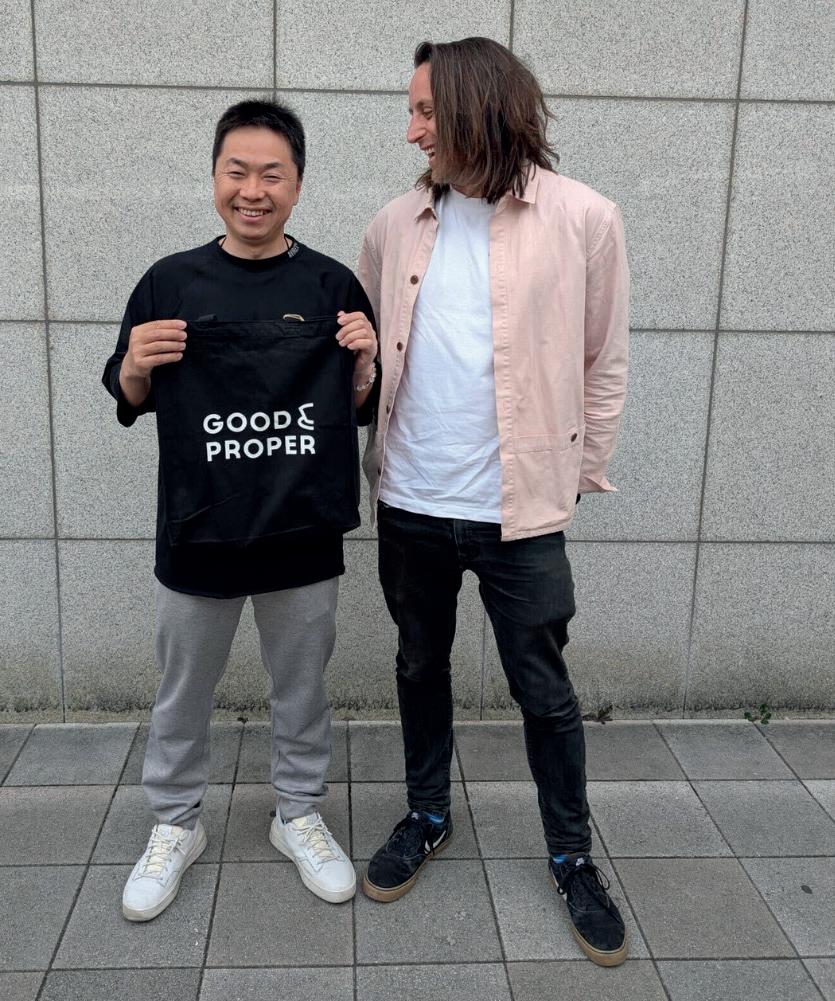
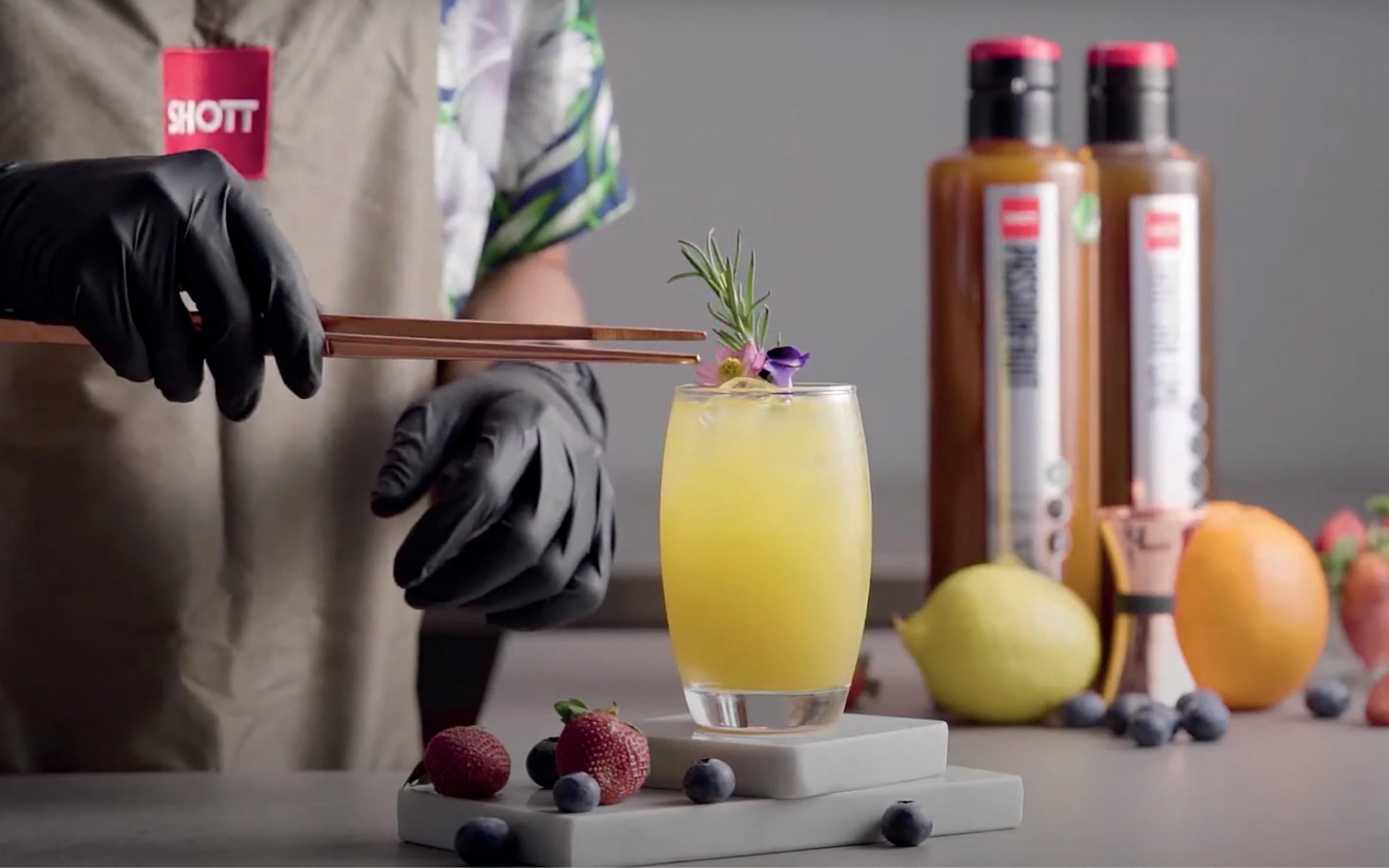
SHOTT Beverages has been supporting businesses with its highly concentrated, natural syrups and seasonal recipe collections for over 50 years.
When running a coffee shop business, the whole working day is a profit opportunity waiting to happen.
Customers used to look for coffee with milk in the AM and black teas in the afternoon, but it is no longer about traditional beverages consumed during predictable peaks and troughs in trade – everything has changed.
To succeed, operators need to cater for a multitude of palates seeking new experiences, appeal to all generations, and fill those around-the-clock trading gaps with alternative drinks and unique flavour pairings that customers want and are happy to pay a premium for.
“We’ve identified gaps in the daypart framework where beverages as a cash cow are underutilised, particularly between 1-5.30pm, when it’s too late for morning coffee and too early for a cheeky Prosecco,” said Louis Dobson, SHOTT Beverages.
Offering interesting drinks, attractively presented, tailored to the needs of that particular daypart and delivered to a consistent standard can really help drive sales.
“Now, it’s all about the experience,” continued Dobson. “We recommend mixing up the menu, incorporating innovative recipes with exciting flavour pairings such as Cranberry & Lime or Black Tea & Peach.
“We also encourage customers to add drink categories not previously considered such as iced, low caffeine and blended. These provide exciting options and can be added to the menu alongside a more traditional offering.”
Fruit coolers made using one pump of SHOTT syrup topped with ice, still or sparkling water and fresh garnish are a fantastic addition, with appeal through the day. “With a single bottle of SHOTT syrup making 33 drinks with no wastage, there’s scope for a lot of profit from this one drink category alone.”
Matcha is also popular, particularly with health-conscious consumers. “It’s a great menu choice because it can be served in so many ways. For example, in iced lattes, lemonades, Frappuccino’s, smoothies, milkshakes or even added to hot chocolate.
“Plus, Matcha pairs with both sweet and savoury taste profiles. Strawberry and raspberry works well and creates a particularly eye-catching opportunity,
while salted caramel delivers a more savoury twist.”
Chai continues to skyrocket, often enjoyed as an alternative to coffee, and again with added flavour profiles such as caramel.
“As a way to keep the menu fresh and entice customers outside of the traditional morning coffee time, we are seeing operators spinning the traditional ‘hot coffee’ to a cold drink variation – iced espresso, iced flat white and iced lattes, often adding a pop of extra syrup flavour or going all out with
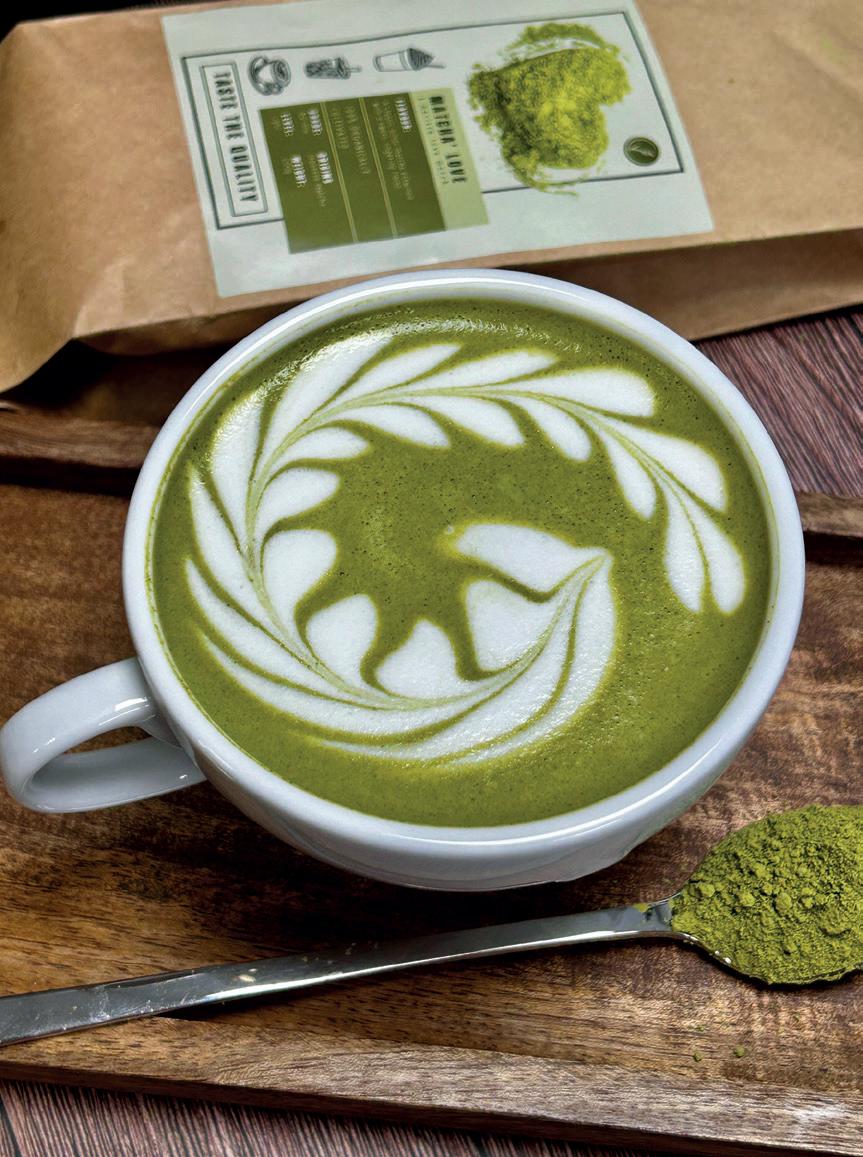
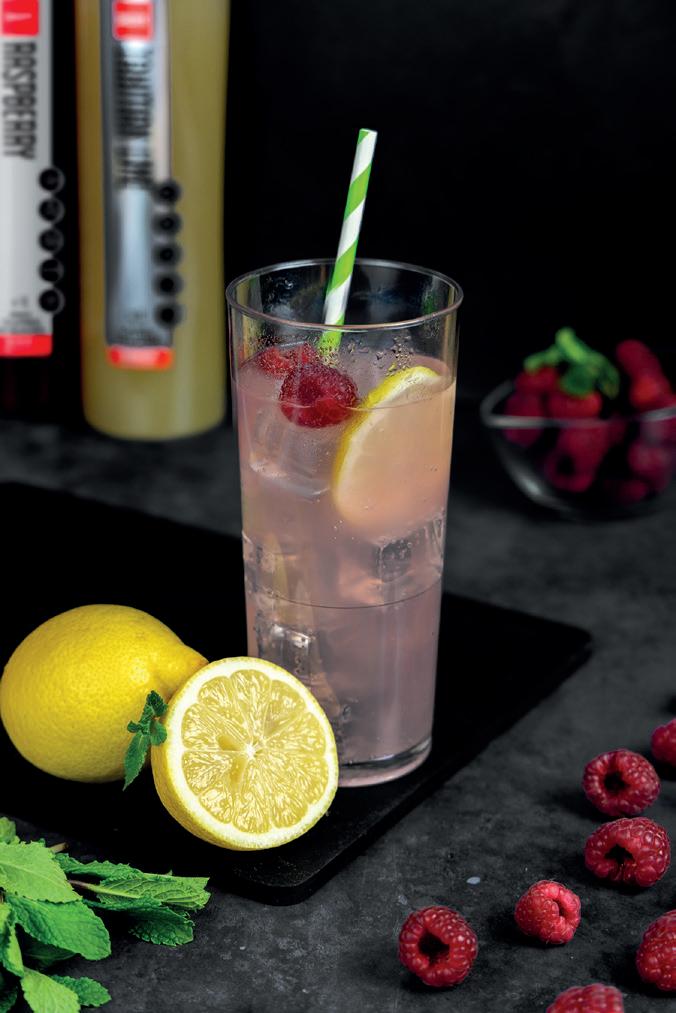
cold foam, whipped cream and sauces.
“Iced chocolate or mixed with cold milk is also trending and another fantastic way to offer customers the adventure and indulgence they are looking for.”
Once customers start to understand how versatile SHOTT syrups are, the scope for experimentation is almost endless and the profit margins impressive.
“Learning how to combine syrups to create innovative pairings can drive sales – particularly with the younger generation. It’s key to really getting the most profit from your menu.”
Customisation is also increasingly important, with premium ‘add-ons’ such as whipped cream, syrups and toppings to build in additional texture, elevating the whole Insta-worthy experience.
“We encourage customers to stock a
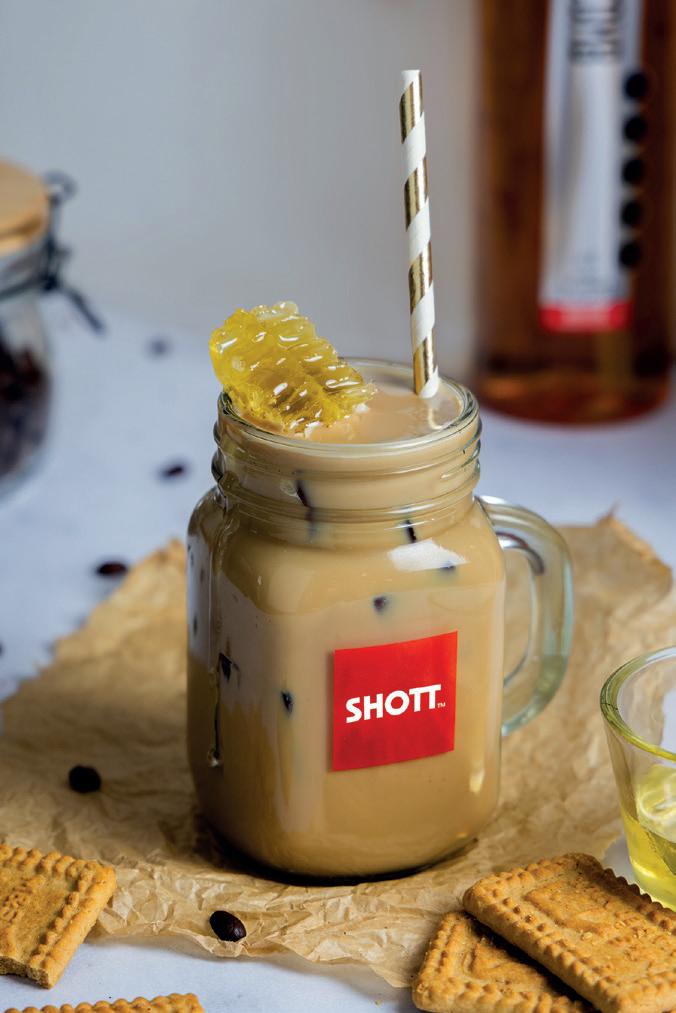
core range of bestselling syrups. These really are back-bar essentials and can be used across the entire hot and cold beverage menu all year round.”
For pairing with coffee, Dobson recommends Caramel; Hazelnut; Salted Caramel; Vanilla and Butterscotch. While top picks for hot chocolate recipes include Flamed Orange, Wild Peppermint and Coconut.
“We offer over 60 flavours, so there’s scope to create fabulous seasonal recipes and signature drinks. One example is a trend for floral notes, with an increasing demand for SHOTT Rose syrup, which adds a subtly sweet twist to cocktails, mocktails and sodas.
“Add to hot drinks – such as chai, hot chocolate, coffee and bubble tea – to evoke the sweet, indulgent taste of Turkish delight, making each sip a fragrant, luxurious experience. Customers can also subscribe to our seasonal recipe collections for added inspiration.”

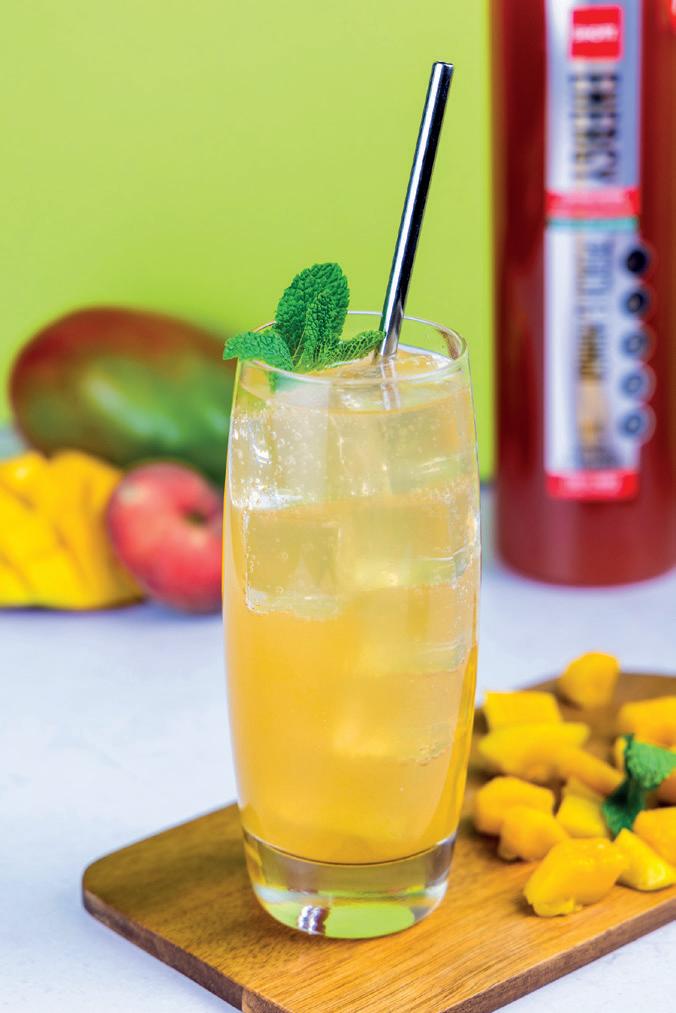
“Serving hand-crafted drinks to a consistent taste can pose a challenge when operators have multiple choices on the menu, each with a different recipe,” explained Dobson.
To overcome this, SHOTT offers a Serve Station system with interchangeable concentrates, all formulated to the same 9:1 concentration. This drives up consistency, making it easy to serve delicious drinks every time.
“Our fail-safe system allows staff to recreate every recipe with 100% accuracy and minimal margin for error. So, whether using our syrups in frappes or coffees, even inexperienced staff can deliver a delicious pour, which really is the key to success.”
The SHOTT range is distributed in the UK by Miko Coffee, complementing the company’s extensive selection of speciality coffees, artisan teas, Japanese Matcha, SHOTT syrups and beverage-making equipment for coffee shop operators.
For more info, visit shottbeverages.com.



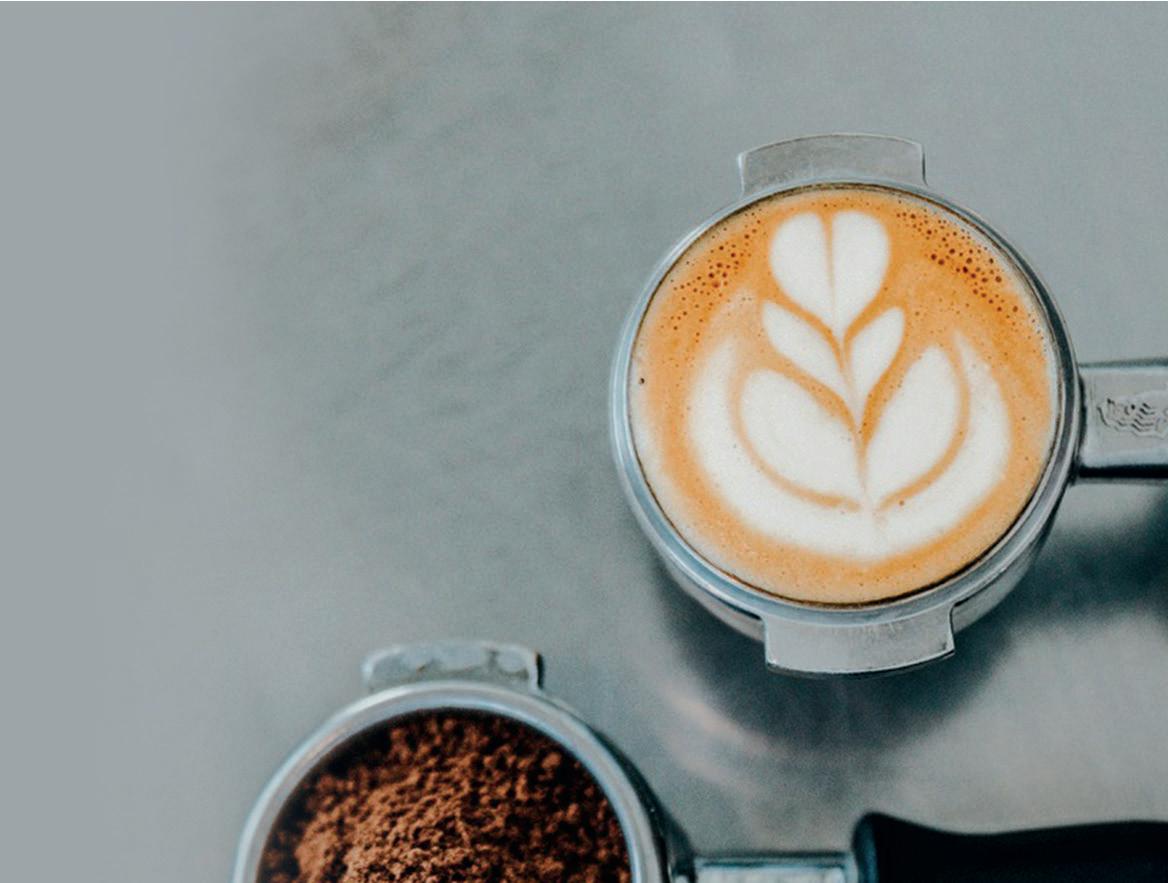
If you’re starting a co ee bar, your communication strategy needs to be well-planned. Ruth Wilson PR looks at the main factors to consider.
The hospitality sector has been under pressure for years now, so launching a co ee bar or any kind of café is a brave move – but done correctly, it’s still viable and exciting.
According to research by ITV, 63% of us drink co ee regularly. To keep us sated, there are well over 12,000 independent co ee shops across the UK. The market was valued at around £4.6 billion in 2024 and sales in this sector are currently rising at 4.1%*. Younger generations are fuelling the growth, with their preference for customised, convenient co ee on the go – Gen Z are apparently embracing co ee culture from the age of 15**.
Tapping into this popularity could be a very smart move, and the key is to get your brand and messaging right. It’s not just about the variety and
quality of your drinks. In a busy market, you need to stand out.
Create a pro le of your ideal customers and identify how they consume and shop. Focus groups and research are key – look at competitors to see what they’re getting right and wrong. The ideal situation will be to have a schedule of customers: early morning exercisers, commuters, workers, leisure drinkers, parents, students, etc. These people are all looking for something slightly di erent from their experience with you.

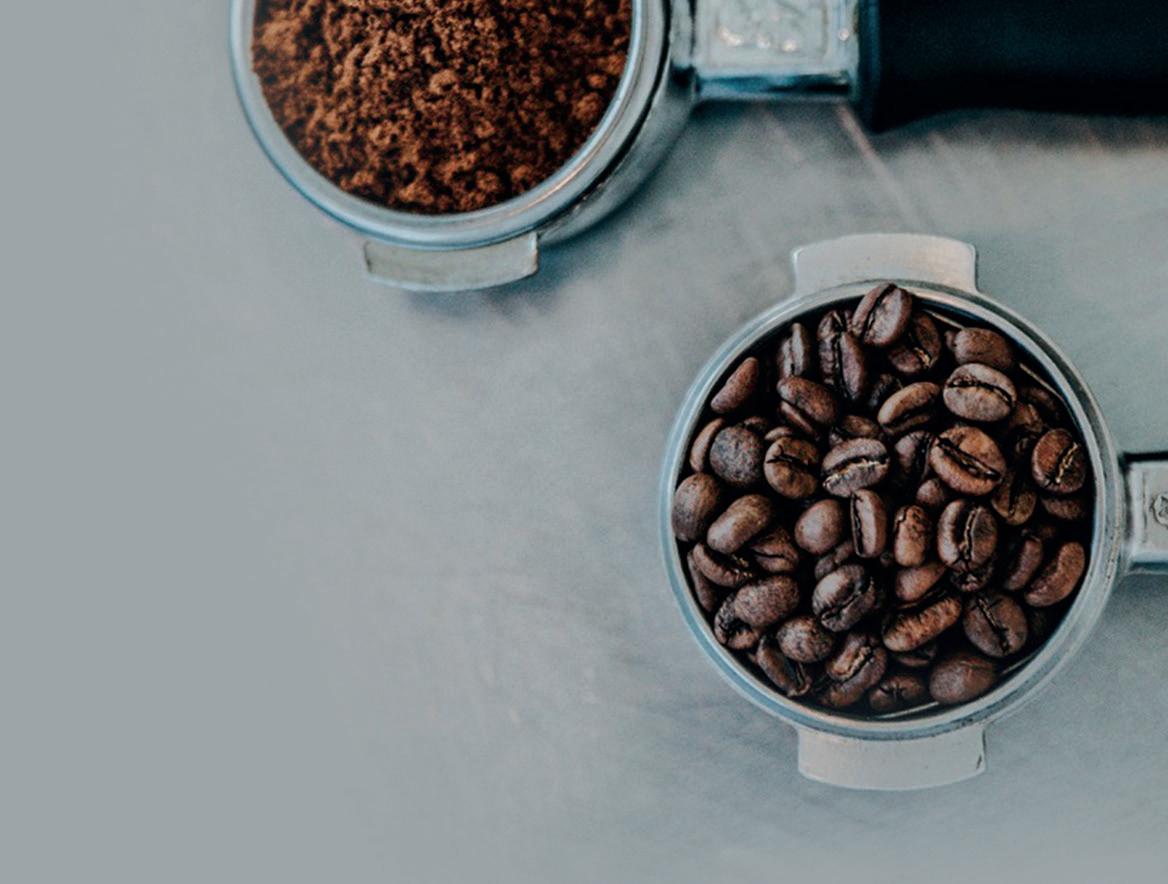
value proposition: it encompasses the style of décor, attitudes of sta , your atmosphere, service, tone of voice and mission statement – a sentence or two encapsulating what you want to provide.
This will start to develop once you know your audience and o ering. Branding is not just a name. It’s your
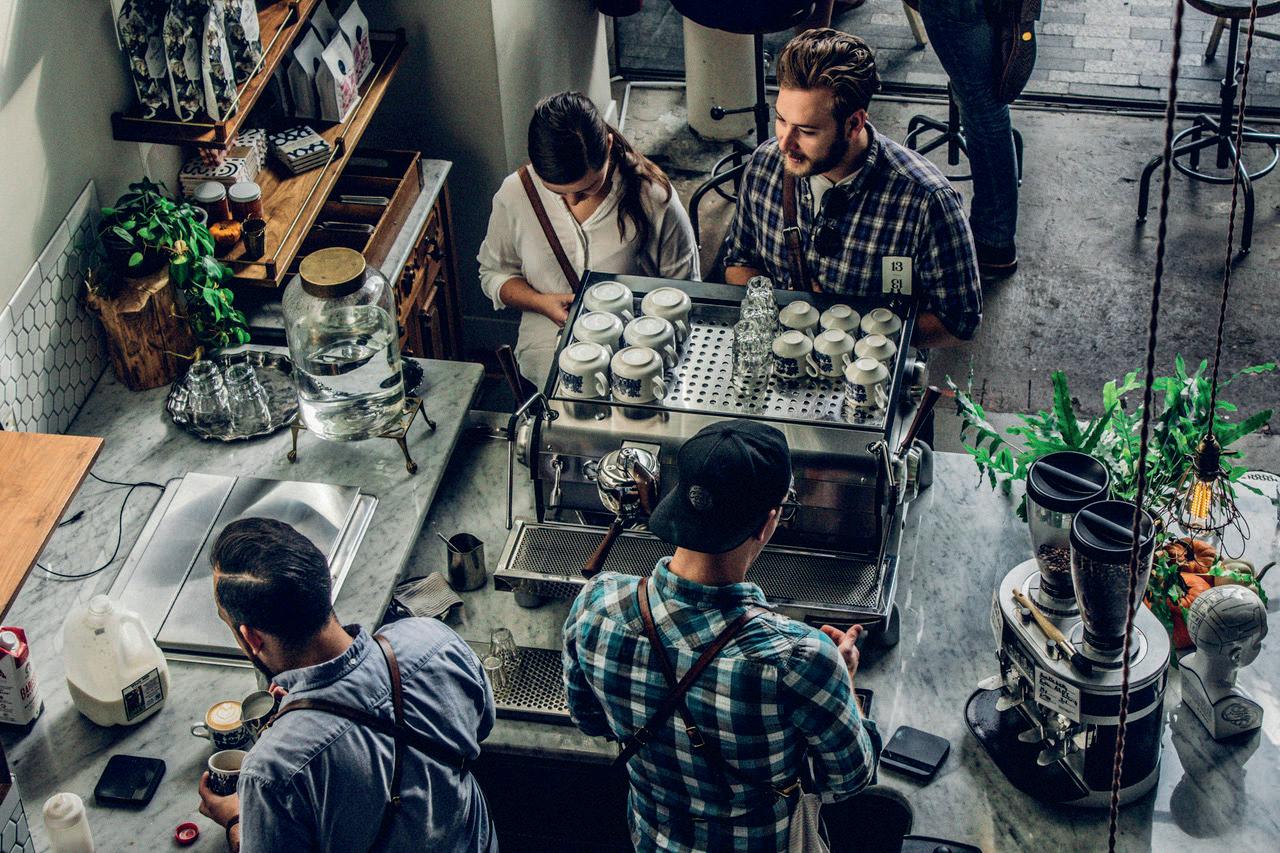


What are you o ering that sets you apart? Within ve miles of my home there are well over 20 co ee shops. One is Moroccan, one is dedicated to the founder’s grandmother. One is US-themed, one is health and wellness focused. One is all about gaming, one focuses on local suppliers, a few are chains. They all genuinely o er something a little bit di erent. This is tied up in the brand, which needs to be carefully decided up front. It’s a good idea to create mood boards and a brand book to ensure you stay on track once everything has been created, to encourage consistency.
Once the brand is set and your business plan is ready, the marketing starts (before opening). There are several routes to your audience.

"tiktok can share your personality and let your team shine with fun and relevant video content."
Facebook is great for creating local campaigns targeting speci c groups. Instagram provides the perfect place to establish your aesthetic, and you can nd local content creators to share your message to a wider audience, driving footfall via recommendations and special o ers. TikTok can share your personality and let your team shine with fun and relevant video content, and LinkedIn connects you to local businesses with whom you can cross-market and potentially cater for. It can become all-consuming, so it’s sensible to have someone manage social media to ensure content is working and that you are engaging with the right people at the right time.
Local media is still very trusted and is a vital tool in communicating key messages to a wider audience, getting third party endorsement through
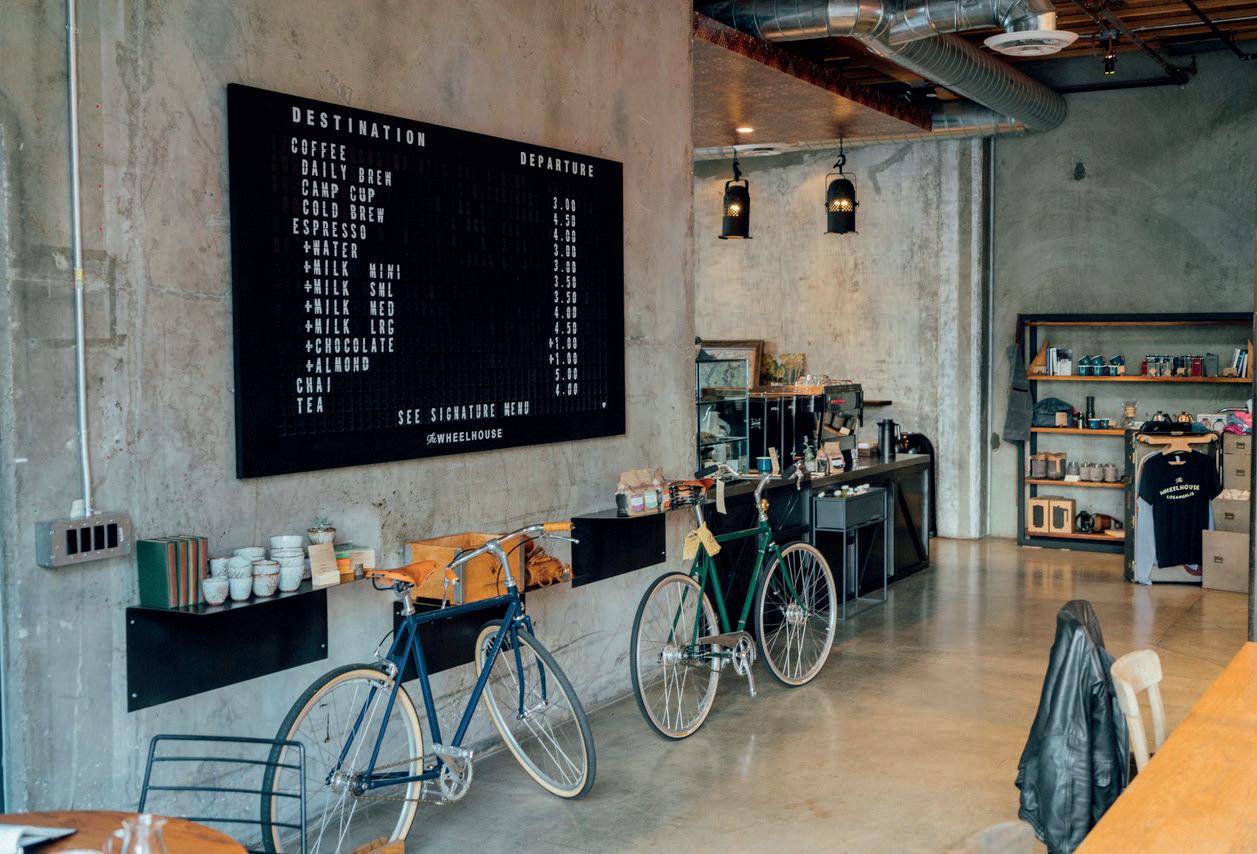
broadcast, print, online and social. Inviting local journalists for a venue preview is a rst step. Share your journey and exclusive imagery. Create a plan of positive stories: sta news, growth plans. Consider competitions and sponsoring local community groups and clubs – as well as promoting your brand directly, these activities become news stories. A common mistake is to go all out on PR at launch, then step back once becoming established –but PR is about ongoing reputation management, so should always be factored into marketing.
Hosting events can build even closer relationships. Art groups, book clubs, craft sessions and lm nights attract
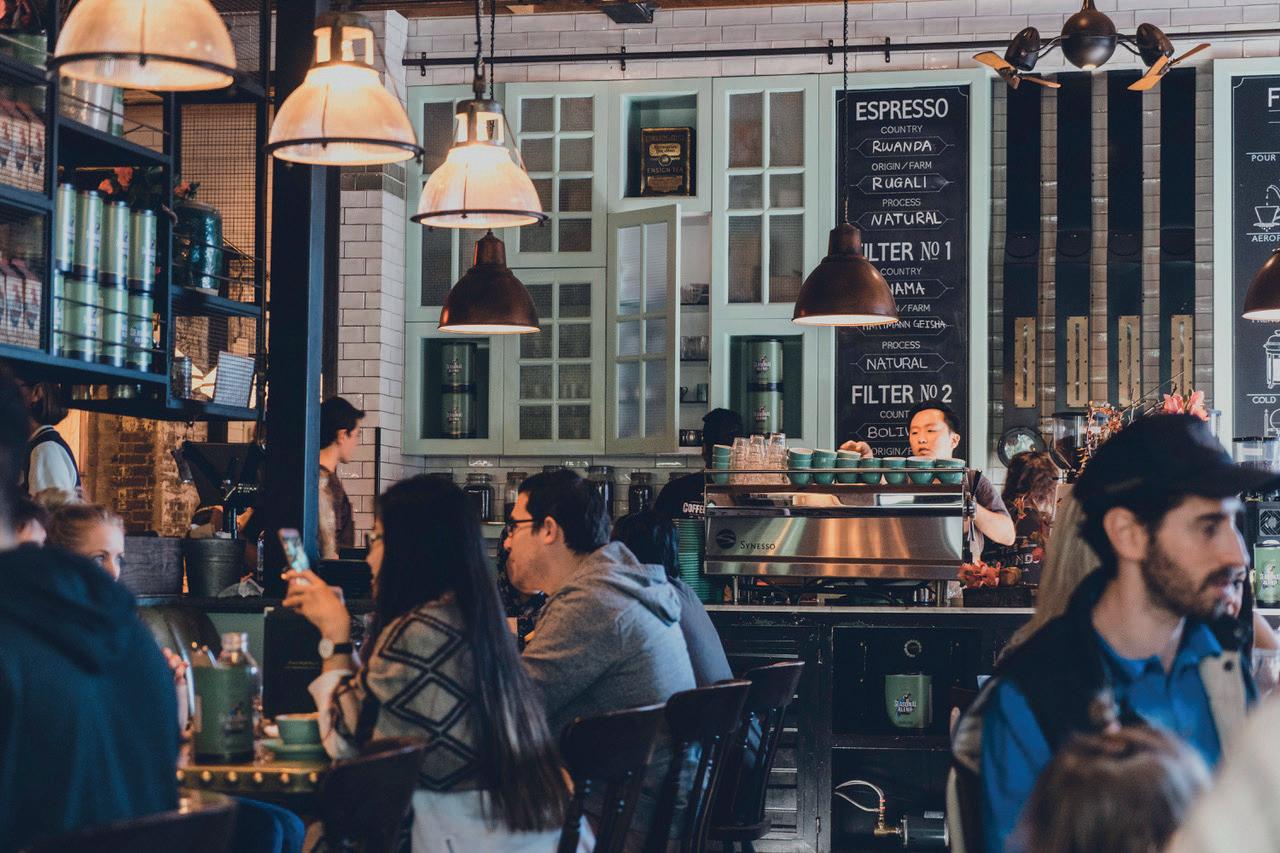
new people during quieter hours. Consider getting involved in other people’s events too: a pop-up catering arm could add to your income, as well as promote your brand to an even wider audience – and of course all of these are social media content and positive news stories to share. A co ee shop is more than a venue that serves drinks. It’s a social hub, a place for connection and community. It o ers a place to work, meet and relax – and for many, a vital part of a routine. By creating a strong proposition, your co ee shop can take advantage of this. Products, location, sta and atmosphere are all key. But once you have invested in those, communicating is just as important. Investing in branding and marketing should be top of the list for your business journey.
*World Co ee Portal. **GourmetPro.
Ruth Wilson is a PR consultant operating in the food & drink sector. With over 20 years of experience as a journalist and marketing professional, she has formulated and managed communications programmes for some of the UK’s biggest brands – as well as startups and small businesses.
Visit ruthwilsonpr.co.uk
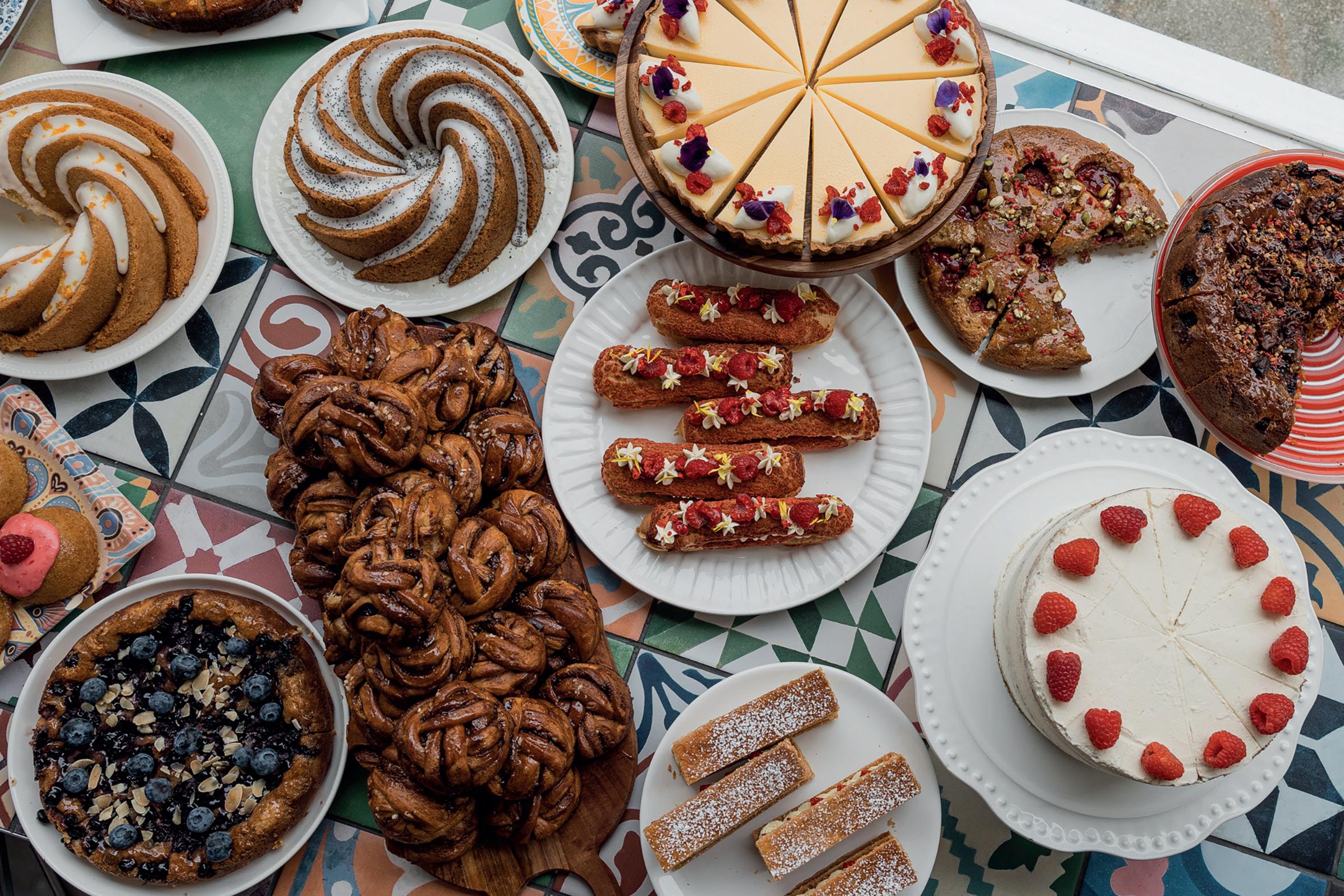
There’s a new operator in Scotland reaching incredible heights of creativity and flair –congratulations to Ems & Co, where innovation is always on the menu.
CUSTOMER RAPPORT
Ems & Co. Pastry Shop is a prime example of one individual following her passion to open a new business, taking on the big guns and establishing a niche offering in an incredibly competitive sector.
Emily Black was the former head pastry chef of the five-star Cromlix Hotel in Stirling, Scotland. She opened
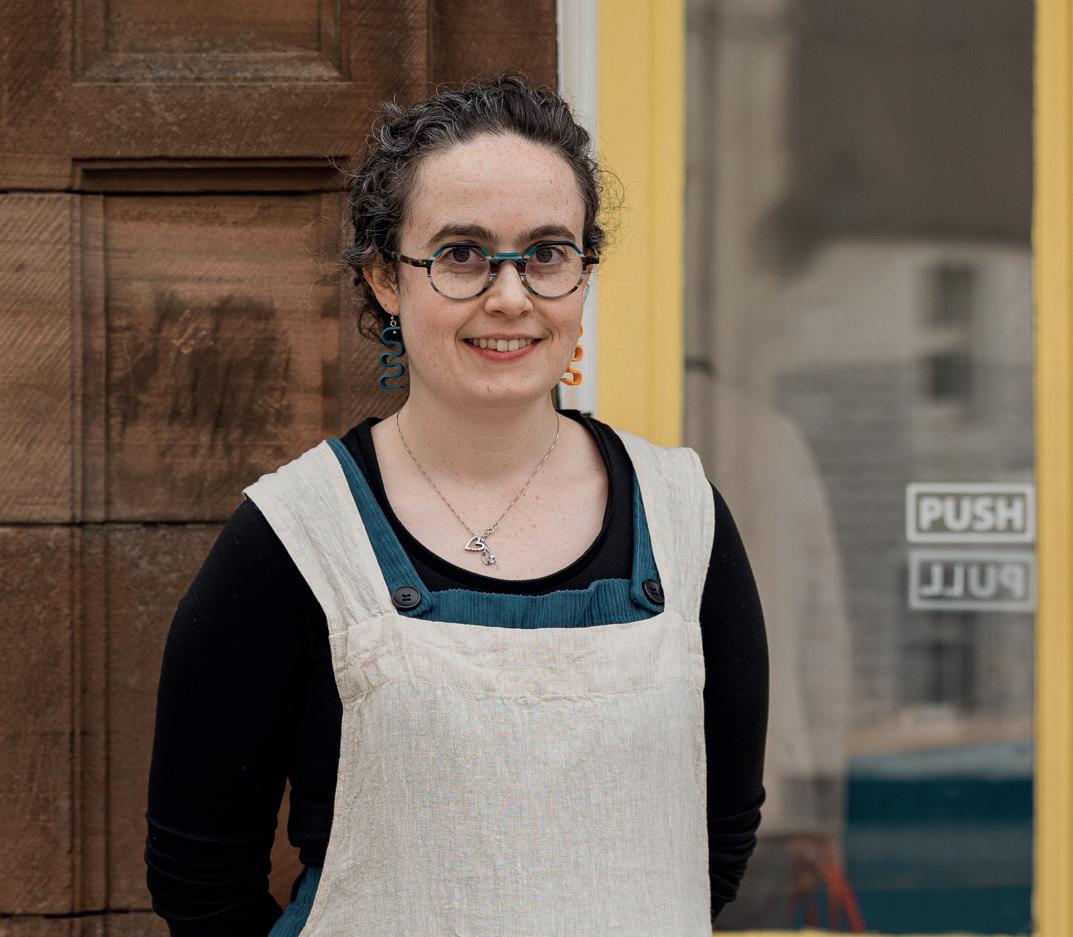
Ems & Co. in March this year and is thriving, with a new residence in the heart of Crieff, Perth.
What was originally the Spence Art Gallery on King Street, she is welcoming customers to her scratch bakery. It’s bursting with creativity, international flavours and seasonal ingredients, with stunning recipe ideas the heartbeat of the operation.
“I’ve always loved cooking and baking, and after working in a few different hospitality settings, I’ve found that I’m most happy making affordable, homemade food,” said Black. “Creating rapport with regular customers and therefore building a sense of community is one of the most rewarding aspects of running the pastry shop.”
Delectable offerings include Turkish Lahmas, soft fluffy dough filled with a variety of flavours including bacon jam and cheese, or Pain Suisse, a cross-laminated croissant pastry stuffed
with combinations such as vanilla custard and Valrhona chocolate. And let’s not forget the Choux section, from Paris-Brest to Scottish raspberry and mahleb eclairs.
Freshly baked focaccia and flatbreads, tarts, sponge cakes and signature cinnamon knotted buns also feature daily.
“Demand for high quality, affordable
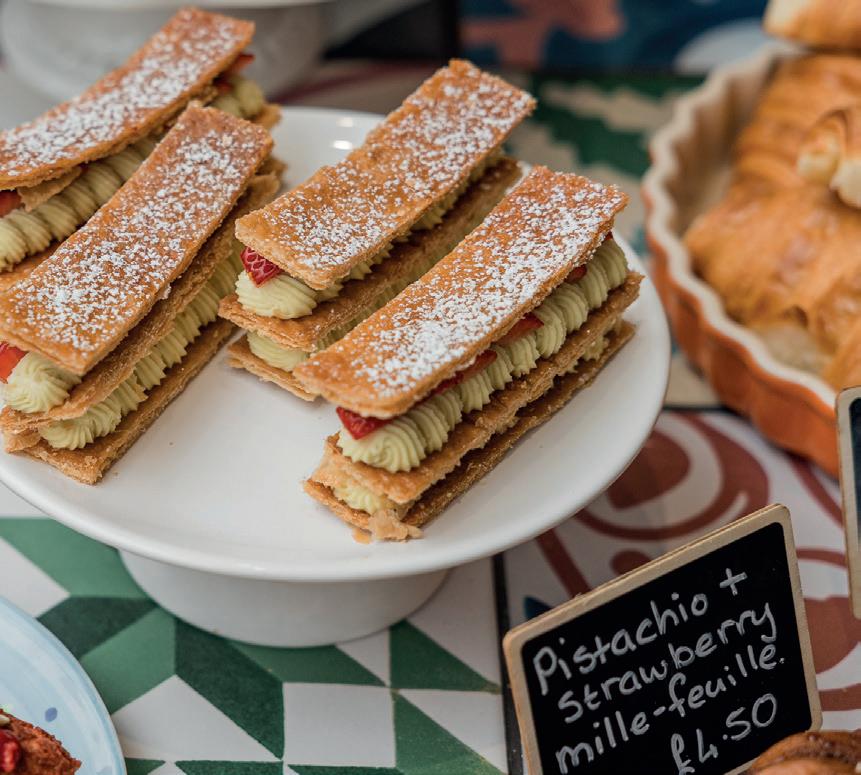

food is very high. Also, people are adventurous in what they eat if you can explain an item’s origin and why flavours pair well together. I’d say people are much more interested in global flavours than they were a few years ago.”
A secret of success is the food quality. “We strive to use high-end ingredients in an economically viable way to make the best pastries and cakes that we can. From utilising the best seasonal fruit and vegetables from our local greengrocer to Valrhona chocolate across the counter, or authentic Mallorcan Sobrasada, quality is critical.
“Our corner shop has a three-metre window display filled with an eclectic, internationally inspired mix of 30-45 different cakes. Step inside and you find our savoury counter with another 10-15 items. We bake everything every day and like to keep the choices varied, so no matter your mood, you can find something you fancy.”
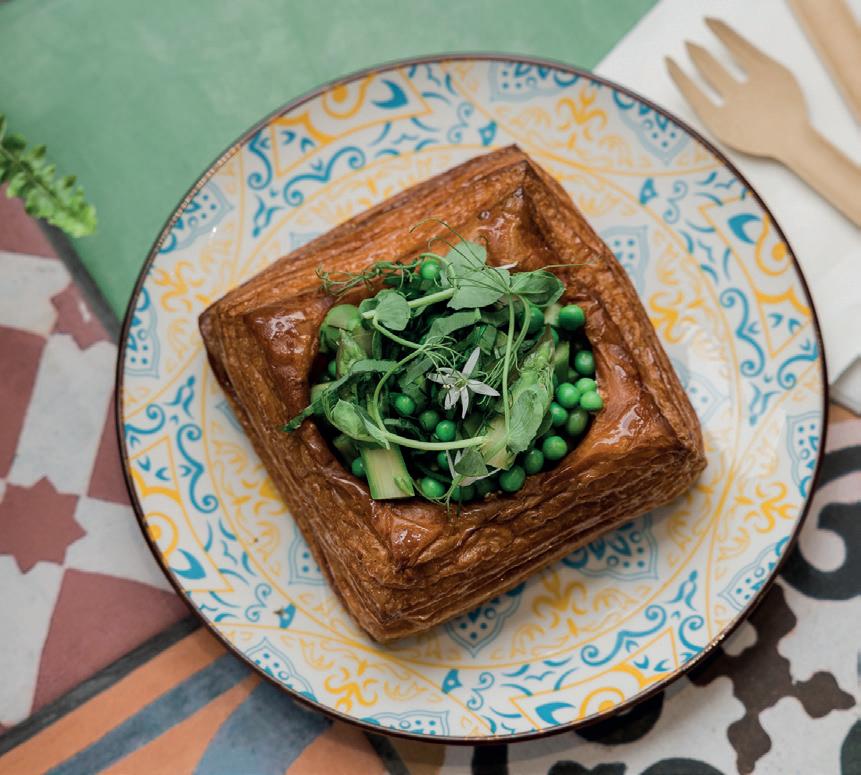
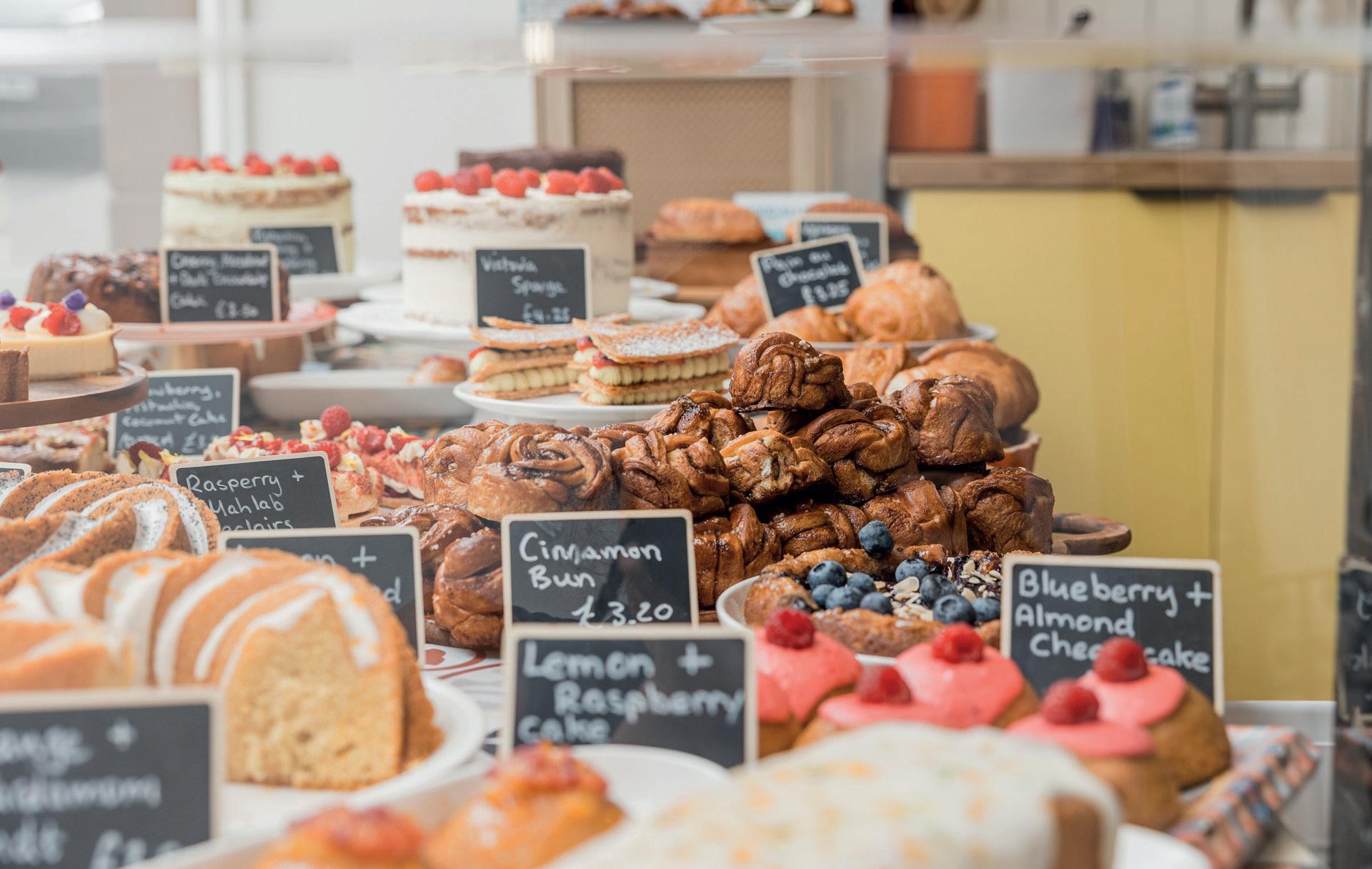
In terms of advice for those looking to enter the sector, Black has some clear directives.
“Try to keep your overheads as low as possible when you first open. Make sure your product is unique in your location and fits in the gap of what competitors are offering. If you’re high quality, different and you can identify that gap in the market, people will come. And never compromise on the quality of what you’re producing – even the simplest of products can become bestsellers if they’re done to a high standard.
“We rely on buying the best ingredients we can, serving them in a simple takeaway format, with a tiny team of three – which keeps the wage bill down. In addition, we really work to minimise wastage, so the money we
pour into those elements is worth it.
“While the cost of living is very high, we hope that, for some, our products are an affordable luxury. If you’re celebrating, perhaps a few slices of cake or pastries from the shop are more affordable than a meal out, but still a treat.”
As for the future, the shop has been pretty busy since opening, so Black’s partner, Andrew, is coming to work in the shop full time.
“He brings with him over 20 years’ experience as a chef (10 as a head chef) almost exclusively in fine dining. Our offering is sure to become more creative, and between the two of us we are also expanding into private dining events and catering. We aim to keep our operation small, high quality and creative,” concluded Black.
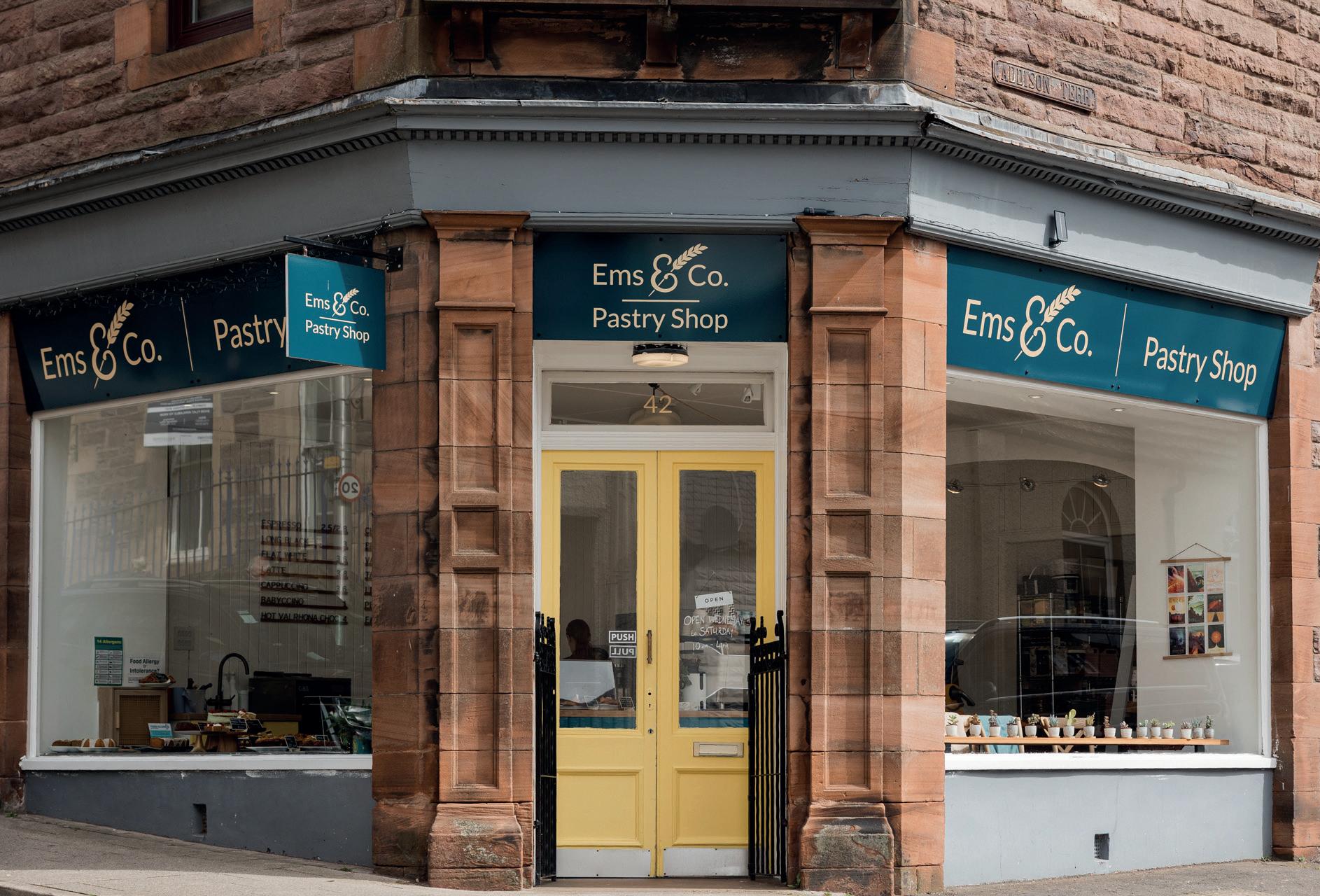
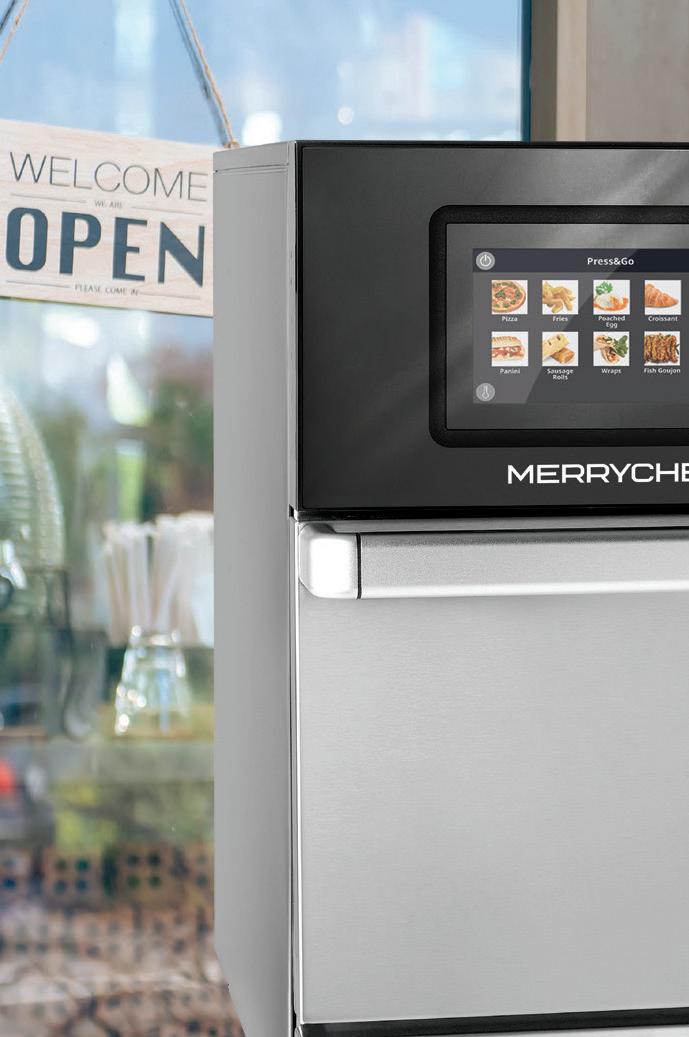



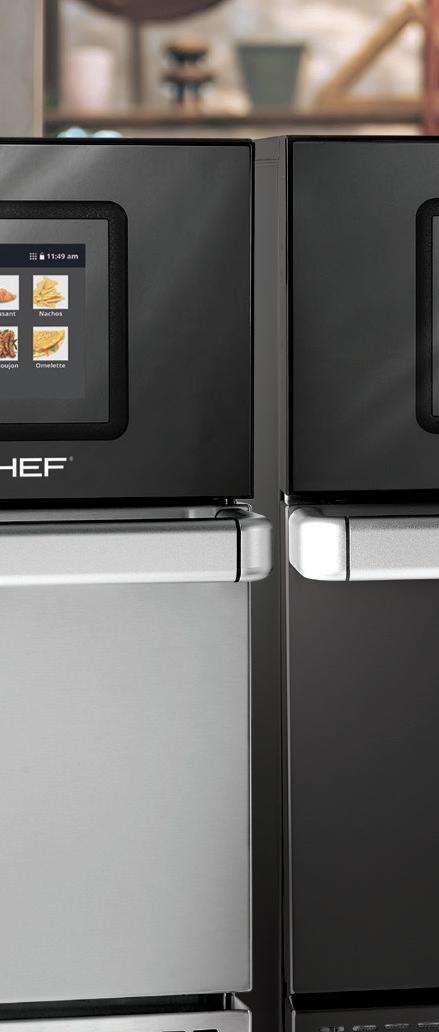

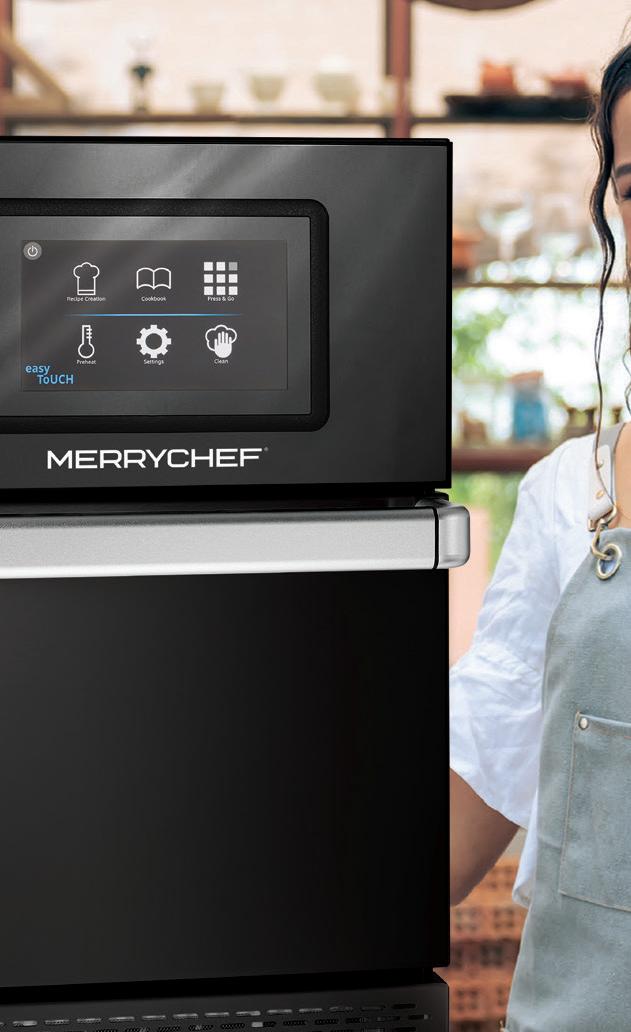




Want to serve up a hot, tasty dish at any time of the day, without the need for a chef or large kitchen?
Whether offering hot food for the first time, or expanding your menu, the Merrychef conneX® 12 high speed oven fits into small spaces and is already fully trained with pre-programmed menus so no need for extra staff. Sitting neatly next to your coffee machine, the multi-talented oven can cook, toast, grill and reheat. Always ready for action, simply select your menu, Press & Go!
